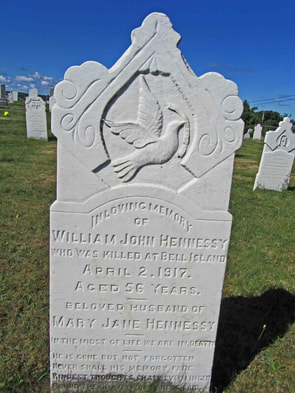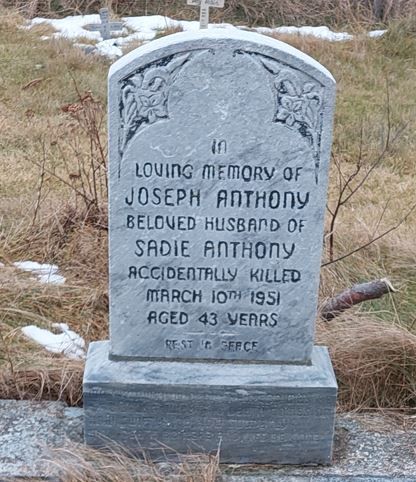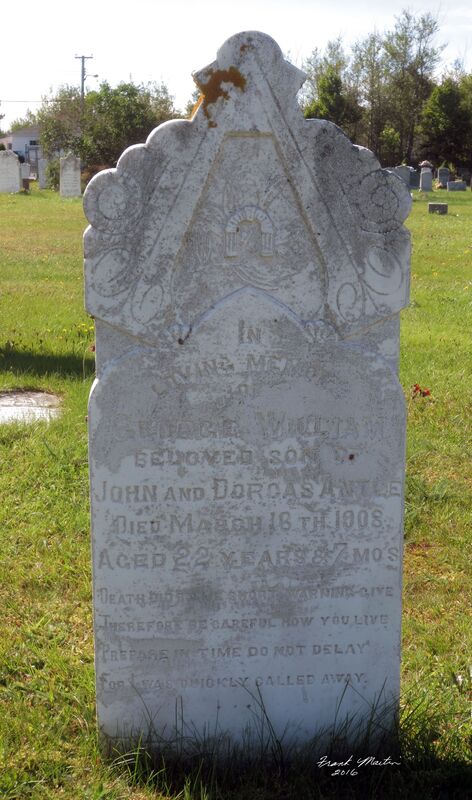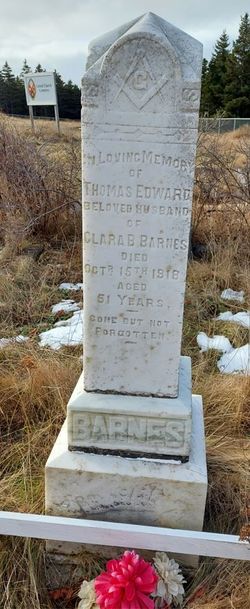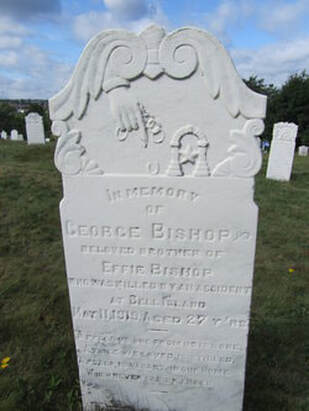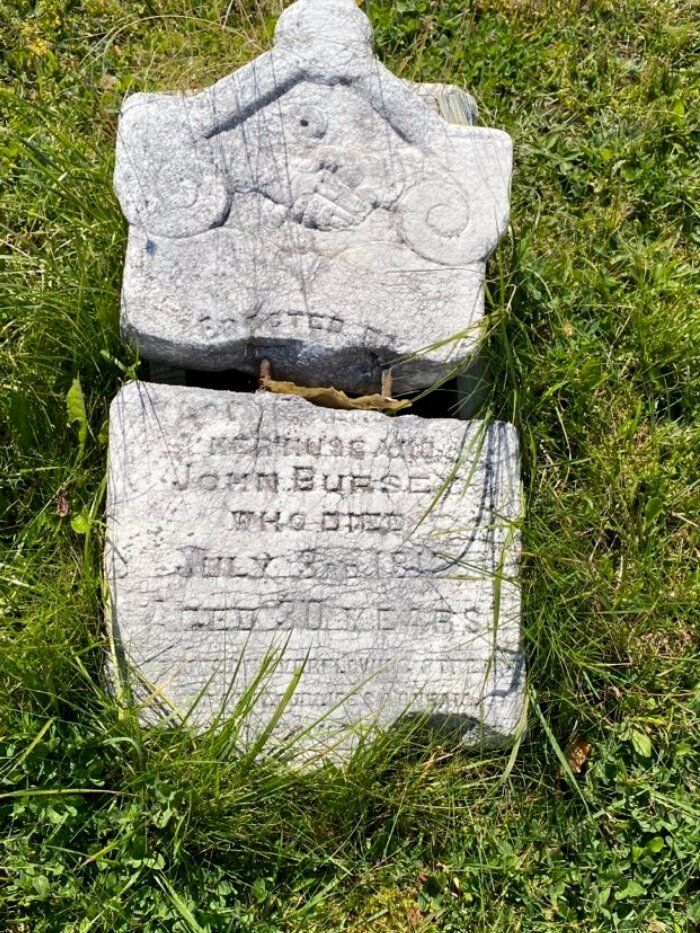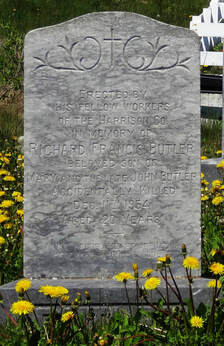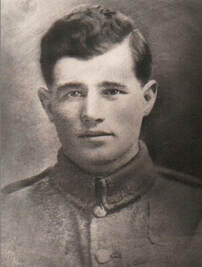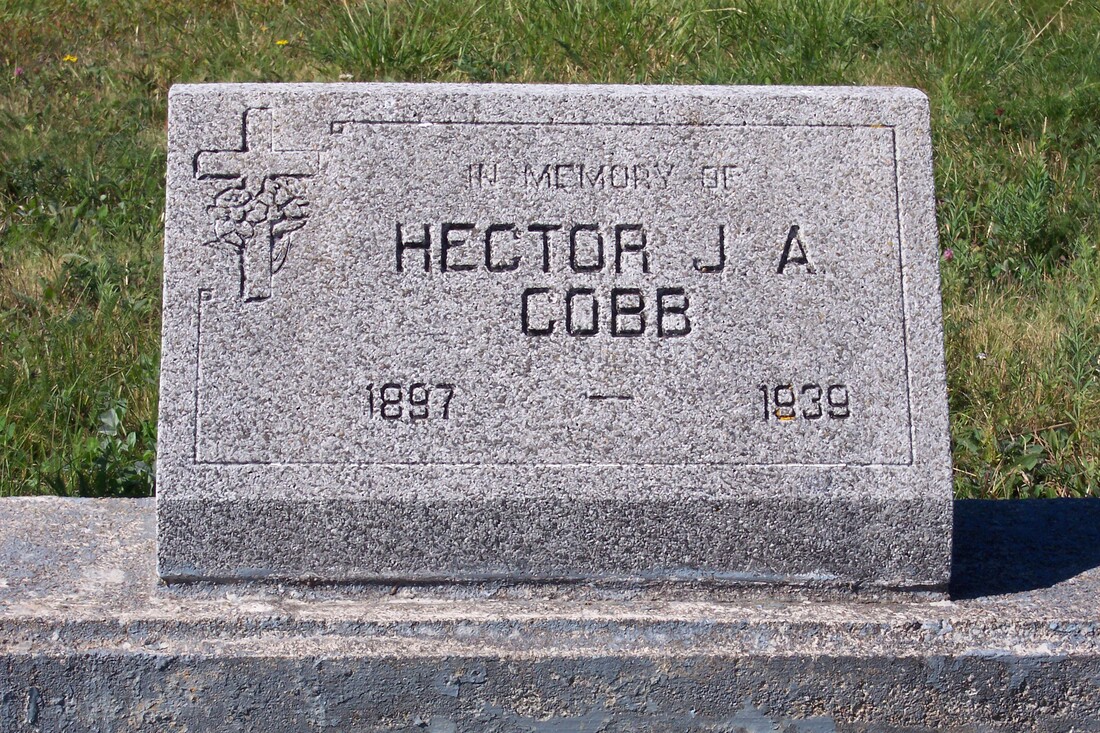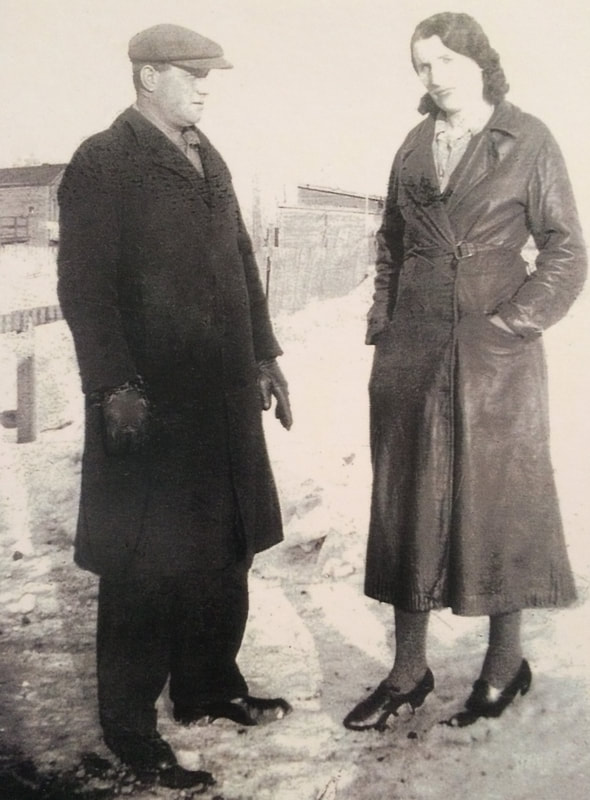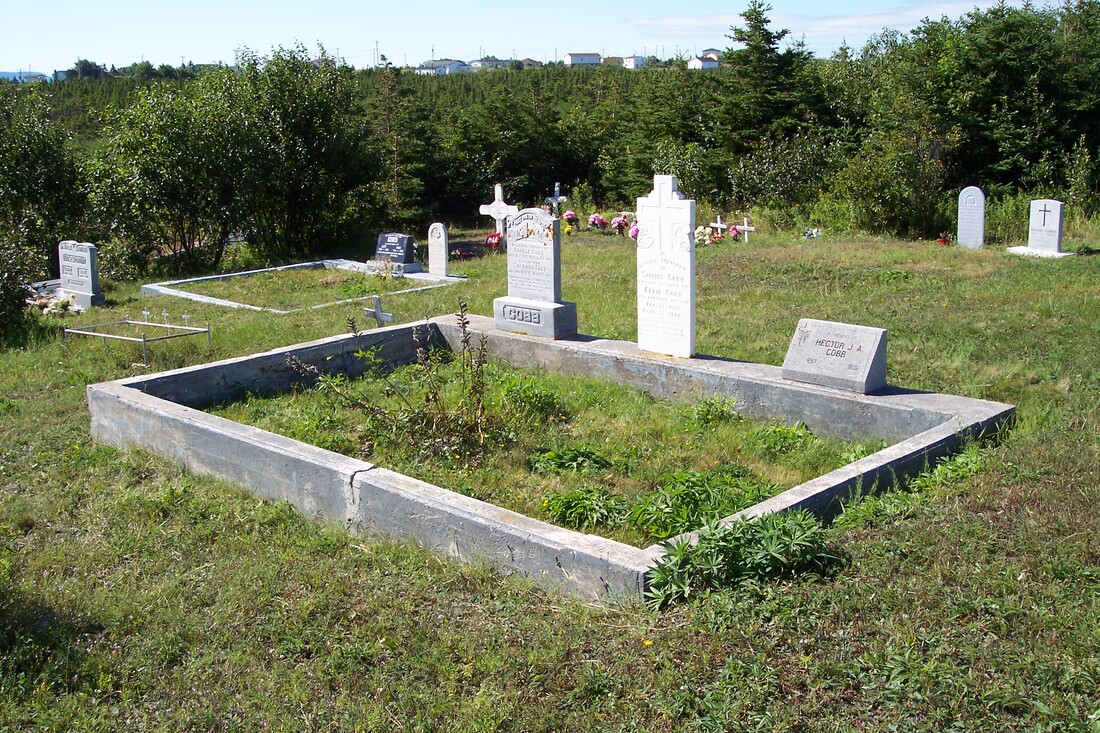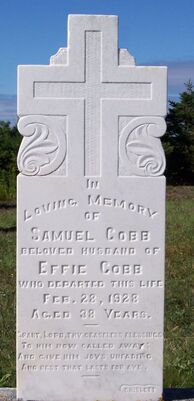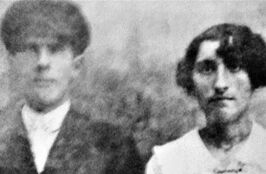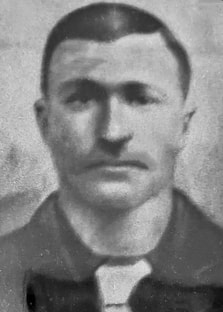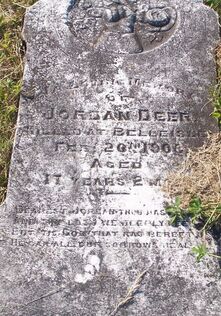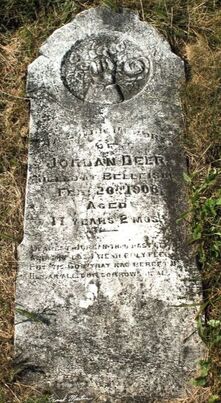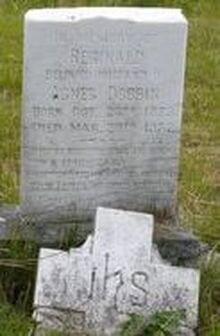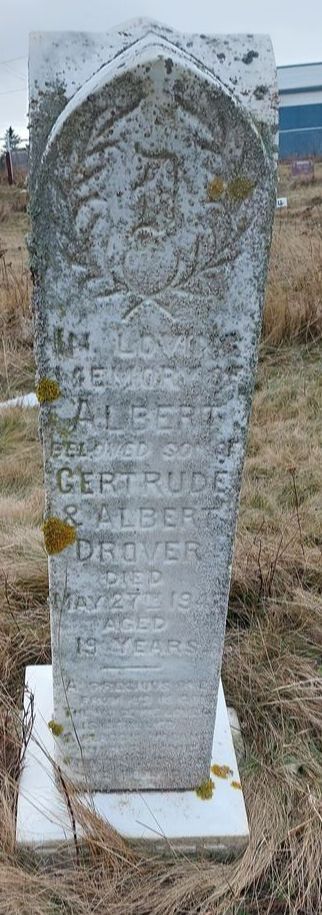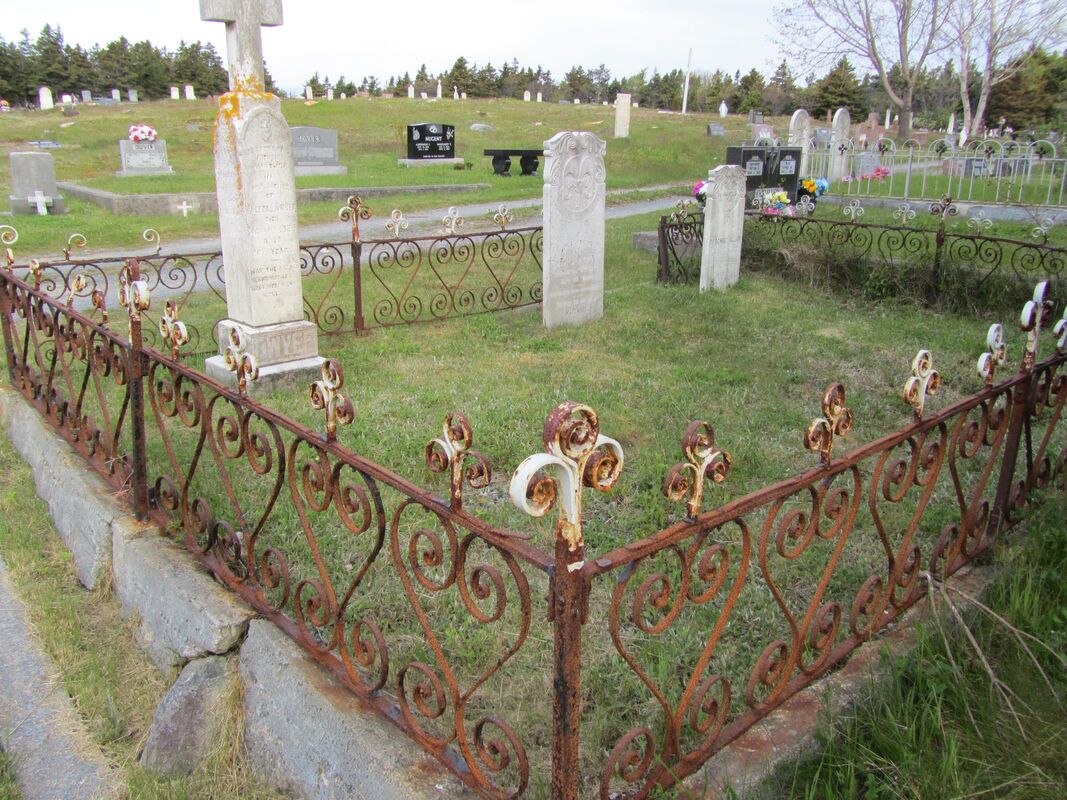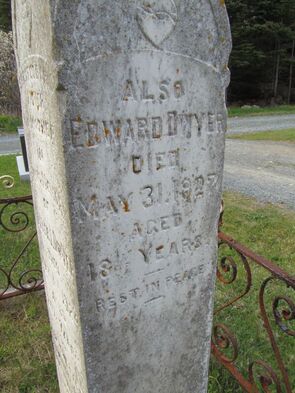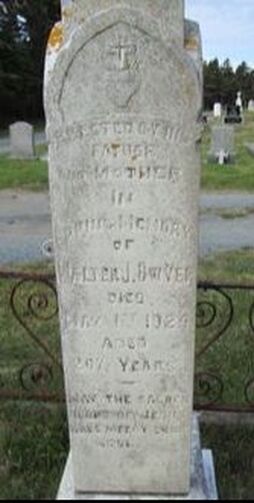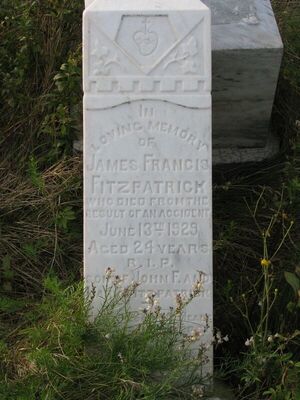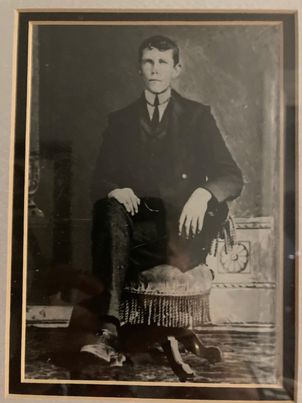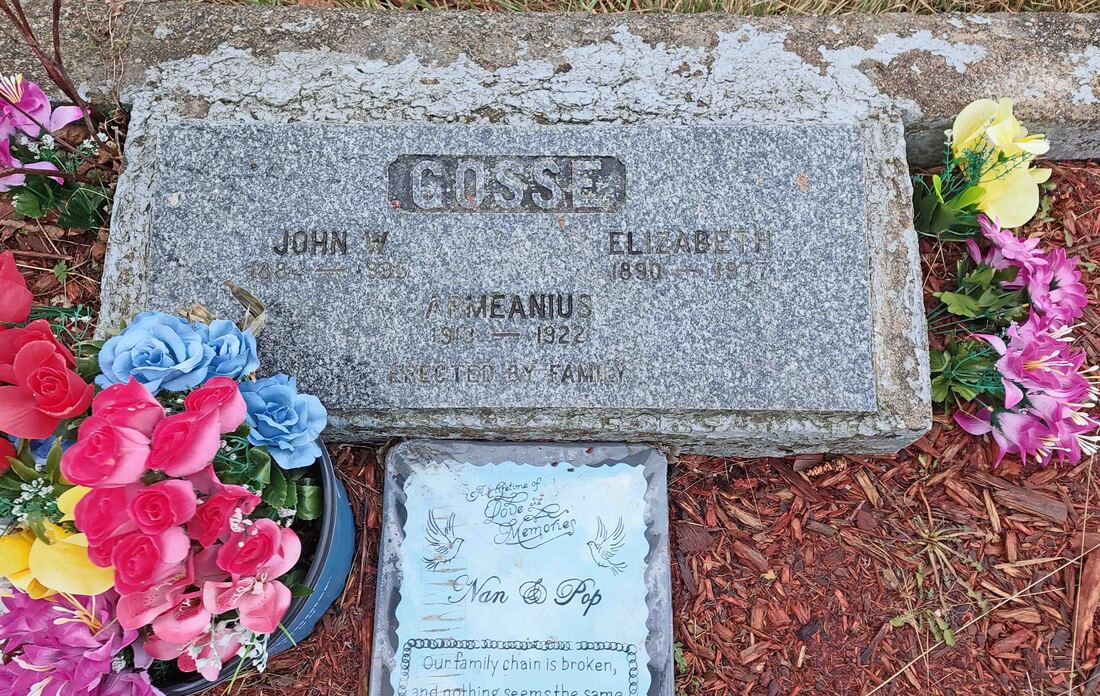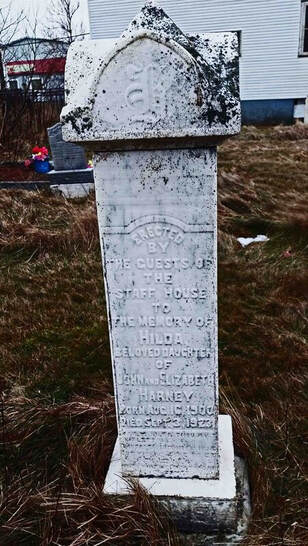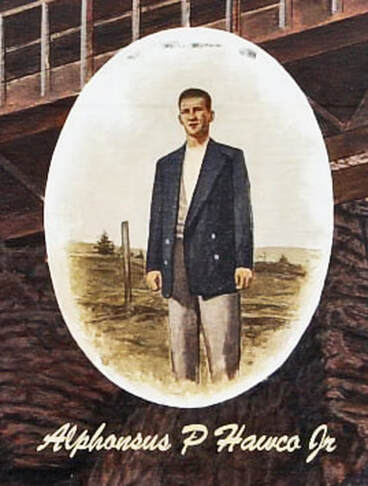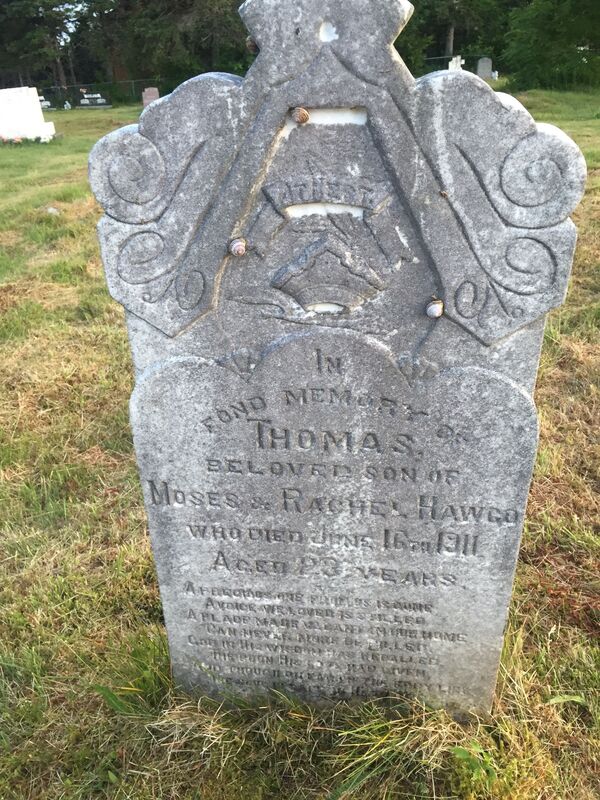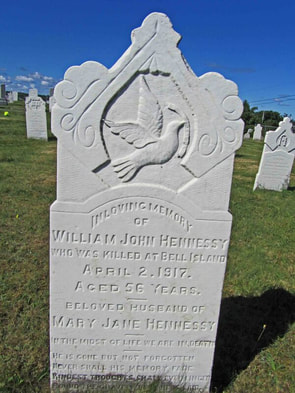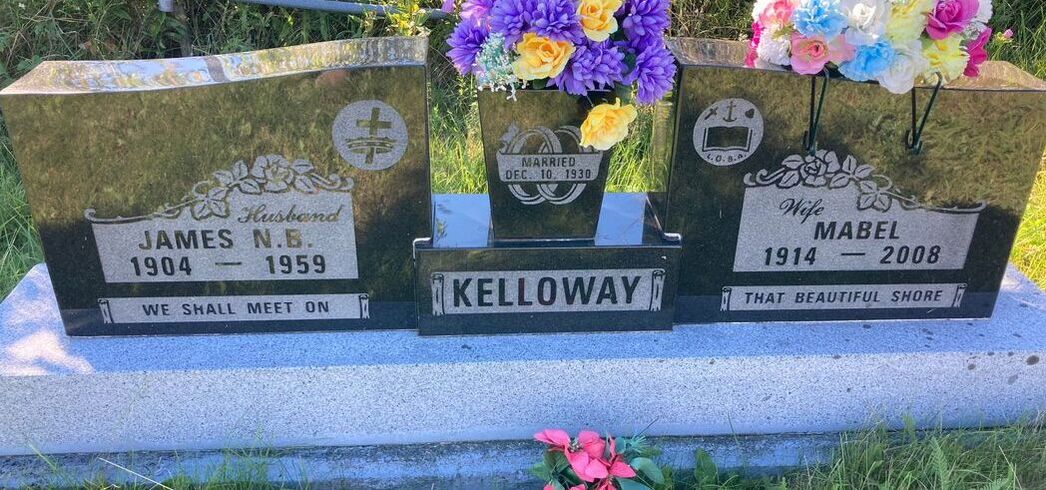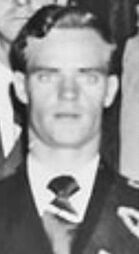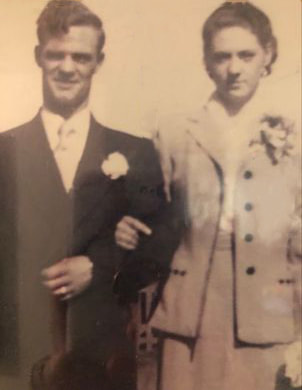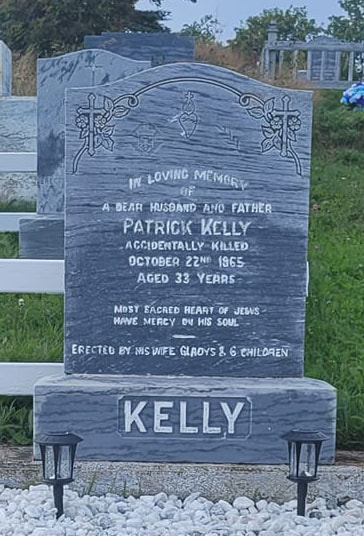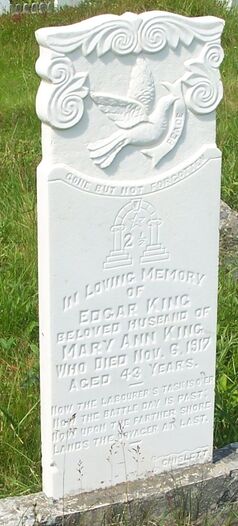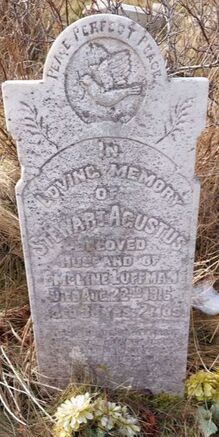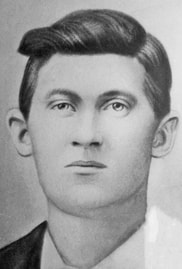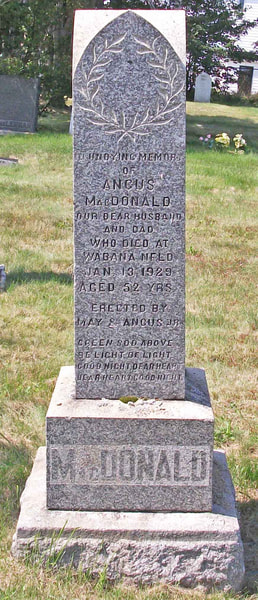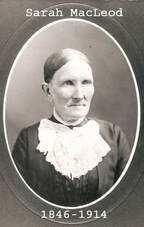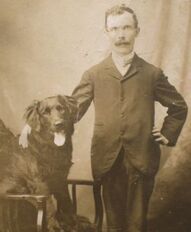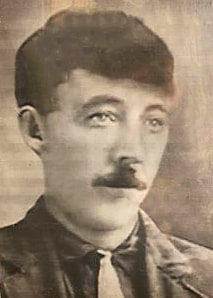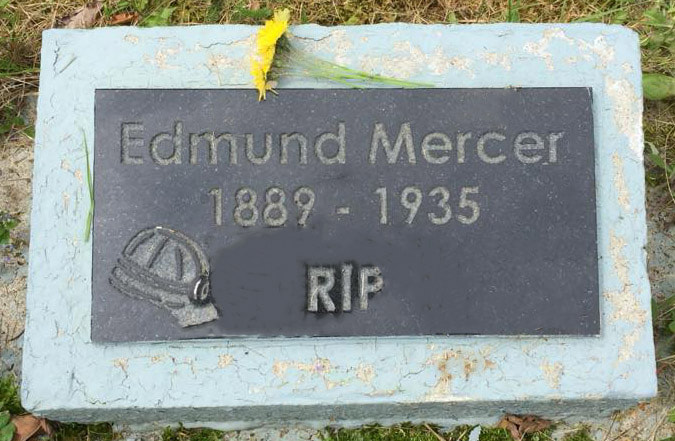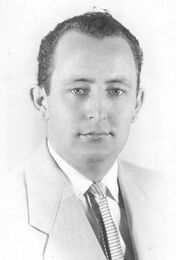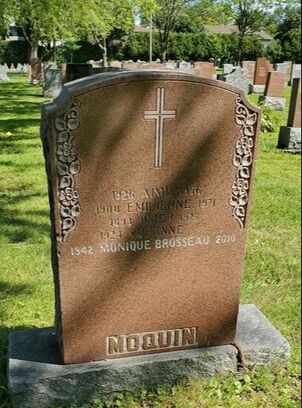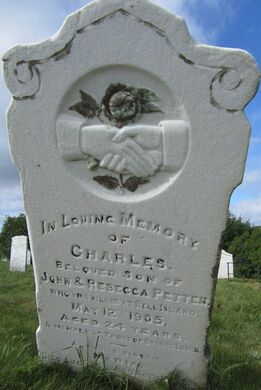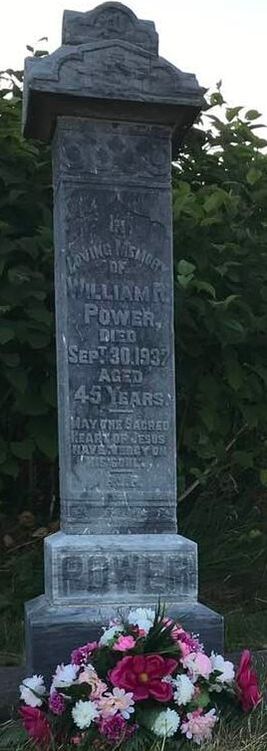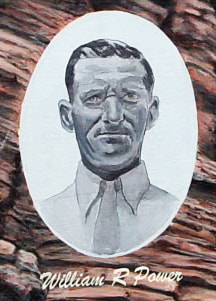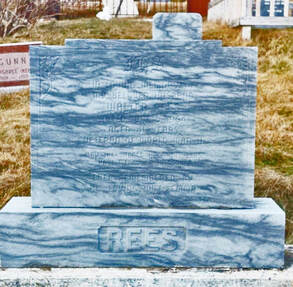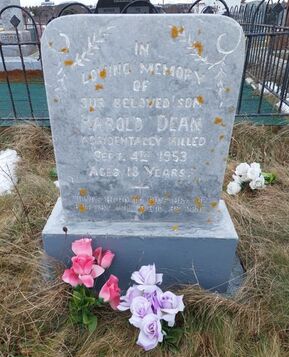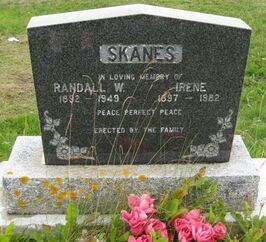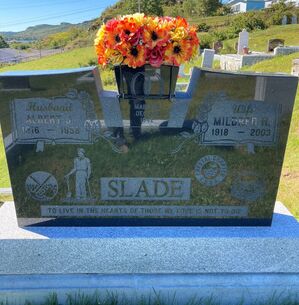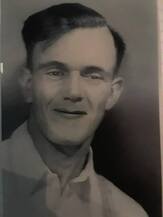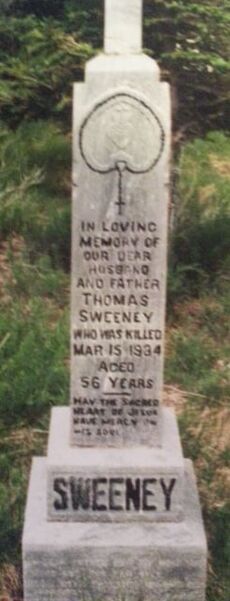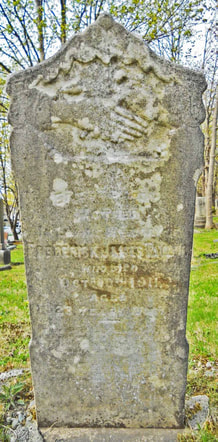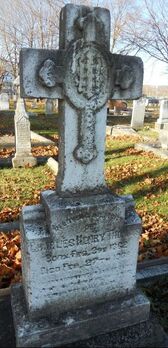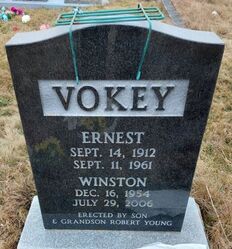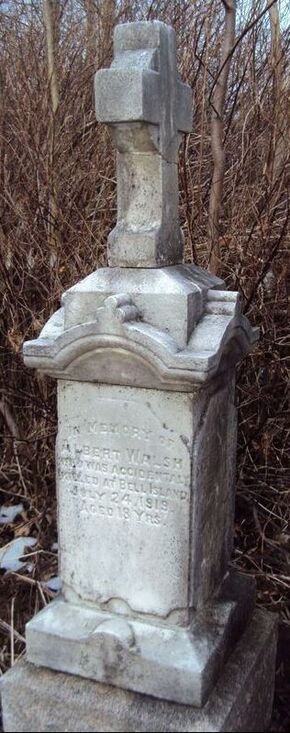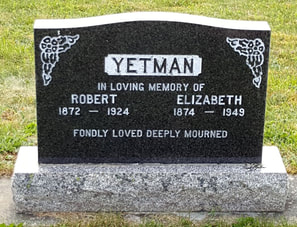HISTORY
MINING HISTORY
FATALITIES RELATED TO MINING
MINING HISTORY
FATALITIES RELATED TO MINING
ACCOUNTS OF EMPLOYEE FATALITIES
IN THE WABANA MINING OPERATION, 1895-1966
by Gail Hussey-Weir
Created February 2023 / Updated August 7, 2023
Headstone in All Saints Anglican Cemetery #2, Conception Bay South, with the sad epitaph
"Killed at Bell Island"
"Killed at Bell Island"
NOTE: The button below will take you to the simple list of employee fatalities. If you know of a mining-related fatality who is not on the list, or if you have a photo to share, either of the person or their headstone, please get in touch by email at [email protected].
The following are people for whom information is lacking. You can read what information I do have for them below, but if you have more specifics, please get in touch at [email protected]:
Edward Power of Casey Street, St. John’s, died about October 13, 1898 from a blasting accident in the Scotia Company’s surface pit: His was the first report found of a mining fatality at Wabana Mines, but no official vital statistics records or headstone have been found.
Herbert Bruce, 18, of Long Harbour, Placentia Bay, died July 28, 1907 from being run over by the stockpile car at No. 2 Slope: Not certain of his first name (may have been Hubert). No official vital statistics records or headstone found.
Isaac Crann, 24, of Trinny Cove, Placentia Bay, NL, died May 5, 1919 from hitting his head in a fall in Dominion No. 3 Slope: No official vital statistics records or headstone found.
Edward Devereaux, 13, of Bell Island, died February 16, 1913 from a scalding accident of February 6th at the Scotia Company’s No. 2 Compressor: No official vital statistics records or headstone found.
John King, 21, of Placentia died July 10, 1909 as a result of an ore car accident at Dominion Pier. Two death records were found for him, one giving his age as 18, the other giving it as 21. Two newspaper accounts give it as 18. I did not find a headstone of birth record for him but, because the death record from his home district says he was 21, I went with that.
Patrick Moriar[i]ty, of Conception Bay North, (believed to have) died March 3, 1908 from a dynamite blast accident of February 29th in Scotia Company’s No. 2 Slope [No. 6 after 1922]: Not certain of first name (may be Bernard) or correct spelling of last name; do not know his age; not sure of home town or where he is buried; not sure of the exact death date. No official vital statistics records or headstone found.
Peter Wade, 30, of Conception Harbour was reported in The Daily News to have died July 10, 1913 at the General Hospital, St. John's from injuries received after being hit by ore cars near Dominion Office [No. 2 Road]. This was briefly mentioned in Bown's "Newspaper History of Bell Island" and appears in Hammond's list of fatalities (It was very likely that Hammond compiled his list from the Bown accounts.), however nothing else was found in any other newspapers and no official vital statistics records were found for a Peter Wade of this age or place. If you can verify that this fatality actually occurred, or even that there was someone named Peter Wade working at Wabana in 1913, please get in touch at the email address above.
The following are people for whom information is lacking. You can read what information I do have for them below, but if you have more specifics, please get in touch at [email protected]:
Edward Power of Casey Street, St. John’s, died about October 13, 1898 from a blasting accident in the Scotia Company’s surface pit: His was the first report found of a mining fatality at Wabana Mines, but no official vital statistics records or headstone have been found.
Herbert Bruce, 18, of Long Harbour, Placentia Bay, died July 28, 1907 from being run over by the stockpile car at No. 2 Slope: Not certain of his first name (may have been Hubert). No official vital statistics records or headstone found.
Isaac Crann, 24, of Trinny Cove, Placentia Bay, NL, died May 5, 1919 from hitting his head in a fall in Dominion No. 3 Slope: No official vital statistics records or headstone found.
Edward Devereaux, 13, of Bell Island, died February 16, 1913 from a scalding accident of February 6th at the Scotia Company’s No. 2 Compressor: No official vital statistics records or headstone found.
John King, 21, of Placentia died July 10, 1909 as a result of an ore car accident at Dominion Pier. Two death records were found for him, one giving his age as 18, the other giving it as 21. Two newspaper accounts give it as 18. I did not find a headstone of birth record for him but, because the death record from his home district says he was 21, I went with that.
Patrick Moriar[i]ty, of Conception Bay North, (believed to have) died March 3, 1908 from a dynamite blast accident of February 29th in Scotia Company’s No. 2 Slope [No. 6 after 1922]: Not certain of first name (may be Bernard) or correct spelling of last name; do not know his age; not sure of home town or where he is buried; not sure of the exact death date. No official vital statistics records or headstone found.
Peter Wade, 30, of Conception Harbour was reported in The Daily News to have died July 10, 1913 at the General Hospital, St. John's from injuries received after being hit by ore cars near Dominion Office [No. 2 Road]. This was briefly mentioned in Bown's "Newspaper History of Bell Island" and appears in Hammond's list of fatalities (It was very likely that Hammond compiled his list from the Bown accounts.), however nothing else was found in any other newspapers and no official vital statistics records were found for a Peter Wade of this age or place. If you can verify that this fatality actually occurred, or even that there was someone named Peter Wade working at Wabana in 1913, please get in touch at the email address above.
|
To see the simple list of mining-related fatalities, click the button on the right >>>>
|
INTRODUCTION
The Wabana Mines provided a relatively safe and comfortable working environment when compared to other mining operations, yet fatalities occurred with amazing regularity. 106 men and boys and one woman lost their lives in various mining-related accidents over the lifetime of the mines and countless others were injured to varying degrees. This list of fatalities refers only to mine company employees killed in the mines, at the piers, or in other parts of the operation. It does not deal with those who died while commuting to or from work, or the 65 men lost when 4 ore carriers were torpedoed in The Tickle in 1942, or those non-employees who were killed by ore cars while crossing the tracks or hitching rides on the cars crossing the Island.
Invaluable resources in the compilation of accounts of employee fatalities include:
- the list of "Employee Fatalities at Wabana, Nfld. (1895-1966)" found in Rev. John W. Hammond's book, Wabana: a history of Bell Island from 1893-1940, Volume 1, 1982, pp. 25-27;
- "Newspaper History of Bell Island, 1894-1939" compiled by Addison Bown from Daily News articles on Bell Island;
- Memorial University Library's Digital Archives Initiative, where newspaper accounts of accidents and deaths were found in sources such as The Evening Telegram, The Daily News and other digitized newspapers;
- The Rooms Provincial Archives digitized Vital Statistics for deaths in the 1950s-1960s;
- FamilySearch website of Vital Statistics, Parish Records, Census records, etc.;
- Chebucto Grand Banks website records of Cemetery Transcriptions; Vital Statistics, Parish Records, Census Records, etc.;
- Find-A-Grave website of Cemetery Transcriptions and headstone photos.
If you have additional information about any of these fatalities, or know of other mining fatalities that are not included here, please get in touch at [email protected].
Invaluable resources in the compilation of accounts of employee fatalities include:
- the list of "Employee Fatalities at Wabana, Nfld. (1895-1966)" found in Rev. John W. Hammond's book, Wabana: a history of Bell Island from 1893-1940, Volume 1, 1982, pp. 25-27;
- "Newspaper History of Bell Island, 1894-1939" compiled by Addison Bown from Daily News articles on Bell Island;
- Memorial University Library's Digital Archives Initiative, where newspaper accounts of accidents and deaths were found in sources such as The Evening Telegram, The Daily News and other digitized newspapers;
- The Rooms Provincial Archives digitized Vital Statistics for deaths in the 1950s-1960s;
- FamilySearch website of Vital Statistics, Parish Records, Census records, etc.;
- Chebucto Grand Banks website records of Cemetery Transcriptions; Vital Statistics, Parish Records, Census Records, etc.;
- Find-A-Grave website of Cemetery Transcriptions and headstone photos.
If you have additional information about any of these fatalities, or know of other mining fatalities that are not included here, please get in touch at [email protected].
The following accounts are in alphabetical order by victim's surname for easier access.
Included information:
Name, date of death, and any personal information found with their death information, such as age, birth date, home town, parents/spouses names.
Newspaper accounts, including details of the location of accident, type of accident, and probable cause; obituary if found; sources are given.
Place of burial if known, headstone information and photo where available. NOTE: Where death dates differ in several documents, the date in the official Death Record is usually used, however, if a headstone is found, the date on the headstone is used.
Included information:
Name, date of death, and any personal information found with their death information, such as age, birth date, home town, parents/spouses names.
Newspaper accounts, including details of the location of accident, type of accident, and probable cause; obituary if found; sources are given.
Place of burial if known, headstone information and photo where available. NOTE: Where death dates differ in several documents, the date in the official Death Record is usually used, however, if a headstone is found, the date on the headstone is used.
Patrick Abbott, 34, of South River, CBN, died on March 14, 1910 from dynamite blast accident of March 4, 1910 in Dominion Surface Pit:
Information from his Birth Record:
"Thomas Patrick Abbott, born August 15, 1875, at Springfield, South River, Port de Grave District, to Mary (nee Mclean) and John Abbott." [This would make his age at death 34.]
Information from his Death Record:
Patrick Abbott, labourer, age 32, died March 14, 1910 at Bell Island; killed in accident; physician: Dr. Gouthro; clergy: Father Kelly, R.C.; place of birth: Springfield; place of interment: Emerald Vale [Springfield, South River]. [I could not find a headstone for Patrick Abbott.]
From Bown, 1910, p. 31, col. 2, btm:
Patrick Abbott, John Morris, Joseph Porter, and Samuel Smith were injured on March 4 in a dynamite blast caused by miss-holes in the Dominion mines. Abbott died of his injuries 10 days later.
From Evening Telegram, March 5, 1910, p. 5, col. 7, btm:
East Wabana. Yesterday [i.e. March 4, 1910].
An accident occurred at the D.I & S. Co’s plant this afternoon about 4 o’clock, in which four men were slightly injured. Whilst stripping rock off the ore at one of the surface pits, one of the men named Porter struck the bottom of an old miss-hole, which caused it to explode. They were conveyed to the Company’s surgery where everything possible was done for them. Their names are: Patrick Abbott, John Morris, Joseph Porter and Samuel Smith.
From Evening Telegram, March 15, 1910, p. 6, col. 2, btm:
Injured Man Dies.
Patrick Abbott, one of the miners who was injured at Bell Island last week by an explosion, died of his injuries yesterday [ie. March 14]. The other men, John Morris, Joe Porter and Samuel Smith, who were injured at the same time, are getting better.
Patrick Abbott, 34, of South River, CBN, died on March 14, 1910 from dynamite blast accident of March 4, 1910 in Dominion Surface Pit:
Information from his Birth Record:
"Thomas Patrick Abbott, born August 15, 1875, at Springfield, South River, Port de Grave District, to Mary (nee Mclean) and John Abbott." [This would make his age at death 34.]
Information from his Death Record:
Patrick Abbott, labourer, age 32, died March 14, 1910 at Bell Island; killed in accident; physician: Dr. Gouthro; clergy: Father Kelly, R.C.; place of birth: Springfield; place of interment: Emerald Vale [Springfield, South River]. [I could not find a headstone for Patrick Abbott.]
From Bown, 1910, p. 31, col. 2, btm:
Patrick Abbott, John Morris, Joseph Porter, and Samuel Smith were injured on March 4 in a dynamite blast caused by miss-holes in the Dominion mines. Abbott died of his injuries 10 days later.
From Evening Telegram, March 5, 1910, p. 5, col. 7, btm:
East Wabana. Yesterday [i.e. March 4, 1910].
An accident occurred at the D.I & S. Co’s plant this afternoon about 4 o’clock, in which four men were slightly injured. Whilst stripping rock off the ore at one of the surface pits, one of the men named Porter struck the bottom of an old miss-hole, which caused it to explode. They were conveyed to the Company’s surgery where everything possible was done for them. Their names are: Patrick Abbott, John Morris, Joseph Porter and Samuel Smith.
From Evening Telegram, March 15, 1910, p. 6, col. 2, btm:
Injured Man Dies.
Patrick Abbott, one of the miners who was injured at Bell Island last week by an explosion, died of his injuries yesterday [ie. March 14]. The other men, John Morris, Joe Porter and Samuel Smith, who were injured at the same time, are getting better.
|
Joseph Anthony, 43, of Bell Island (born Brigus Goulds), died on March 10, 1951 from striking his head against the ceiling of the mine slope while riding in tram car in No. 6 Mine: Information from his Death Record: "Joseph Anthony, miner, age 43 years, 7 months, died March 9, 1951 at Bell Island; killed in accident while at work in iron ore mines - struck head against roof while riding on tram car; physician: Dr. Templeman; place of birth: Brigus Goulds; place of burial: Bell Island." From the Daily News, Monday, March 12, 1951, p. 3, col. 2, top: Bell Island Miner Killed in Accident Joseph Anthony, Bell Island miner, was accidentally killed Friday night while working in No. 6 Mine. The man was employed at track repairing on the four o’clock to midnight shift. He was returning to the surface in an ore car when the accident occurred. For some unexplained reason, the man stood up in the car and he was struck forcibly in the head as he came in contact with the ceiling of the tunnel. He was killed instantly. The 46-year-old miner was married and leaves a wife and 6 children, who reside at West Mines. |
His headstone in St. Boniface Anglican Cemetery, Bell Island reads:
"Joseph Anthony, beloved husband of Sadie Anthony, accidentally killed March 10th 1951, aged 43 years." Photo from Find-A-Grave website. |
William James Anthony, age 41, of Spaniard's Bay, died on March 2, 1954 from a fall of ground while face-cleaning roof of No. 4 Mine:
Information from his Death Record:
"William Anthony, miner, age 41, died March 3, 1954 at Bell Island; accidentally killed by fall of rock from roof of mine - multiple injuries; physicians: Dr. Walter Templeman and Dr. Eagan; place of birth: Spaniard's Bay; place of burial: Spaniard's Bay." [His Death Certificate gives his death date as March 3rd, however, the headstone for William James Anthony in Old Anglican Cemetery, Spaniard's Bay gives his death date as March 2, 1954. No photo available.]
From the Daily News, March 4, 1954, p. 3, col. 6, top:
Miner Killed at Wabana. William Anthony, a 41-year-old married man, was killed in the Bell Island mines on Tuesday night [March 2]. Apparently, Anthony, who is a miner, was scaling the slope of the number 4 Mine when an accident occurred, details of which are still lacking here. However, he died of injuries sustained. Anthony originally came from Spaniard’s Bay. Left to mourn their sad loss are a wife and 5 children. The usual investigation is being conducted.
From the Daily News, March 6, 1954, p. 7, col. 4-5, top:
Fatal Accident Claims Life of Wm. Anthony. A tragic accident occurred in No. 4 Mine on Tuesday [March 2] night at approximately 7:30, claiming the life of William Anthony, a 40-year-old native of Spaniard’s Bay.
As far as can be ascertained, the face cleaners were taking down some ground when Anthony was unfortunately hit by a small portion of the ground, while it was being removed from the roof.
The injured man passed away at the Company’s Surgery about four hours later as a result of the injuries sustained. He is survived by his wife, one son and four daughters. Mr. Fred Gover, Chief Inspector of Mines for the Newfoundland Government, is presently on the Island investigating the circumstances of the accident....His remains were forwarded to his home in Spaniard’s Bay Wednesday morning, where his funeral took place yesterday afternoon.
Information from a 1996 video-taped interview with Mrs. Theresa Anthony regarding the death of her husband, William; the interview was conducted by Darryl White for his 1997 documentary film, "Bell Island: Another Time, Another Place," which first aired on CBC TV on January 1, 1997 as part of Cabot Celebrations:
The Anthonys were living in Spaniard's Bay at the time of William's death. 36-year-old Theresa had 5 children, the eldest being a 12-year-old boy, and she was 8 months pregnant. William commuted to Bell Island every week to work in No. 4 Mine as a Face Cleaner. (After the ore had been blasted, the Face Cleaners would go in to remove any loose rock that was overhead to make the area safe for the muckers, who shovelled the iron ore into the ore cars. Face cleaning was one of the more dangerous jobs in the mines.) William would return to Spaniard's Bay every Saturday and go back to Bell Island on Monday morning. Before he left for Bell Island that particular week, he told his wife that he expected to lose his life in the mines. Two days later, on Ash Wednesday morning, her three older children were at school, the other two were still at home, and Theresa was washing her husband's work clothes from the previous week when the minister came to her house and told her that her husband had died at 11:00 the night before. After being hit by falling rock, he was taken to the Company Surgery where he regained consciousness long enough to say the names of his wife and children, and that there was another baby on the way, before dying a few minutes later.
|
George William Antle, 22, of Victoria Village, Carbonear, died on March 16, 1908 from dynamite blast: Information from his Death Record: “George W. Antle, age 22, died March 16, 1908. His place of death was given as Victoria Village and his cause of death was blank." [There was no indication of when the accident happened.] Information from Findagrave website: “George William Antle, born 7 August 1885 in Carbonear. Died 16 March 1908 (aged 22) at Bell Island. Son of John (1853-1910) & Dorcas Antle. Killed in mining accident caused by dynamite blast." From Bown, 1908, p. 24, col. 3, btm to p. 25, col. 1, top: The death of George Antle on March 16, 1908 was the 10th mining fatality that year. Antle of Victoria Village had his eyes blown out by a dynamite explosion and succumbed to his injuries. The Companies’ Surgeries were filled at that time with maimed or badly injured miners, some with eyes blown out or hands blown off, and a public outcry arose to stop the slaughter. Letters of indignation appeared in the Press. Government Engineer, T.A. Hall, and Inspector Sullivan of the Nfld. Constabulary visited the Island on March 3 and conducted an inquiry into the explosions. They were blamed on the new type of dynamite called ‘rippite.’ In looking over the list of fatal accidents, one cannot help noticing the youth of some of the victims. Boys were employed in the mines at that time at a very tender age. It was said in those years that the cemeteries around Conception Bay were filled with victims of mining accidents on Bell Island. |
His headstone in Victoria United Church Cemetery, Carbonear reads:
"George William, beloved son of John and Dorcas Antle, died March 16th 1908, aged 22 years & 7 mos." Photo from Find-A-Grave website. |
|
Thomas Edward Barnes, 51, of Harbour Grace, died on October 15, 1918 from overturned ore cars in Scotia's No. 3 Slope: Information from his Birth Record: "Thomas Edward Barnes was born June 14, 1866 in Harbour Grace, NL, to Jane and Ebenezer Barnes." Information from his Death Record: "Edward Thomas Barnes, Engineer, age 51, born Harbour Grace, died October 16, 1918 in a mining accident at Bell Island; physician: Dr. Carnochan; clergy: W.R. Butler, Methodist." From Bown, 1918, p. 56, col. 2, btm: Edward T. [sic: Thomas Edward] Barnes of Hr. Grace was accidentally killed on Oct. 16 while engaged in construction work with the N.S. Company, leaving a wife, two daughters and three sons, one of whom, Lester, was with the Nfld. Regiment. From the Evening Telegram, Oct. 18, 1918, col. 5, mid: A Fatal Accident. Quite recently a fatal accident occurred at Bell Island, by which a man named William [sic: Thomas Edward] Barnes lost his life. Deceased, who was a middle aged man, was engaged trimming cars and while coming up No. 3 Slope with a string of seven cars, something gave way causing the cars to overturn, considerable of the contents falling on the unfortunate trimmer, killing him instantly and completely burying his body. The dead man was a native of Pilley’s Island, but for a number of years had been working at the iron isle. The Telegram desires to express its sympathy to the bereaved relatives. |
His headstone in the United Church Cemetery, Bell Island, reads:
"Thomas Edward Barnes, beloved husband of Clara B. Barnes, died October 15, 1918, 51 years." Photo from Find-A-Grave website. Information from his 1893 Marriage Record: "Thomas Edward Barnes, age 26, married Clara Bell Thistle, age 20, at Boat Harbour, NL, on December 28, 1893." |
|
George Bishop, 27, of Kelligrews, CBS, died on May 11, 1919 from falling off a boiler at Dominion Company's Power Plant: Information from his Death Record: "George Bishop, age 27, died May 11, 1919 at Bell Island, from falling from scaffold, physician: Dr. Carnochan; clergy: Rev. N.G. Vivian, Church of England; birth place: Kelligrews; burial Foxtrap." From Bown, 1919, p. 58, col. 2, mid: George Bishop of Kelligrews [was killed] in a fall from a boiler on the 10th [of May]. NOTE: Hammond’s list puts location of accident in "Power Plant," which would be at the Dominion Pier. From the Evening Telegram, May 13, 1919, p. 6, col. 3, btm: Killed at Bell Island. George Bishop, employed by the D.I. & S. Co. at Bell Island, was killed there Saturday night [May 10th] through falling off a boiler on which he was working. The remains were conveyed by steamer to his late home, Kelligrews, yesterday [May 12? But probably 11th] for internment. |
His headstone in All Saints Anglican Cemetery #2, Foxtrap reads:
In memory of George Bishop beloved brother of Effie Bishop who was killed by an accident at Bell Island on May 11, 1919, age 27 years. Photo from Find-A-Grave website. |
Martin David Bolger, 50, of Portugal Cove, died on February 29, 1908 from dynamite blast in Scotia Company's No. 2 Slope [No. 6 after 1922]:
Information from his 1907 Marriage Record:
"Martin Bolger, 49, married Mary Fitzgerald, 30, on June 19, 1907 at Bell Island." [She was born Mary Murphy of (Portugal) Cove Road and was the widow of Patrick Fitzgerald of Bell Island, who, in 1902, was also killed in the mines.] His marriage record was the only official record found online for Martin Bolger who died in 1908. No birth or death record was found for him, and no headstone or burial information.
There were two men named Martin Bolger/Bulger in Portugal Cove in Directories of the 1890s and early 1900s. One was the Post Master, who seems to have still been alive in 1912. The other, Martin D. Bolger (the surname was sometimes spelt Bulger) was listed as a fishermen in early directories. There were so many mining accidents occurring in early 1908 that the Evening Telegram accounts tended to discuss several of them together rather than giving the details of one death or accident at a time. Thus, none of that newspaper's accounts gave Bolger/Bulger’s first name or age. Hammond incorrectly gave his first name as Michael in his 1982 list of mining fatalities. The main clue to his correct name came when his widow, by then Mary Seward, died January 10, 1918. The notice of her death in the Evening Telegram of January 12, page 5 noted that her "remains were removed to Bell Island" for interment, and that her first husband was "the late Patrick Fitzgerald who was killed while working in the mines at Bell Island. Her second husband was the late Martin David Bolger of Portugal Cove, who was also killed in a like manner."
From Bown, 1908, pp. 24-25:
The winter of 1908 was one of slaughter in the Wabana mines. For the period from Jan. 24 to Mar. 16, no less than ten fatalities occurred, and a staggering total of 74 accidents were recorded in two months.... On Feb. 29, the most serious accident occurred when three men were killed in explosions due to miss-holes. They were using picks while working in the Scotia Slope half a mile under the bay and about 200 feet below the ocean floor. There were six men in the group: Martin Bulger, James Smart, Bernard Moriarty, Thomas Eveleigh, B. Corbett and Jordan Deer. Bulger, Moriarty and Deer died of injuries from the blast. Martin Bulger, who was the foreman, was the son of Mrs. Lucy Bulger, who conducted a public house in Portugal Cove in the days of the Conception Bay packet.
From the Evening Telegram, March 3, 1908, p. 2, col. 3, btm:
Latest Re Bell Island Accident. There were seven men in the room when the accident occurred. Bulger and Deer being quite close to the explosion and received the full force of it. … Both Bulger and Deer … died within an hour of each other Saturday night. [Sat. Feb. 29]
And on p. 6, top right:
The Bell Island Accident…caused the death of two men, and wounded five others, one seriously. The accident occurred at 3:15 p.m. on Saturday [Feb. 29]...The place they were working was in No. 2 deep slope.
From the Evening Telegram, March 9, 1908, p. 6, top rt:
Supt. Sullivan Interviewed / Re Accident at Bell Island / Facts Regarding Recent Casualties – Investigation Still On. Last evening we saw Supt. Sullivan and gleaned facts regarding the accidents which resulted in the death of Bolger and Deer at the NSSCo’s mines… The Enquiry into the death of Bolger and Deer has not been concluded yet… The circumstances surrounding that casualty are… Bolger took a pick and had only given three blows with it when the explosion occurred. All the men except one, Deer, were knocked down and lay unconscious for a while. Deer was thrown against the face opposite…and dazed for some minutes... Bulger and Deer were close to each other and nearest the explosion.
NOTE: To see more about this and other accidents of 1908, click the button:
Information from his 1907 Marriage Record:
"Martin Bolger, 49, married Mary Fitzgerald, 30, on June 19, 1907 at Bell Island." [She was born Mary Murphy of (Portugal) Cove Road and was the widow of Patrick Fitzgerald of Bell Island, who, in 1902, was also killed in the mines.] His marriage record was the only official record found online for Martin Bolger who died in 1908. No birth or death record was found for him, and no headstone or burial information.
There were two men named Martin Bolger/Bulger in Portugal Cove in Directories of the 1890s and early 1900s. One was the Post Master, who seems to have still been alive in 1912. The other, Martin D. Bolger (the surname was sometimes spelt Bulger) was listed as a fishermen in early directories. There were so many mining accidents occurring in early 1908 that the Evening Telegram accounts tended to discuss several of them together rather than giving the details of one death or accident at a time. Thus, none of that newspaper's accounts gave Bolger/Bulger’s first name or age. Hammond incorrectly gave his first name as Michael in his 1982 list of mining fatalities. The main clue to his correct name came when his widow, by then Mary Seward, died January 10, 1918. The notice of her death in the Evening Telegram of January 12, page 5 noted that her "remains were removed to Bell Island" for interment, and that her first husband was "the late Patrick Fitzgerald who was killed while working in the mines at Bell Island. Her second husband was the late Martin David Bolger of Portugal Cove, who was also killed in a like manner."
From Bown, 1908, pp. 24-25:
The winter of 1908 was one of slaughter in the Wabana mines. For the period from Jan. 24 to Mar. 16, no less than ten fatalities occurred, and a staggering total of 74 accidents were recorded in two months.... On Feb. 29, the most serious accident occurred when three men were killed in explosions due to miss-holes. They were using picks while working in the Scotia Slope half a mile under the bay and about 200 feet below the ocean floor. There were six men in the group: Martin Bulger, James Smart, Bernard Moriarty, Thomas Eveleigh, B. Corbett and Jordan Deer. Bulger, Moriarty and Deer died of injuries from the blast. Martin Bulger, who was the foreman, was the son of Mrs. Lucy Bulger, who conducted a public house in Portugal Cove in the days of the Conception Bay packet.
From the Evening Telegram, March 3, 1908, p. 2, col. 3, btm:
Latest Re Bell Island Accident. There were seven men in the room when the accident occurred. Bulger and Deer being quite close to the explosion and received the full force of it. … Both Bulger and Deer … died within an hour of each other Saturday night. [Sat. Feb. 29]
And on p. 6, top right:
The Bell Island Accident…caused the death of two men, and wounded five others, one seriously. The accident occurred at 3:15 p.m. on Saturday [Feb. 29]...The place they were working was in No. 2 deep slope.
From the Evening Telegram, March 9, 1908, p. 6, top rt:
Supt. Sullivan Interviewed / Re Accident at Bell Island / Facts Regarding Recent Casualties – Investigation Still On. Last evening we saw Supt. Sullivan and gleaned facts regarding the accidents which resulted in the death of Bolger and Deer at the NSSCo’s mines… The Enquiry into the death of Bolger and Deer has not been concluded yet… The circumstances surrounding that casualty are… Bolger took a pick and had only given three blows with it when the explosion occurred. All the men except one, Deer, were knocked down and lay unconscious for a while. Deer was thrown against the face opposite…and dazed for some minutes... Bulger and Deer were close to each other and nearest the explosion.
NOTE: To see more about this and other accidents of 1908, click the button:
Robert Bowdring, 65, of Bell Island, died April 28, 1938 of burns from gas explosion of April 27, 1938 in No. 6 Mine:
Information from his Death Record:
"Robert Bowdring, age 63, died at the General Hospital in St. John's on April 28, [the day after the accident], from extensive burns caused by a gas explosion in the iron mine; physician Dr. Nigel Rusted; burial Bell Island."
Information on Chebucto Grand Banks website from St. Michael's Cemetery headstone:
"Robert Bowdring, April 28, 1938, age 65." [No headstone photo available.]
From Bown, 1938, p. 70, col. 3, btm to p. 71, col. 1, top:
Samuel Chaytor, 25, was killed in No. 6 Mine on April 27 by an explosion of gas. Others injured in the blast were Bernard Hedderson, Richard Singleton, Martin Moriarity, Charles Skanes, Robert Bowdring and his son, Frank Bowdring, and William Reynolds. All were taken to the General Hospital accompanied by Dr. W. Templeman and Nurse Hazel Smith. Robert Bowdring, 65, succumbed next day to burns.
From The Daily News, Apr. 28, 1938, p. 1:
One Man Killed And 7 Others Badly Injured.
... Gas accumulation said to be cause ... One of the worst accidents for a number of years occurred yesterday morning at Bell Island in No. 6 Mine when, as a result of an explosion of gas in Room 77... seven men are now at the General Hospital suffering from burns and shock... Robert Bowdring, aged 65, with wife and eight children living at The Front...
From The Daily News, April 29, 1938, p. 3:
Another Victim of Explosion Passes Away.
Robert Bowdring, aged 65 years, one of the victims of the explosion on Bell Island, passed away at the General Hospital last evening from injuries sustained. The deceased leaves a wife and eight children living on Bell Island. He was a member of the Mechanical staff. The body was taken in charge by Undertaker N.J. Murphy and will be forwarded to the Island for interment. The condition of the other victims of the accident at the Hospital is reported to be generally about the same.
Peter Bray, 23, of Harbour Grace, died September 3, 1907 from fall of ground in Dominion No. 2 Slope:
Information from his Death Record:
"Peter Bray, Machinist, age 23, accident at Bell Island; born Harbour Grace; burial Church of England Cemetery Harbour Grace." [No headstone found online.]
From Bown, 1907, p. 23, col.3, top:
Peter Bray, a driller in No. 2 Dominion Slope was instantly killed by a fall of ground on September 2 [sic: Sept. 3]. The remains were taken to his home at Harbour Grace. It was the 4th mining fatality in a month.
From the Evening Telegram, September 3, 1907, p. 8, col. 1, top:
Man Killed At Wabana by Falling Ore, Special to Evening Telegram. East Wabana, today [Sept 3rd].
A fatal accident occurred on the D.I. & S. Company’s plant here at 7:45 a.m. today [Sept 3rd] when Peter Bray, a driller in No. 2 Slope, was instantly killed by falling ore. Bray, with his helper, had just finished setting up his drill when two face cleaners who were in the act of cleaning down some loose ground which had been shaken from a side shot the previous night, warned Bray and his companion it was about to fall and to stand aside. Bray’s companion moved away in the right direction, but Bray it seems instead of doing this went under the falling ground which fell on him, causing instant death. He was at once taken to the surgery, where the Company’s physician was in attendance, but found life extinct. He is a native of Harbour Grace, where his body will be conveyed for interment this afternoon.
And September 6, 1907, p. 4, col. 2, top:
Bray’s Death. Mr. Hall, the Government Engineer, went to Bell Island on Wednesday to hold an enquiry into the death of Peter Bray, who was killed at East Wabana on Tuesday morning [Sept. 3rd]. We understand that Bray was working under the roof of rock, and that a man was clearing the upper surface of it of loose stone. This man dislocated a stone which caused the mass to begin to give way. He warned the men underneath, and all got out of danger except Bray, who remained, although warned by his companions, and although debris was falling from the roof. A mass of some three-quarters of a ton fell. He was stricken down and the spinal cord was broken in three places, causing his instant death.
From the Harbor Grace Standard, Sept. 6, 1907, p. 4, col. 4, btm:
Fatal Accident at Belle Isle. The sad news of the death of Mr. Peter Bray was had from Belle Isle on Tuesday morning. [Sept. 3]. It seems that the deceased man, who was a “driller,” was at work with other men on No. 2 Slope of the D.I. and S. Co.’s property at Wabana when two face-cleaners, who were in the act of cleaning down some loose ground, warned Bray and his companion it was about to fall and to stand aside. Bray’s companion moved away in the right direction but Bray, instead of doing this, went under the falling ground, causing instant death. He was at once taken to the surgery, where the Company’s physician found life extinct. Death was instantaneous. A large rock some 700 lbs in weight had struck the hapless man at the hips, breaking his backbone and one of his legs. The body was attended to and coffined and at 7:00 the Company steamer, Progress, brought it here for internment. It was rested at Mr. John Bray’s (father-in-law of the deceased), whence interment took place on Wednesday at 3 p.m. The deceased was 23 years old, a son of Mr. Henry Bray, who is at Labrador, and was married three weeks ago to Miss Ella Bray. He was a sober, industrious man, and the sympathy of the town’s people goes to the young wife, parents and friends. The circumstances of his death are distressingly acute; a young man, full of vigor and with a successful life before him, is cut down in a moment and removed from his circle of friends and acquaintances. The funeral was attended by relatives, friends and a representative following of Lodge “Diamond Jubilee,” S.O.E.B.S.
Information from his Death Record:
"Peter Bray, Machinist, age 23, accident at Bell Island; born Harbour Grace; burial Church of England Cemetery Harbour Grace." [No headstone found online.]
From Bown, 1907, p. 23, col.3, top:
Peter Bray, a driller in No. 2 Dominion Slope was instantly killed by a fall of ground on September 2 [sic: Sept. 3]. The remains were taken to his home at Harbour Grace. It was the 4th mining fatality in a month.
From the Evening Telegram, September 3, 1907, p. 8, col. 1, top:
Man Killed At Wabana by Falling Ore, Special to Evening Telegram. East Wabana, today [Sept 3rd].
A fatal accident occurred on the D.I. & S. Company’s plant here at 7:45 a.m. today [Sept 3rd] when Peter Bray, a driller in No. 2 Slope, was instantly killed by falling ore. Bray, with his helper, had just finished setting up his drill when two face cleaners who were in the act of cleaning down some loose ground which had been shaken from a side shot the previous night, warned Bray and his companion it was about to fall and to stand aside. Bray’s companion moved away in the right direction, but Bray it seems instead of doing this went under the falling ground which fell on him, causing instant death. He was at once taken to the surgery, where the Company’s physician was in attendance, but found life extinct. He is a native of Harbour Grace, where his body will be conveyed for interment this afternoon.
And September 6, 1907, p. 4, col. 2, top:
Bray’s Death. Mr. Hall, the Government Engineer, went to Bell Island on Wednesday to hold an enquiry into the death of Peter Bray, who was killed at East Wabana on Tuesday morning [Sept. 3rd]. We understand that Bray was working under the roof of rock, and that a man was clearing the upper surface of it of loose stone. This man dislocated a stone which caused the mass to begin to give way. He warned the men underneath, and all got out of danger except Bray, who remained, although warned by his companions, and although debris was falling from the roof. A mass of some three-quarters of a ton fell. He was stricken down and the spinal cord was broken in three places, causing his instant death.
From the Harbor Grace Standard, Sept. 6, 1907, p. 4, col. 4, btm:
Fatal Accident at Belle Isle. The sad news of the death of Mr. Peter Bray was had from Belle Isle on Tuesday morning. [Sept. 3]. It seems that the deceased man, who was a “driller,” was at work with other men on No. 2 Slope of the D.I. and S. Co.’s property at Wabana when two face-cleaners, who were in the act of cleaning down some loose ground, warned Bray and his companion it was about to fall and to stand aside. Bray’s companion moved away in the right direction but Bray, instead of doing this, went under the falling ground, causing instant death. He was at once taken to the surgery, where the Company’s physician found life extinct. Death was instantaneous. A large rock some 700 lbs in weight had struck the hapless man at the hips, breaking his backbone and one of his legs. The body was attended to and coffined and at 7:00 the Company steamer, Progress, brought it here for internment. It was rested at Mr. John Bray’s (father-in-law of the deceased), whence interment took place on Wednesday at 3 p.m. The deceased was 23 years old, a son of Mr. Henry Bray, who is at Labrador, and was married three weeks ago to Miss Ella Bray. He was a sober, industrious man, and the sympathy of the town’s people goes to the young wife, parents and friends. The circumstances of his death are distressingly acute; a young man, full of vigor and with a successful life before him, is cut down in a moment and removed from his circle of friends and acquaintances. The funeral was attended by relatives, friends and a representative following of Lodge “Diamond Jubilee,” S.O.E.B.S.
John Brazil, 53, of Spaniard's Bay, NL, died on June 11, 1938 from being run over by ore car at No. 6 Mine:
Information from his Death Record:
“John Brazil, age 58 [sic: 53?]; date of death: June 12, 1938; Place of Death: Bell Island; cause of death: Accident in Mine; physician: Dr. Templeman; place of birth and burial: Spaniard’s Bay." [No headstone found online.]
From Bown, 1938, p. 71, col. 1, mid:
John Brazil of Spaniard’s Bay, aged 53, was run over by an ore car near No. 6 Mine on June 11th and died of his injuries at the Surgery.
From the Daily News, June 13, 1938, p. 3, col. 6, top:
Bell Island Worker Dies as Result of Mine Accident
Hit by Loaded Ore Car Amputation Leg Necessary and Man Dies from Shock
Saturday [June 11] morning, between 10 an 11 o’clock, John Brazil, aged 53 years, married, of Spaniard’s Bay, lost his life at Bell Island as a result of a loaded ore car going over one of his legs, the leg having later to be amputated, and death from shock ensuing.
The deceased had been for over 30 years working at Bell Island [so since about 1918] ore deposits and, Saturday morning, was in No. 6 Mine, where his work was. In some way, a loaded ore car hit him and went over his body. He was rushed to the surface and taken to the Dominion Steel and Coal Company’s surgery, where Doctors Lynch and Templeman were in attendance. It was found necessary to immediately amputate the leg and he never recovered from the shock.
Yesterday morning, the remains were conveyed by boat to Spaniard’s Bay, where he is survived by his wife. Mr. Leo Brazil of the dispatching office of the railway is a cousin.
From The Fishermen's Advocate, June 17, 1938, p. 1, top:
Bell Island Worker Killed.
Saturday morning, between 10 and 11 o'clock, John Brazil, aged 53 years, married, of Spaniard's Bay, lost his life at Bell Island as a result of a loaded ore car going over one of his legs, the leg having later to be amputated and death from shock ensuing.
Herbert Bruce, 18, of Long Harbour, Placentia Bay, died July 28, 1907 from being run over by stockpile car at No. 2 Slope:
[The Hammond fatality list has his name as Hubert. No official records were found for him under either name. No headstone found online.]
From Bown, 1907, p. 22, col. 3, btm:
Herbert Bruce, 18, of Long Harbour, Placentia Bay, was killed by the stockpile car on July 18 [sic: 28] at No. 2 Stockpile.
From the Evening Telegram, July 29, 1907, p. 6, top right:
Fatal Accident at Wabana
Special to Evening Telegram
Eastern Wabana, July 28 [I am assuming they mean the accident happened on July 28.]
Herbert Bruce, aged 18, of Long Harbor, Placentia Bay, was fatally injured here at 11:30 yesterday, while at work at No. 2 Slope stockpile. At the time of the accident, Bruce and his partner, Michael Woodford, were trying to push the empty stockpile car back to the bins to load... Instead of going back, the car went ahead, knocking Bruce down on the track in front of the car, which passed over him. He was hurried to the surgery, where two physicians did everything possible for the poor fellow but, having received severe internal injuries, he lived only four hours after the accident. The funeral took place at noon today. The remains, accompanied by his father and uncle, who also worked here, were taken to Topsail to meet the express, and will be taken thence to his home at Long Harbour, where interment takes place.
Joseph Thomas Bunce, 51, of Timmins, ON, died on January 11, 1952 from being run over by 20-ton ore car in the No. 3 (main) Slope:
Information from his Death Certificate:
"Thomas Bunce; residence: Timmins ON; place of death: Bell Island; died on January 12, 1952, due to accident while at work in mines; run over by ore car; occupation: miner; religious denomination: Roman Catholic; physician: Dr. W. Templeman; place of burial: Timmons, Ontario; undertaker: William Lawrence."
From The Daily News, Dec. 31, 1952, p. 54, col. 5, top:
[found in the DOSCO end-of-year report by Manager Stuewe]
On January 11, 1952, Mr. Joseph Thomas Bunce, a foreman for the Patrick Harrison Company, was struck by the big car in No. 3 Main Slope.
|
John Bursey, 30, of Little Bay, NDB, died on July 3, 1912 from dynamite blast in Dominion No. 2 Mine: Information from his Death Record: "John Bursey, 29; place of death: Bell Island; died on July 3, 1912; killed in accident; occupation: miner; religious denomination: Methodist; place of birth: Little Bay; place of internment: Pilley's Island." From Bown, 1912, p. 38, col. 2, mid: The Island was shocked in the first week of July by two fatal accidents involving 3 lives. The first took place in Dominion No. 2 Mine when John Bursey, a Pilley’s Island miner, was killed when he and his helper, George Blackmore, drilled into an old bottom hole. Blackmore escaped with a few scratches. Bursey was 30 years of age. (The other accident was a drowning at Lance Cove unrelated to mining.) From The Evening Telegram, July 4, 1912, p. 7, btm. (under “Cable News”): Special to Evening Telegram. East Wabana, July 3 – Geo. Blackmore, driller, and John Bursey, drill-helper, while working in Number Two Slope of the D.I.&SCo’s plant, this morning, drilled into an old bottom, which exploded. Bursey had his left arm blown off and both legs broken. He was conveyed to the Company’s Surgery, where everything possible was done to relieve the sufferer, but he succumbed to his injuries at noon. Blackmore escaped with a few scratches on his face. Bursey was 30 years old and formerly belonged to Pilley’s [Island]. |
His headstone in "Old Methodist Cemetery," Pilley's Island reads:
John Bursey, who died July 3rd, 1912, age 30 years. Photo from Findagrave website. Information from his 1910 Marriage Record: "John Bursey, miner, age 28, married Mary Whelan, age 29, on January 20, 1910 at Bell Island." |
James Joseph Butler, 25, of Bell Island, died on October 8, 1949 from being hit by runaway ore cars in No. 6 Mine:
Information from his Death Record:
"James Joseph Butler, 24 yrs., 11 mos.; place of death: Bell Island; died on October 8, 1949; internal injuries due to accident while working in mines; occupation: miner; religious denomination: Roman Catholic; place of birth: Bell Island; burial place: Bell Island." [No headstone found online for him.]
From The Daily News, Oct. 11, 1949, p. 1:
A fatal accident occurred in No. 6 Mine, Bell Island on Saturday [Oct. 8] afternoon claiming the lives of Randall Skanes, foreman, and James Butler, when a line of 12 ore cars diverted, the cause of which is still unknown, into No. 77 landing where a crew of 12 workmen were about to finish operations on the afternoon shift. The accident happened about 3:30 p.m. when the line of cars was going down from the surface and when, at the entrance of landing 77, instead of continuing along the line of track, diverted into the landing. As the line of cars came within hearing distance of the workmen, and knowing that no cars were to have entered the shaft, a general alarm was given. 10 of the men on the landing succeeded in reaching safety but Skanes and Butler were hit by the cars, receiving injuries which proved fatal. Skanes was killed outright. Butler, who was rendered unconscious, was immediately brought to the surface and taken to the Company Surgery, where he was attended to by Dr. Templeman but, as a result of injuries received, he passed away at 11:30 p.m. on Saturday.
Randall Skanes was in his 58th year and resided at The Front. He leaves to mourn a wife and 12 children, four of whom are married, and the youngest being eight years of age. James Butler was 25 years of age, and is survived by a wife and two children residing at the East End, Bell Island. The funeral services of the two victims were held on Sunday afternoon and were largely attended. Butler was buried at the Roman Catholic Cemetery, while Skanes was interred in that of the Church of England. Today, a Court of Inquiry will be held at Bell Island into the cause of the fatal accident, and an Inspector will be going over to the Island this morning to be present at the proceedings.
|
Richard F. Butler, 20, of Bell Island died December 11, 1954 from fall of ground accident of December 10th in the Forsyth Slope in No. 3 Mine:
Information from his Death Certificate: "Richard Butler; residence: Bell Island; place of death: Bell Island; date of death: Dec. 11, 1954; cause of death: fractured skull due to accident while working in iron mines at Wabana; accident due to fall of ground from overhead; physician: Templeman; age: 20; single; occupation: miner; religious denomination: Roman Catholic; birth place: Bell Island; place of burial: Bell Island; undertaker: Bert Rideout." From The Daily News, Dec. 13, 1954, p. 3: Weekend of Tragedy: Four Die Suddenly: Logger and Miner are Killed Instantly. Man Killed. Twenty-year-old Richard Butler of Bell Island has succumbed to injuries received in Bell Island's second recent accident in the mines. He and Robert Parsons, address unknown, had been working with the Patrick Harrison Construction Company when a rock slide occurred on Friday night. Both men were caught in the slide. Once news of the accident became known, they were rushed to the Company's Surgery where everything possible was done to save Butler's life. However, he died Saturday morning [Dec. 11th]. Robert Parsons sustained an injured ankle and some back injuries but is not in serious condition. From The Daily News, Dec. 15, 1954, p. 7: Tragedy in the Mines... Friday night it was reported that two men, Richard Butler and Robert Parsons, had been injured in a fall of ground while working at the Forsyth Slope in No. 3 Mine. Everything possible was done to save the life of Richard Butler, who was considered seriously hurt, however, he succumbed to his injuries on Saturday morning. Parsons, who received back and leg injuries in the accident, is still detained at the Company Surgery. It is understood both accidents are being investigated. The funeral of the late Richard Butler was held on Sunday afternoon with a large number of his co-workers and friends in attendance. The Pall Bearers consisted of co-workers of the deceased who are employed with the Patrick Harrison Construction Company and were as follows: R. Bourgain, G. Langeois, J. Armstrong, P. Tourville, M. Gregorash, A. Jette, P. Hamel (Acting Undertaker). The funeral service was held at St. Michael's Church, The Front, with Rev. Father Lawton officiating. The late Richard Butler leaves to mourn his mother, Mrs. P. Hammond, 3 brothers, 4 sisters. |
His headstone in St. Michael's Cemetery, Bell Island, reads:
"Erected by his fellow workers of the Harrison Co. in memory of Richard Francis Butler, beloved son of Mary and the late John Butler, accidentally killed Dec 11th 1954, aged 20 years." Richard's father, John Butler, died April 13, 1950. From the Submarine Miner, Jan. 1955, p. 2: Deepest sympathy is extended to the family of Richard Butler, an employee of the Patrick Harrison Company, who passed away at the Company's Surgery on December 11th after being severely injured in an accident in the Forsyth Slope on December 10th. |
Thomas Butler, 17, of Bell Island died on June 22, 1939 as a result of a fall from the Skip at Dominion Pier:
Information from his Death Record:
"Thomas Butler, age 18; death date: June 16 [sic: 22nd], 1939; cause of death: accidental injury on ore carrier [sic: fall from Skip at pier]; Dr. Lynch."
Information from St. Michael's Cemetery headstone:
"Thomas Butler; death date: June 22, 1939; age: 17." [No headstone photo available online.]
Nothing was found in the Daily News or other newspapers at the time of the accident, however, the following was found regarding the Supreme Court case that was filed for compensation:
From The Daily News, Dec. 16, 1939, p. 3, col. 3, top:
Verdict Returned for the Plaintiffs in Damages Action. Civil Case in the Supreme Court was Concluded Last Midnight – Amount of Damages to be Assessed. In the action of Martin Butler and Mary Butler vs. the Dominion Iron and Steel Corporation [sic: Dominion Steel and Coal Co. Ltd.], the special jury returned a verdict for the plaintiffs. The amount of damages is to be assessed today. The verdict was returned last midnight. The plaintiffs had sued for the sum of $10,000 and claimed that the death of their son, Thomas Butler, was due to negligence on the part of the Company. It was before Mr. Justice Dunfield. The case began on Thursday and continued during the day. Yesterday morning, His Lordship, the solicitors engaged and the jury visited Bell Island to see the place where the accident which caused the death occurred. In the afternoon, the taking of evidence for the defence was continued and being not concluded at 5:45 it was decided to go on after tea. Evidence concluded at 8:15 when Mr. Gordon Higgins addressed the jury on behalf of the defendant company and was followed by Mr. Myles P. Murray for the plaintiffs. His Lordship then delivered his charge and the jury retired at 10:15. They returned again about midnight with their verdict. Mr. James Power was associated with Mr. Myles P. Murray for the plaintiffs.
Information from Decisions of the Supreme Court of Newfoundland: the reports, 1936-1940, p. 296:
Butler vs. Dominion Steel & Coal Co., Ltd., 1939, December. Dunfield, J. Fatal Accidents Act…Deceased, a boy of 17, was engaged in pushing ore trains on and off skipways. He put one tram [ore car] on the wrong set of rails, and pushed it over the edge of a decline; it took the boy with it, and was killed. In an action taken under the Fatal Accidents Act, the jury found the company negligent in not providing guards at the end of the rails, that there was no evidence that the boy’s own negligence contributed to his fall; that the Company’s Manager should have known of conditions existing; and awarded $2,000.00 to his mother and $1,000.00 to his father.*
*3,000.00 in 1939 is equal to approximately $59,353.20 in 2023.
p. 298: On the 22nd of June, 1939, the deceased, Thomas Butler, a lad of 17 years, was employed with three other young men in pushing trams to, and putting them on to, the skips, and taking arriving trams off the skips. He took an empty tram…and pushed it to the plate…It appears highly probable, and indeed it is not denied, that he put the tram on the wrong pair of rails, pushed it out to the edge at the point which would have been occupied by the other skip if it had been there, caused it to fall over the edge, and went with it. What actually happened was not seen by his companions…The next they saw of him, both he and his tram were on or approaching the ground in the cavity under the skipway; he having struck his head against a column and being killed in the fall.
Information from the 1935 Census for Bell Island:
“Thomas Butler, 12; father: Martin Butler, 38, driller, mining; mother: Mary, 33; siblings: Jennie, Martin, Walter, Francis, Elizabeth.”
Information from his Death Record:
"Thomas Butler, age 18; death date: June 16 [sic: 22nd], 1939; cause of death: accidental injury on ore carrier [sic: fall from Skip at pier]; Dr. Lynch."
Information from St. Michael's Cemetery headstone:
"Thomas Butler; death date: June 22, 1939; age: 17." [No headstone photo available online.]
Nothing was found in the Daily News or other newspapers at the time of the accident, however, the following was found regarding the Supreme Court case that was filed for compensation:
From The Daily News, Dec. 16, 1939, p. 3, col. 3, top:
Verdict Returned for the Plaintiffs in Damages Action. Civil Case in the Supreme Court was Concluded Last Midnight – Amount of Damages to be Assessed. In the action of Martin Butler and Mary Butler vs. the Dominion Iron and Steel Corporation [sic: Dominion Steel and Coal Co. Ltd.], the special jury returned a verdict for the plaintiffs. The amount of damages is to be assessed today. The verdict was returned last midnight. The plaintiffs had sued for the sum of $10,000 and claimed that the death of their son, Thomas Butler, was due to negligence on the part of the Company. It was before Mr. Justice Dunfield. The case began on Thursday and continued during the day. Yesterday morning, His Lordship, the solicitors engaged and the jury visited Bell Island to see the place where the accident which caused the death occurred. In the afternoon, the taking of evidence for the defence was continued and being not concluded at 5:45 it was decided to go on after tea. Evidence concluded at 8:15 when Mr. Gordon Higgins addressed the jury on behalf of the defendant company and was followed by Mr. Myles P. Murray for the plaintiffs. His Lordship then delivered his charge and the jury retired at 10:15. They returned again about midnight with their verdict. Mr. James Power was associated with Mr. Myles P. Murray for the plaintiffs.
Information from Decisions of the Supreme Court of Newfoundland: the reports, 1936-1940, p. 296:
Butler vs. Dominion Steel & Coal Co., Ltd., 1939, December. Dunfield, J. Fatal Accidents Act…Deceased, a boy of 17, was engaged in pushing ore trains on and off skipways. He put one tram [ore car] on the wrong set of rails, and pushed it over the edge of a decline; it took the boy with it, and was killed. In an action taken under the Fatal Accidents Act, the jury found the company negligent in not providing guards at the end of the rails, that there was no evidence that the boy’s own negligence contributed to his fall; that the Company’s Manager should have known of conditions existing; and awarded $2,000.00 to his mother and $1,000.00 to his father.*
*3,000.00 in 1939 is equal to approximately $59,353.20 in 2023.
p. 298: On the 22nd of June, 1939, the deceased, Thomas Butler, a lad of 17 years, was employed with three other young men in pushing trams to, and putting them on to, the skips, and taking arriving trams off the skips. He took an empty tram…and pushed it to the plate…It appears highly probable, and indeed it is not denied, that he put the tram on the wrong pair of rails, pushed it out to the edge at the point which would have been occupied by the other skip if it had been there, caused it to fall over the edge, and went with it. What actually happened was not seen by his companions…The next they saw of him, both he and his tram were on or approaching the ground in the cavity under the skipway; he having struck his head against a column and being killed in the fall.
Information from the 1935 Census for Bell Island:
“Thomas Butler, 12; father: Martin Butler, 38, driller, mining; mother: Mary, 33; siblings: Jennie, Martin, Walter, Francis, Elizabeth.”
Samuel Chaytor, 25, of Chamberlains died April 27, 1938 from gas explosion in No. 6 Mine:
Information from his Death Record:
"Samuel Chaytor; age 25; death date: April 26 [sic: 27], 1938; cause of death: explosion in mine; physician: Dr. J.B. Lynch; place of birth: Chamberlains; place of burial: Church of England Cemetery, Topsail." [No headstone found online.]
From Bown, 1938, p. 70, col. 3, btm to p. 71, col. 1, top:
Samuel Chaytor, 25, was killed in No. 6 Mine on April 27 by an explosion of gas. Others injured in the blast were Bernard Hedderson, Richard Singleton, Martin Moriarity, Charles Skanes, Robert Bowdring and his son, Frank Bowdring, and William Reynolds. All were taken to the General Hospital accompanied by Dr. W. Templeman and Nurse Hazel Smith. Robert Bowdring, 65, succumbed next day to burns.
From the Daily News, April 28, 1938, p. 1, top rt.:
One Man Killed and 7 Others Badly Injured
Samuel Chaytor, Married, of Chamberlains, Victim of Blast
Gas Accumulation said to be cause
One of the worst accidents for a number of years occurred yesterday morning [April 27th] at Bell Island in No. 6 Mine, when, as a result of an explosion of gas in room 77, Samuel Chaytor, aged 25, married with a wife and two children, living at east end of Bell Island, but a resident of Chamberlains, lost his life and seven men are now at the General Hospital suffering from burns and shock.
….As soon as the explosion was heard, all the miners in the vicinity rushed to the scene and they succeeded in rescuing seven men, who were burnt badly and some later located the body of Samuel Chaytor and removed it from the room. The body of Samuel Chaytor was badly burned and had also suffered head injuries...
Ambrose Clarke, 46, of Harbour Grace, NL, died March 21, 1914 from fall of ground in Scotia [likely No. 6] Mine :
Information from his Death Record:
“Ambrose Clarke, miner; age 46; death date: March 21, 1914, Bell Island; cause of death: accident; place of birth: Harbour Grace; place of burial: Harbour Grace; religious denomination: Roman Catholic.” [No headstone found online.]
From Bown, 1914, p. 44, col. 3, top:
Ambrose Clarke of Harbour Grace was killed on the 21st by a fall of ground in the Scotia mine and Wm. Pye had one of legs amputated as a result of the same accident.
From The Evening Telegram, Mar. 23, 1914, p. 5, col. 4, mid:
Fatal Accident at Bell Island.
Mr. A. Proudfoot of Bell Island, who is a guest at the Crosbie, received a message on Saturday night [Mar. 21] informing him of a tragedy that occurred on the Island during the day. The message stated that Ambrose Clarke, of Harbour Grace, an underground worker, was killed by a falling roof in the submarine mine, and that William Pye, another labourer, was badly injured.
One of Pye’s legs had to be amputated immediately after the accident, but there is every hope of his recovery.
From The Evening Telegram, Mar. 24, 1914, p. 7, col. 7, mid:
Harbour Grace Notes.
The very deepest sorrow filled all our citizens on Saturday evening when the sad news of the death at Bell Island of Mr. Ambrose Clark became known. The particulars of Mr. Clark’s death are that, while at work with another man named Pye, of Carbonear, an immense pile of clay and rock fell on them, killing Mr. Clarke instantly, and breaking the legs and arms of the other man. The remains of our citizen was conveyed here yesterday afternoon [Sunday]and the funeral took place from the steamer’s side. A very large number of people attending. Mr. Clarke was one of our most industrious citizens. Kind, pleasant at all times, and a hard worker. He had many friends. He was about 47 years of age, and leaves besides a widow eight little children to mourn their loss. Two of his children are at Halifax in the Deaf and Dumb Institute there, and two more younger children are similarly afflicted at home. Hr. Grace, March 23, 1914.
From The Harbour Grace Standard, Mar. 27, 1914:
Editorial on mining accidents, then:
Tragic Accident at Bell Island. The community was horrified to hear on last Saturday that one of our citizens working at Bell Island had been instantly killed and another man belonging to Carbonear seriously injured – Mr. Ambrose Clarke of The Hill and Mr. William Pye. The two men were engaged with others propping up the roof of the underground mine when a large body of rock fell from the roof and completely buried poor Clarke, killing him instantly…The young man Pye was so injured that he had to get a bruised leg cut off, and will likely be very much enfeebled for life, but his life has been spared. Mr. Clarke was a native of Carbonear but has been living here [in Harbour Grace] for a number of years. He was a prosperous Labrador planter, fishing from his room at Murray’s Harbour during the summer and working home here during the rest of the year. He had a fine house and a good deal of land attached on the Hill back of the Railway Station…His remains, followed by a large concourse of citizens were placed in mother earth in the R.C. Cemetery on Sunday afternoon. Mr. Pye is a much younger man and unmarried.
|
Hector Cobb, 41, of Bell Island, died November 25, 1939 of an ore car accident in No. 3 Slope:
Information from his Death Record: “Hector Cobb; age 43 (sic); death date: November 25, 1939, Wabana; cause of death: accident in mines; place of birth: Pilley’s Island; place of burial: Wabana; religious denomination: Church of England.” From the Daily News, Monday, Nov. 27, 1939, p. 1, top rt.: Fatal Accident on Bell Island Saturday Hector Cobb Hit by Ore Car in No. 3 Slope Injured Man Passes Away 7 Hours After Accident Mourned by Wife and Eight Children Hector Cobb, driller with Dominion Steel and Coal Corporation, married, with eight small children, died at Bell Island on Saturday afternoon, some seven hours after he had been hit by a 20-ton ore car whilst he was walking up the slope of No. 3 Mine. He was brought to the surface by his helper, rushed to the Company’s surgery and attended by Dr. J.B. Lynch and Dr. Templeman. In spite of all the proper attention that the doctors could give him, he passed away about four o’clock in the afternoon. The funeral took place yesterday afternoon and it was very largely attended. He has three brothers working with the Company, George, Stanley and Eric, and another brother, much younger. He was a war veteran and leaves his wife and eight small children. Today Mr. T.A. Hall goes over to BI to conduct an enquiry. |
His headstone in St. Boniface Cemetery, Bell Island.
The Find-A-Grave website incorrectly gives his death as June 22nd; it was actually November 25th. Below: Hector and Ethel Cobb. Left is Hector Cobb in WWI. Photos courtesy of Blaine Hussey. |
Hector Cobb (died November 25, 1939 in No. 3 Slope) and Samuel Cobb (died February 28, 1928 in No. 2 Mine) were half brothers. They are buried next to each other in the family plot in St. Boniface Anglican Cemetery, Bell Island. Photos of the Cobb headstones are courtesy of Blaine Hussey.
|
Samuel Cobb, 38, of Bell Island, died February 28, 1928 from a dynamite blast in No. 2 Mine:
Information from his Death Record: “Samuel Cobb, age 38; death date: February 28, 1928, Wabana; cause of death: accidentally killed; physician: physician: Dr. Lynch; place of birth: Little Bay Islands (sic: Little Bay); place of burial: Bell Island; clergy: Rev. Isaac Parsons, Anglican.” From Bown, 1928, p. 22, col. 2, top: Samuel Cobb, driller, 37, lost his life in No. 2 Mine on Feb. 28 by drilling into an old hole containing an unexploded charge of dynamite. From The Daily News, Mar. 2, 1928, p. 3, col. 4, top: Dies From Effects of Dynamite Blast. Bell Island Miner Drilled into Blind Blast – Amputation of Leg Fails to Save Life. Wabana, Feb. 28. Samuel Cobb of Wabana, driller in No. 2 Mine, met with an accident about 11:00 a.m. today, [Feb. 28] which later cost him his life. It appears, from the details we have been able to secure, that Cobb, during the course of drilling operations, accidentally placed his drill in a blind-blast hole, with which the blasters had had some trouble during the night before. As soon as his drill came in contact with the dynamite remaining in the hole, the explosion, of course, took place. His “buddy” who had been working with him only a little while before, had gone to another section of the mine at the time to fetch something. The loaders were also away, so that Cobb was alone when the explosion occurred, otherwise others might have shared a similar fate. The unfortunate man was very badly injured, but was quite conscious and, when found, enquired for his “buddy.” He was brought to the Company Hospital about 12:15 where, after examination, it was found necessary to amputate one of his legs. He came through the |
His headstone in St. Boniface Anglican Cemetery, Bell Island reads:
"Samuel Cobb, beloved husband of Effie Cobb, who departed this life Feb. 28, 1928, aged 38 years." Below: Samuel & Effie Cobb. Photos courtesy of Blaine Hussey. anesthetic and was conscious up to a short time before his death, which occurred about 4 p.m. Rev. I. Parsons was in attendance and administered the
Sacrament of Holy Communion. The deceased leaves a wife and four young children, to whom the whole community extends deepest sympathy. |
John Connolly, 24, of Carbonear, died March 4, 1953 from an accident with mechanical equipment in No. 3 Mine:
Information from his Death Record:
“John Connolly, 24, miner, single; death date: March 4, 1953, Bell Island; cause of death: accident while at work in mines; physician: Dr. Templeman; place of birth: “C” (Carbonear); place of burial: Bell Island; religious denomination: Roman Catholic.” [He has a headstone in St. Michael’s RC Cemetery, but no dates given and no photo online.]
From the Daily News, Mar. 5, 1953, p. 3, col. 2, top:
Worker Killed Accidentally in Bell Island Mine.
John Connolly, a twenty-four year old native of Carbonear, was fatally injured in No. 3 submarine mine, Bell Island, at 9:30 yesterday morning. Connolly was employed with Stephens Adamson Manufacturing Co. of Belleville, Ontario, who were installing machinery in No. 3 Mine. It is unofficially reported that death...was a result of becoming entangled in some moving equipment at the top of the storage pocket. He had been an employee of the company for the past nine months. Mr. Fred Gover, government engineer, came to the island in the afternoon to conduct and investigation into circumstances surrounding the fatality. The late John Connolly was the son of the late Patrick and Mary Connolly, coming to Bell Island from Mount Cashel Orphanage 11 years ago to work on Mr. Andrew Murphy’s dairy farm. He remained in his employ until he secured a post in the mines last summer. He is survived by three sisters, Marcella, Mary and Jenny, also one brother Danny, all of whom reside at St. John's. The funeral takes place this morning to the R.C. Cemetery at Bell Island, following Solemn Requiem Mass at St. Michael's Church.
From the 1935 Census for Carbonear:
“John Connolly McCarthy, 7; son of Patrick D. Connolly McCarthy, 42, Highroad Patrolman, and Mary, 38; siblings: Ellen, 13, Jennie, 10, Edward, 8, Patrick, 5, Daniel, 3; Marcella, 2.”
|
Josiah Coombs, 43, of Upper Island Cove, died November 11, 1915 from a fall of ground in Scotia No. 3 Mine: Information from his Death Record: “Josiah Coombes [sic: Coombs], 43; death date: Nov. 11, 1915, Bell Island; cause of death: killed-accident Bell Island; physician: Dr. Carnochan; place of birth and burial: Upper Island Cove; C of E.” Information from his 1903 Marriage Record: “Josiah Coombs, 29, labourer, of Goddenville, married Susanna Barrett, 25, of Spaniard’s Bay, on January 21, 1903.” From the Evening Telegram, Nov. 13, 1915, p. 4, col. 3, btm: No Official Knowledge. Up to 1 p.m. today, the Justice Department had no knowledge of the man, who was killed at Bell Island, as reported and written about by a contemporary yesterday. |
Photo courtesy of his grandson, Joe Coombs Sr.
|
From the Evening Telegram, Nov. 17, 1915, p. 8:
Killed at Bell Island, Thursday, Nov. 11th, Joseph Coombs, of Upper Island Cove, aged 43 years, beloved husband of Susanna Coombs, leaving a wife, six children, two brothers and two sisters to mourn their sad loss.
From The Harbor Grace Standard & Conception Bay Advertiser, Fri. Dec. 10, 1915, p. 4 [editorial], col. 1, top:
The following was written for last week: We see no reference to the matter in the St. John's Press. The report of the inquest should be published. We understand that the Government Engineer, Mr. Hall, was over to Bell Island early this week when an enquiry was held with respect to the death of Mr. Joshua [sic: Josiah] Coombs of Upper Island Cove a short time ago. Mr. Coombs was a worker at No. 3 shaft of the Nova Scotia mine and was chatting with a fellow workman at the time, about eleven o'clock at night, when a large mass of roofing fell from overhead upon him and he was stricken down and almost instantly killed and his companion slightly injured. Work was off at the time and the rest of the gang of, we think, four in number were not in the passage at the time. The cause of the downfall is said to be the slipping of a "greasy rock" in the ceiling, a form whose presence is dreaded by the miner. We hear that the court of inquiry has pronounced the fatality to be due to no carelessness or want of taking preventive measures of any kind on anyone's part, but we do not know for certain whether that is correct. Whatever the verdict is, the judgment and the evidence taken before the court should be published in the public interest...the proceedings should be made known through the Press as is not now done. It is to be remembered that men working with corporations cannot, as things are, voice their views, and that there is all the more reason that publicity should be given.
Killed at Bell Island, Thursday, Nov. 11th, Joseph Coombs, of Upper Island Cove, aged 43 years, beloved husband of Susanna Coombs, leaving a wife, six children, two brothers and two sisters to mourn their sad loss.
From The Harbor Grace Standard & Conception Bay Advertiser, Fri. Dec. 10, 1915, p. 4 [editorial], col. 1, top:
The following was written for last week: We see no reference to the matter in the St. John's Press. The report of the inquest should be published. We understand that the Government Engineer, Mr. Hall, was over to Bell Island early this week when an enquiry was held with respect to the death of Mr. Joshua [sic: Josiah] Coombs of Upper Island Cove a short time ago. Mr. Coombs was a worker at No. 3 shaft of the Nova Scotia mine and was chatting with a fellow workman at the time, about eleven o'clock at night, when a large mass of roofing fell from overhead upon him and he was stricken down and almost instantly killed and his companion slightly injured. Work was off at the time and the rest of the gang of, we think, four in number were not in the passage at the time. The cause of the downfall is said to be the slipping of a "greasy rock" in the ceiling, a form whose presence is dreaded by the miner. We hear that the court of inquiry has pronounced the fatality to be due to no carelessness or want of taking preventive measures of any kind on anyone's part, but we do not know for certain whether that is correct. Whatever the verdict is, the judgment and the evidence taken before the court should be published in the public interest...the proceedings should be made known through the Press as is not now done. It is to be remembered that men working with corporations cannot, as things are, voice their views, and that there is all the more reason that publicity should be given.
Francis (Frank) Costello, 42, of Harbour Main, died August 5, 1931 in an ore car accident in No. 6 Mine:
Information from his Death Record:
"Francis Costello, 42; death date: Aug. 5, 1931, Bell Island; cause of death: accident in mines; physician: Dr. Lynch; place of birth: Harbour Main; place of burial: Bell Island; clergy: Rev. Kennedy." [No headstone photo available.]
From Bown, 1931, p. 41, col. 2, mid:
A fatal accident occurred in No. 6 Mine on August 5 when Frank Costello, 46, a drill-helper, was run over by a trip of cars and died at the Surgery. The previous fatality in the mines had occurred on July 24, 1930, with the death of John Costello in No. 4 Mine.
From The Daily News, Aug. 10, 1931, p. 5, col. 2, top:
Laid to Rest. Remains of Accident Victim Interred in R.C. Cemetery.
All that was mortal of the late Frank Costello, victim of an accident in No. 6 Mine on Wednesday, August 5th, was laid to rest in the R.C. Cemetery at the Front on Thursday afternoon. The remains were accompanied from his late home on the Scotia Ridge to St. Michael’s Church by a large concourse of mourners. Rev. G.F. Bartlett recited the prayers for the dead, after which the funeral procession moved on the cemetery, attended by many friends, who gathered from far and near to pay their last tribute of respect to the fellow workman. Mr. James Quinlan acted as undertaker, and a bodyguard of miners escorted the casket as pall-bearers. Deceased was a native of Harbour Main, not Conception Harbour as originally presumed.
Gerald Costello, 38, of Bell Island, died October 13, 1960 of injuries from a fall into an M.A. Rose & Sons surface rock pit on October 12th:
Information from his Death Record:
“Gerald Costello, married, 38, miner of Bell Island, died at General Hospital, St. John’s; death date: Oct. 13, 1960; cause of death: multiple injuries and hemorrhage, lost balance, fell from stand 9 feet to ground; physician: Dr. George Cobb; place of birth: Bell Island; place of burial: Roman Catholic Cemetery, Bell Island; undertaker: Carnell’s Funeral Home.” [No headstone photo available.]
From the Daily News, Oct. 14, 1960, p. 3, col. 7, mid:
Died of Injuries.
Bell Island
Gerald Costello, 33 [sic: 38], of Bell Island, died in hospital here Thursday [Oct. 13th] from injuries received when he fell into a rock pit while working with the surface iron ore mining firm of M.A. Rose and Sons.
From the Daily News, Oct. 15, 1960, p. 3, col. 6, btm:
Another Fatality On Bell Island
Article starts with a non-mining fatality above Beach. The last paragraph of article says:
This was the second fatal accident on Bell Island this week. 33-year old Gerald Costello died Tuesday [sic: Thurs] from injuries received when he fell into a rock pit.
John Costello, 21, of Bell Island, died July 24, 1930 when thrown from derailed ore car in No. 4 Main Slope:
Information from his Death Record:
“John Costello, 21, death date: July 24, 1930, Bell Island; cause of death: accidentally killed in mines; physician: Dr. Lynch; place of birth: Bell Island; place of burial: Bell Island.” [Headstone in St. Michael’s RC Cemetery. No photo available.]
From Bown, 1930, p. 33, col. 1, top:
John Costello, trammer in No. 4 Mine, was killed on July 24 when an ore car on which he was riding was derailed, throwing him against a mine pillar. He was 22 years old.
And…
From Bown, 1931, p. 41, col. 2, mid:
While commenting on the fatal accident in No. 6 Mine on August 5, 1931 when Frank Costello, 46, a drill-helper, was run over by a trip of cars and died at the Surgery, Bown noted: The previous fatality in the mines had occurred on July 24, 1930, with the death of John Costello in No. 4 Mine.
From The Daily News, July 25, 1930, p. 1, col. 7, top:
Fatal Accident When Ore Car is Derailed. Bell Island Trammer Killed in Mine. John Costello Thrown Against Mine Pillar When Ore Car in Trip He was Riding Derailed. Companion Thrown but Escapes Injury. Bell Island, July 24 (Special to Daily News)
John Costello, married last November, met instant death today when he was thrown against a mine pillar when a car in the trip he was riding was derailed. A companion riding ahead of him was also thrown but, though rendered unconscious temporarily, was not seriously injured. The accident occurred in No. 4 Mine shortly after 1:00 this afternoon. Costello was a trammer, or trip runner, and it was part of his duty to ride the “trip” or train of ore cars from the mine. He was accompanying a loaded “trip” of 12 cars of ore from the workings to the main slope when, in passing out of one of the levels, the car he was riding was suddenly derailed and Costello was thrown head foremost against a mine pillar, a rock pillar left to support the mine roof. He received injuries to his head which proved fatal, breathing his last within a few minutes. Rev. P.J. Kennedy, who was relieving the local priest, was promptly on the scene and later broke the news to the grief-stricken family. At 5 p.m., the body was removed to his home, attended by all the male residents of West Mines. The funeral will take place tomorrow. The mine closed immediately after the news spread and will be closed all day tomorrow. The government engineer, Mr. T.A. Hall, is expected here tomorrow to investigate. The late John Costello was the only son of Mr. and Mrs. James Costello of West Mines. He was married last November to Mollie Lahey of the Front. He is also survived by three sisters. He was a most popular employee and general sympathy was expressed on the Island at the sudden blotting out of his life.
Isaac Crann, 24, of Trinny Cove, Placentia Bay, NL, died May 5, 1919 from hitting his head in a fall in Dominion No. 3 Slope:
Note: I did not find any official vital statistics records for Isaac Crann. No headstone found online.
From Bown, 1919, p. 58, col. 2, mid:
Isaac Crann, aged 24, of Placentia, was killed in Dom. No. 3 Mine on May 5.
From the Evening Telegram, May 6, 1919, p. 4, col. 3, top:
Fatality at Bell Island. Man Loses Life. Special to Evening Telegram. East Wabana. Yesterday [May 5].
A sad accident occurred at Dominion No. 3 slope, this afternoon, which resulted in the death of Isaac Crann, of Trinny Cove, Placentia Bay. Crann and his partner were carrying out a drill from the face of a room after finishing the day’s work, when Crann stumbled and fell backwards, striking his head against the footwall, apparently breaking his neck and causing instant death. Crann was an unmarried man of the age of 24.
Patrick Curran, 24, of Conception Harbour, died November 25, 1905 from a dynamite blast in Scotia No. 1 Slope:
Information from his Death Record:
“Patrick Curran, 25, miner, death date: Nov. 25, 1905, Bell Island; cause of death: accident, dynamite explosion; physician: Dr. Tait; place of birth: Conception Harbour; place of burial: Colliers [sic: St. Anne’s Cemetery, Conception Harbour]; clergy: Rev. N. Veitch.”
Information from his Headstone in St. Anne’s Cemetery, Conception Harbour, as recorded on Chebucto Grand Banks website:
“Patrick Curran, Nov. 25, 1905, son of John P. and Fanny, age 24.” [No headstone photo found online.]
From Bown, 1905, p. 19, col. 2, top:
Patrick Curran of Conception Harbour, aged 25, was killed by the explosion of a dynamite charge while employed by the Scotia Company. He was buried in Colliers Cemetery.
From the Evening Telegram, Nov. 27, 1905, p. 3, col. 7, top:
Man Blown Up at Wabana. A fatal accident occurred on Sunday [26th] morning at 12:30 [or 2:00?] at Wabana, the victim being Patrick Curran, of Conception Harbor. Curran, who was considered the best blaster in the employ of the Nova Scotia Steel Co., was working late on Saturday night with three others in No. 1 Slope. They had just had a ‘mug-up’ and, after exploding four more charges, they expected to finish their work about 2 a.m. Curran was just plugging the hole after putting in the dynamite when the charge exploded, killing him instantly, and rendering two of the others who were working nearby unconscious. Dr. Fortin was sent for…His body was taken this morning [27th] for interment…was 25 years old…worked there several years… He was to have been married in a month or so.
Charles Day, 24, of Old Shop, NL, died June 1, 1907 from a dynamite blast in Scotia No. 3:
Information from his Death Record:
“Charles Day, 24, miner; death date: June 1, 1907; cause of death: killed in accident; place of birth: Old Shop; place of burial: Old Shop; clergy: Rev. J.J. White, Church of England.” [No headstone found online.]
From Bown, 1907, p. 22, col. 2, top:
Magistrate O’Donnell informed the Minister of Justice on June 1 that Charles Day, 23, of Old Shop, Trinity Bay, had been killed, and George Churchill of Portugal Cove seriously injured when their drill ran into an unexploded charge of dynamite in the Scotia Mine.
From The Evening Telegram, June 3, 1907, p. 6, col. 1, top:
Killed at Bell Island.
A dreadful fatality happened at Bell Island on Saturday [June 1st] morning in No. 3 Slope of the Nova Scotia Steel Company’s mine. As a result of an explosion, one young man lies dead and another has his eyes sightless, his hands injured and is not expected to recover. The men were working in the slope with others drilling holes to blast out the iron ore, little thinking when they turned to in the morning that such a dreadful calamity awaited them. Charles Day, the unfortunate man who was killed, went to work for the first time Saturday morning. From his brother and J. Drover, who were also at work there, and who accompanied the remains to town to be taken home for interment, a Telegram reporter gleaned the following particulars of the accident: Day and Churchill were at work drilling. A steam drill was used and Day was not aware that he was working on an unexploded charge that had been put in on Tuesday last but which evidently did not go off. Suddenly the drill struck this dynamite and a large body of the ore came up with a terrific explosion and struck the two men. Day, who was stooping down, was struck on the head and killed almost instantly. Churchill was knocked down by tons of broken rock and his eyes almost knocked out, and his hands, breast, arms and legs terribly lacerated. The poor fellow’s sufferings since have been terrible, and were a heartrending sight to those who witnessed them. Two other men, including a brother of Day, the deceased, had a narrow escape, having only a few seconds before moving from the place. Some wild consternation raged in the mine, and an alarm was made that the whole mine was exploding. When the truth was learned, and the fears of the others quieted down, willing hands were at work assisting the two victims and doing whatever was possible…A message was hastily dispatched for the Company’s doctor who, on arriving, did what he could for Churchill, and had him conveyed to his residence, where his wounds were washed and bound up…The body of poor Day was put into a coffin and brought to Portugal Cove yesterday [June 2nd], and then taken to the railway station for conveyance by last evening’s express to Old Shop, Trinity Bay, where he belonged, by his two brothers, who also had been working on the mine there. J. Drover and others belonging to the same locality accompanied the remains and went out by the express…Day’s mother was a widow who had lost another son 5 years previously when the Reid schooner he worked on was lost at sea. Her two remaining sons worked at the Scotia Company mines…Day, the victim, was unmarried and was 24 years of age. George Churchill, the injured man, was 26 years of age and was married last year. The workmen who accompanied the remains of poor Day to town yesterday made bitter comments on the accident and they are of the opinion that the Company does not take sufficient pains to safe-guard the lives of their employees. We understand that a rigid enquiry will be made into the affair by the authorities. One of the men informed the Telegram that a boss of the Company had the spot where the explosion occurred, after the accident, enclosed and would not allow anybody to see the locality. As a preliminary to the Magisterial enquiry, Minister of Justice, Sir E.P. Morris, K.C., this morning sent Mr. T.A. Hall, Government Engineer, to Bell Island to visit the mine where the fatality occurred and investigate minutely the whole affair, including the condition of the mine. He will report to the Attorney General on his return.
From The Evening Telegram, June 4, 1907, p. 4, col. 3, btm:
Churchill Improving. The Government Engineer, Mr. Hall, returned this morning from Bell Island, where he held an enquiry into the fatal mining explosion. Churchill, the driller, is improving and last night was able to move one of his eye lids. He is quite sensible and talks all right. There is good hope of his recovery. He was able to give an intelligent account of the accident.
From The Evening Telegram, June 7, 1907, p. 4, col. 7, btm:
Churchill’s Condition. Mrs. Churchill, mother of Mrs. Collymore, arrived today from Portugal Cove. She states it is thought there that the poor fellow Churchill, who was injured at Bell Island by the dynamite explosion, won’t live. Mrs. Churchill’s husband is a relative of the victim. In contradiction to the above opinion, a message was received from Bell Island about 2:30 today stating that the unfortunate man is getting better except his eyes. It is very doubtful now if he will ever recover even the sight of one of his eyes.
and
Company Not to Blame. We understand that Mr. Hall, the Government Engineer, in his report of the accident at Bell Island in which one man was killed and another injured, holds that the Company is not to blame in the matter.
From The Evening Telegram, June 8, 1907, p. 4, col. 4, btm:
George Churchill’s Condition. Mr. J.H. Pike, who came from Bell Island today, says that George Churchill, who was injured in the recent explosion at Bell Island, is recovering and will probably have the sight of one of his eyes.
Harold Dean: See Harold Rose.
|
Jordan Deer, 17, of Carbonear, died February 29, 1908 from a dynamite blast in Scotia Company’s No. 2 Slope [No. 6 after 1922]:
Note: I did not find any official vital statistics records for Jordan Deer. From Bown, 1908, pp. 24-25: The winter of 1908 was one of slaughter in the Wabana mines. For the period from Jan. 24 to Mar. 16, no less than ten fatalities occurred, and a staggering total of 74 accidents were recorded in two months. Most of the fatal accidents were caused by the powerful new explosive used by the Scotia Company known as Rippite. The most common cause of accidents was ‘miss-holes,’ or unexploded charges of dynamite which had failed to go off because of faulty connections or defective caps. Drillers working the next day ran into them with their machines, or the hand shovellers, who were using picks at that time, set them off, both with disastrous results... The Companies’ Surgeries were filled at that time with maimed or badly injured miners, some with eyes blown out or hands blown off, and a public outcry arose to stop the slaughter... On Feb. 29, the most serious accident occurred when three men were killed in explosions due to miss-holes. They were using picks while working in the Scotia Slope half a mile under the bay and about 200 feet below the ocean floor. There were six men in the group: Martin Bulger, James Smart, Bernard Moriarty, Thomas Eveleigh, B. Corbett and Jordan Deer. Bulger, Moriarty and Deer died of injuries from the blast. From the Evening Telegram, March 3, 1908, p. 2, col. 3, btm: Latest Re Bell Island Accident. There were seven men in the room when the accident occurred. Bulger and Deer being quite close to the explosion and received the full force of it. … Both Bulger and Deer … died within an hour of each other Saturday night. [Sat. Feb. 29] From the Evening Telegram, March 3, 1908, p. 6, top right: The Bell Island Accident…caused the death of two men, and wounded five others, one seriously. The accident occurred at 3:15 p.m. on Saturday [Feb. 29]... The place they were working was in No. 2 deep slope. [I believe this is the mine that was renamed No. 6 after the two mining companies merged in 1922.] From the Evening Telegram, March 9, 1908, p. 6, top rt: Supt. Sullivan Interviewed / Re Accident at Bell Island / Facts Regarding Recent Casualties – Investigation Still On. Last evening we saw Supt. Sullivan and gleaned facts regarding the accidents which resulted in the death of Bolger and Deer at the NSSCo’s mines [date of accident not mentioned]… The Enquiry into the death of Bolger and Deer has not been concluded yet… The circumstances surrounding that casualty are pretty much the same as has already been published in the Telegram… Bolger took a pick to loosen it up and had only given three blows with it when the explosion occurred. All the men except one, Deer, were knocked down and lay unconscious for a while. Deer was thrown against the face opposite…and dazed for some minutes. On recovering…he found Evilly [Eveleigh] trying to crawl out. He helped him to his feet and conducted him out and gave the alarm. Bulger and Deer were close to each other and nearest the explosion. |
His headstone in Freshwater Old UC Cemetery, Freshwater (Carbonear) reads:
“Jordan Deer, killed at Bell Island, Feb. 2?, 1908, aged 17 years, 2 months.” [A transcription of his headstone on the Find-A-Grave website says he was killed on February 28th, but the accident happened on the 29th.] Photos from Find-A-Grave website. You can read more about this accident at: |
Richard Delaney, 14, of Bay Roberts, died March 2, 1908, following accident on February 28, 1908 in which he was struck by a runaway ore car in Scotia Company’s No. 2 Slope [renamed No. 6 Mine after 1922]:
Information from his Death Record:
"Richard Delaney, labourer, 15 yrs; place of death: General Hospital, St. John's, NL; died on March 2, 1908; cause of death: accident at Bell Island; physician: Dr. Shea; clergy: Rev. J.J. McGrath; birth place: Bay Roberts; place of burial: Bay Roberts."
[No headstone found.]
From Bown, 1908, p. 24, col. 3, btm to p. 25, col. 1, top:
Richard Delaney, who was only 14 years old and the sole support of his widowed mother in Bay Roberts, was struck by a runaway car in No. 2 Scotia Slope and succumbed to his injuries…Boys were employed in the mines at that time at a very tender age.
From the Evening Telegram, March 7, 1908, p. 6, top left:
Dr. Herbert Chaplin and two trained nurses arrived here on Sunday [March 1] and performed an operation on the young man Delaney who was taken to the General Hospital, St. John’s, on Monday [March 2].
From the Evening Telegram, March 3, 1908, p. 4, col. 3, btm:
Died at Hospital - Thomas [sic: Richard] Delaney, one of the miners who was injured at Bell Island in the recent explosion [sic: hit by ore car the day before the explosion accident], died at the hospital last night [March 2nd?]. The doctors realized from the first that there was no hope of his recovery.
From the Evening Telegram, March 9, 1908, p. 4, col. 4, btm:
Laid to Rest - The funeral of the late Rd. Delaney, who died of injuries received at Bell Island, took place at Bay Roberts Thursday last [March 5] and was largely attended. The people expressed great sympathy for Mrs. Delaney. Mr. Henry Devereux, uncle of the deceased, went from St. John’s to attend the funeral, accompanying his sister, Mrs. Delaney, who came from Bell Island.
Edward Devereaux, 13, of Bell Island, died February 16, 1913 from a scalding accident of February 6th at the Scotia Company’s No. 2 Compressor:
Note: I did not find any official vital statistics records for Edward Devereaux. His death was not mentioned in Bown, only the initial accident on Feb. 6th in which he was scalded; likewise, he was not included in Hammond’s list of fatalities. [No headstone found for him.]
From Bown, 1913, p. 40, col. 3, mid:
On Feb. 6, one of the tubes in the boiler of the compressor at the Scotia Company’s plant blew out. Three men, John Callahan, Patrick Hayes, and William Ryan, as well as a boy named Edward Devereaux, were scalded by escaping steam. Ice in the Tickle prevented them from being taken to St. John’s, and they had to be treated on the Island. It also prevented the government engineer and boiler inspector from going to the Island.
From the Evening Telegram, Feb. 7, 1913, p. 4, cols. 6 & 7, btm:
Accident at Bell Island. We’re indebted to the Postal Telegraphs for an account of an accident at the Nova Scotia Steel Co’s works at Bell Island yesterday [Feb. 6] between 11 and 12 a.m. A tube of the boiler of No. 2 Compressor blew out and three men and one boy were scalded by the steam from the boiler. John Callahan and Patrick Hayse [sic?] were slightly injured and George Devereaux and a boy, William Ryan, more seriously, but happily, no fatal results are anticipated. All are doing well today.
From the Evening Telegram, Feb. 17, 1913, p. 4, col. 2, btm:
Died of Injuries. Last week, it will be remembered, three men and a boy were badly scalded in the boiler house of the D.I.S.Co. at Bell Island by the bursting of the boiler tubes. The boy, Devereaux, who lived with his parents on the Island, was the most injured of the four, and died last evening [16th]. The poor boy, who was only 13 years, received a terrible shock and, besides the scalding water and steam going over his body, affected the vital organs. His parents are grief stricken over his early and cruel death.
Michael Dinn, 40, of Salmonier, NL, died March 13, 1913 from a dynamite blast in Dominion Company’s No. 2 Slope:
Information from his Death Record:
“Michael Dinn, age 40, miner; death date: March 13, 1913 at Bell Island; cause of death: killed in accident; place of birth and burial: Mount Carmel; clergy: Rev. J.J. McGrath.”
Headstone information from Find-a-Grave website:
“Michael Dinn, 1913, Mount Carmel Roman Catholic Cemetery. No photo.”
From Bown, 1913, p. 40, col. 3, btm:
Michael Dinn of Salmonier, aged 40, was killed by a dynamite blast in No. 2 Dominion Slope on March 13.
From the Evening Telegram, Mar. 13, 1913, p. 4, col. 3, mid:
Fatal Blasting Accident At Wabana. Special to Evening Telegram, Wabana. Today.
A blasting accident occurred last night in No. 2 Slope of the Dominion Iron and Steel Company, Bell Island, resulting in the fatal injury to Michael Dinn and injury to Ernest Noseworthy, both at the time being employed in blasting in the mines. …cause of accident…Both were experienced blasters. The deceased was a married man, aged 40 years and belongs to Lumbergrass, Salmonier. Noseworthy’s injuries are not of a very serious nature and it is expected he will make a good recovery; he is a native of Harbour Grace.
|
Reginald Dobbin, 28, of Upper Island Cove, died on March 20, 1952 from fall of ground accident of March 19th in No. 4 Mine: Information from his Death Record: “Reginald Dobbin, miner, 28; death date: March 20, 1952; place of death: Bell Island; cause of death: injuries resulting from fall of rock; physician: Dr. Templeman; religious denomination: Roman Catholic; place of birth and burial: Upper Island Cove; undertaker: Fred Fitzgerald.” From the Daily News, Mar. 22, 1952, p. 5, col. 7, top: Miner Killed by Landslide. Reginald Dobbin, 29, of Upper Island Cove, passed away at the Company’s Surgery at 7:45 a.m. March 20th as a result of injuries from a fall of ground in No. 4 Mine Wednesday morning [Mar. 19th]. The last rites of the Catholic Church of which he was a devout member was administered to him by the Rev. Fr. McNeilly. He is survived by his wife, Agnes, and four sons, Reginald, William, Kevin and Hayward at Upper Island Cove. His remains were conveyed by special boat to Harbour Grace, thence to his home for burial. Mr. Claude K. Howse, Chief Inspector of Mines for the Newfoundland Government, journeyed to the Island yesterday for the purpose of investigating the circumstances of the accident. As a mark of respect to the deceased, No. 4 [Mine] was closed Thursday and [fellow workers] attended the funeral in a body which took place that afternoon. Deepest sympathy is extended to the bereaved family. |
His headstone in "Old Roman Catholic Cemetery," Upper Island Cove reads:
"Reginald, beloved husband of Agnes Dobbin, born Oct. 26, 1923, died March 20, 1952." Photo from Find-A-Grave website. |
|
Albert Drover, 19, of Bell Island, died May 27, 1942 from a concussion received on ore carrier J. Acton at Scotia Pier: Information from his Death Record: “Albert Drover, 19, labourer; death date: May 28, 1942 at Bell Island; cause of death: accidental concussion on the Brig J. Acton; physician: Dr. Templeman; religious denomination: Salvation Army.” From the Daily News, June 1, 1942, p. 3: Fatal Accident on Bell Island. At 5 pm, Thursday [28th May], Albert Drover, aged 19, son of Mr. and Mrs. Albert Drover, Scotia Ridge, succumbed at the Company’s Surgery to injuries received 24 hours earlier while helping discharge a ship at the Scotia Pier. This is the first fatal accident to occur on the Company’s Plant since November, 1939, a period of 2 ½ years. The Government Engineer, Mr. W.J. Robinson, visited the Island Friday and held an inspection into the accident. ____ The Bell Islander. From the Daily News, July 14, 1942, p. 12, col. 5, btm: A magisterial enquiry was held before Magistrate Mulcahy on Bell Island last week into the fatal accident at Scotia Pier on May 2nd [sic: 27th] when Albert Drover lost his life. His headstone at the Salvation Army Cemetery, Bell Island, reads: "Albert, beloved son of Gertrude & Albert Drover, died May 27, 1942, aged 19 yrs." Photo from Find-A-Grave website. |
|
The photo below is of the Dwyer family plot at St. Edward's Roman Catholic Cemetery in Kelligrews. Philip Dwyer was born on Kelly's Island about 1875. His wife, Margaret, was born on Kelly's Island about 1878. They married on Bell Island on Oct. 30, 1901, with their residence listed as Kelligrews. They were living on Bell Island at least by about 1909 when their son, Edward was born. Philip was listed variously over the years as a foreman, an engineer, a blacksmith and a miner, living at West Mines, so probably working in No. 4 Mine. Tragically, this family lost two young sons to mining fatalities within three years of each other. Their son Walter was the first mining fatality of 1924 when, on May 1st, he was electrocuted after coming in contact with a high tension switch while driving one of the hoisting engines in No. 3 Mine. He was only 20 years old, was "a member of the Catholic Cadet Corps and a prominent footballer." Their son Edward was only 18 when he died on May 31, 1927 after being struck by an ore car at the No. 4 Mine's Stockpile bins. Philip Dwyer was still working in the mines in 1935, but had retired by 1945, at which time the family was living in Upper Gullies with their youngest son, Bernard, who was also a miner.
|
Edward Dwyer, 18, of Bell Island, died May 31, 1927 in an ore car accident at No. 4 Mine Stockpile: No Death Record found. Bown, 1927, p. 19, col. 1, mid: A fatal accident occurred at No. 4 Stockpile bins on May 31, the victim being Edward Dwyer, age 18. From The Evening Telegram, June 1, 1927, p. 8, col. 5, btm: Fatal Accident at Bell Island Edward Dwyer Struck by Ore Car and Died Hour Later Yesterday afternoon Inspector General Hutchings received a message from Acting Sergt. Sheppard, Bell Island, to the effect that Edward Dwyer, aged 18 years, had been accidentally struck by [ore] car [at] No. 4 at the mines 11 o’clock in the morning, and succumbed to the injuries received about an hour later. Deceased was the son of Mr. Philip Dwyer, an employee of the company. |
His headstone at St. Edward's Roman Catholic Cemetery, Kelligrews reads:
"Edward Dwyer, died May 31, 1927, aged 18 1/2 years." |
|
Walter Dwyer, 20, of Bell Island, died May 1, 1924 of electrocution in No. 3 Mine: NOTE: There were 2 Death Records issued for him. Information from his Death Record for Harbour Main District: “Walter Dwyer, 20; death date: May 1, 1924; place of death: Bell Island; cause of death: killed in mines; physician: Dr. Lynch; clergy: Rev. P. Kelly; place of birth and burial: Kelligrews.” Information from his Death Record for St. John’s District: “Walter Dwyer, 17; death date: May 1, 1924; place of death: Bell Island; cause of death: electrocuted; place of birth: Bell Island (?); place of burial: Kelligrews; registered by J.J. McGrath.” [Some discrepancies with his age, but his headstone, erected by his parents, says age 20.] Bown, 1924, p. 3, col. 2, btm: The year’s first fatal accident occurred in No. 3 Mine on May 1 when Walter Dwyer, 18-year old resident of the West Mines, was electrocuted while driving one of the hoisting engines underground. He was buried at Kelligrews. From The Evening Telegram, May 2, 1924, p. 6, col. 2, top: Tragic Accident at Bell Island Walter Dwyer Instatnly Killed Through Contact with High Tension Switch. As a result of contact with a high tension switch, Walter Dwyer, aged 18 years, was instantly killed at Bell Island yesterday. Six thousand volts passed through the body of the unfortunate young man. The accident occurred at 4 o’clock in No. 3 Mine. The deceased, son of Philip Dwyer, West Wabana, was a general favourite on the Iron Island, a member of the C.C.C. and a prominent footballer. |
His headstone at St. Edward's Roman Catholic Cemetery, Kelligrews reads:
"Erected by his Father & Mother to the Memory of Walter J. Dwyer, died May 1st, 1924, aged 20 1/2 years." Photo on Find-A-Grave website. |
Patrick Evoy, 25, of Harricott, St. Mary’s Bay, was killed August 26, 1912 when he fell from the ore chute at Dominion Pier:
NOTE: He was listed as McEvay in Hammond’s list, and as McEvoy in both the Daily News and Evening Telegram stories, BUT, his headstone and the Death Record from Placentia/St. Mary’s where he resided both give his name as “Evoy.”
Information from his Death Record:
“Patrick Evoy, age 25; death date: August 26, 1912; cause of death: effects of accident at Bell Island; place of birth: Harricott; place of burial: Mt. Carmel.” [No headstone photo.]
From Bown, 1912, p. 38, col. 2, btm:
Another fatal accident occurred on August 26 when Patrick McEvoy of Harricott, St. Mary’s [Bay], was drowned off the Dominion Pier. He was engaged lining the ore chute used for loading the ships when he lost his balance and fell 50 feet to the water, being killed instantly.
From the Evening Telegram, August 27, 1912, p. 6, col. 5, mid:
Body Sent Home:
The body of Patrick McEvoy, of Harricot, who was killed at Bell Island, D.I.S.Co’s pier, yesterday, was sent to his home via Kelligrews today. Men over from Bell Island today say that the poor chap met a horrible death. He fell 60 feet through the chute which conveys ore into the holds of the steamers and went into the water. He must have struck something in his descent as the man was terribly hurt internally.
Patrick Fitzgerald, 27, of Bell Island, died December 20, 1902 after being hit by an ore car in Dominion’s first underground (land) slope, Dominion No. 2*:
*Arthur House, who was in charge of this slope and kept a diary of this period, described this accident as having occurred in “No. 2 Deep,” and noted that it was the first underground accident the Dominion Iron and Steel Co. had.
Information from his Death Record:
“Patrick Fitzgerald, 28; death date: December 20, 1902 at Wabana Mines ; cause of death: accident; physician: Dr. Thompson; clergy: Rev. J.J. McGrath; place of birth and burial: Bell Island.”
Information on Chebucto Grand Banks website from St. Michael's Cemetery headstone:
“Patrick Fitzgerald, December 20, 1902, age 27.” [No headstone photo found.]
Information from his June 30, 1902 Marriage Record:
“Patrick Fitzgerald, 30, miner of Bell Island, married Mary Murphy, 26, of Cove Road on June 30, 1902 [less than 5 months before his death] at Portugal Cove. Witnesses: Bernard Fitzgerald and Josie Murphy.” [In 1907, Mary married Martin Bolger, a miner, of Portugal Cove; he was killed in a dynamite blast in Scotia’s No. 2 Slope on February 29, 1908. She married another miner in 1909, but died herself in 1918 at age 42. (Information from the Evening Telegram, Jan. 12, 1918, p. 5.)]
From Bown, p. 16, col. 3, top:
Dominion Company announced in December that they were putting down their first slope (Dominion No. 1)** in the land areas, and that underground operations would begin in 1903. Two miners were killed by a runaway car on Dec. 20th during the driving of the slope. They were William Glavine of Green Bay and Patrick Fitzgerald of Bell Island. Fitzgerald had been married a few months before – only one example of many cases of heartbreak that have attended the operations at Wabana over the years for those who were left behind.
**The note in brackets was Addison Bown's, but several other sources indicate it was Dominion's No. 2 Slope.
From the Evening Telegram, Dec. 22, 1902, p. 4, col. 3, btm.:
Horrible Tragedy at East Wabana. Two Men Killed by Runaway Cars – William Glavine and Patrick Fitzgerald the Victims. (Special to Evening Telegram) East Wabana, Bell Island, Saturday Evening [Dec. 20].
A horrible tragedy happened at No. 2 Slope, Dominion Iron and Steel Company’s Mine, about 5:30 this evening, by which two men, William Glavine and Patrick Fitzgerald, were killed by runaway cars. Glavine lived but a few moments and Fitzgerald about one hour. An inquest and inquiry will probably be held.
Peter Fitzgerald, 34, of Bell Island, died April 11, 1917 of a dynamite blast in Dominion Company’s No. 3 Mine:
Information from his Death Record:
“Peter Fitzgerald, 34; death date: April 11, 1917 at Bell Island; cause of death: accidentally killed; physician: Dr. Carnochan; clergy: Rev. J. McGrath, R.C.; place of birth and burial: Bell Island.” [Buried St. Michael's RC Cemetery; no headstone photo.]
Information from his Marriage Record:
"Peter Fitzgerald, 27, married Margaret Kent, 24, on June 29, 1909 at Bell Island."
From Bown, 1917, p. 53, col. 2, top:
Another fatality occurred on Apr. 11, the victim being Peter Fitzgerald, drill foreman and blaster, who was killed underground by the premature explosion of a drill hole which he was filling with dynamite. He was a member of the Local Council.
From The Evening Telegram, Apr. 12, 1917, p. 7, col. 2, top:
Another Fatal Accident at Bell Island. Town Councilor Fitzgerald the Victim. Another fatal accident occurred at Bell Island yesterday afternoon, the victim being Peter Fitzgerald, a prominent member of the Town Council. It happened that the deceased, in company with two assistants, Messrs. Charles Neil and a man named Fever, was working in the Dominion Iron and Steel Co.’s No. 3 Mine. He was engaged loading blasting holes that had been drilled during the day when the tampering rod which was being used by Fitzgerald is supposed to have struck a spark, and exploded the heavy charge. The result was that poor Fitzgerald was almost blown to pieces, while his two companions were knocked unconscious and badly cut and bruised about the face and body. The explosion startled the men who were working some distance away and, rushing to the scene, they did everything possible to relieve the sufferers. The Company’s doctor was immediately notified by phone and soon after was at the scene and, on examining the body of poor Fitzgerald, found that there was no hope of saving his life. The hoisting car was immediately lowered and the victims were removed to the Dominion Company’s hospital and, without regaining consciousness, the injured man passed away.
The two other victims, though badly battered, are not very seriously hurt. For upwards of 17 years, Mr. Fitzgerald was engaged as a miner, and was always looked upon as a careful and efficient employee. Not many years ago, a cousin of the deceased met a similar death. [Presumably Patrick Fitzgerald; see above.]
|
James Francis Fitzpatrick, 24, of Bell Island, died June 13, 1929 in an accident with an electric shovel in No. 3 Mine: Information from his Death Record: “James Fitzpatrick, 24; death date: June 13, 1929, Bell Island; cause of death: accident; physician: Dr. Lynch; clergy: G. Bartlett; place of birth and burial: Bell Island.” From Bown, 1929, p. 29, col. 2, top: James Leo [sic: Francis] Fitzpatrick, 23, was killed in No. 3 Mine on June 13 after being run over by an electric shovel. From the Evening Telegram, June 14, 1929, p. 3, top rt.: Fatal Accident at Bell Island James Fitzpatrick Run Over by Electric Ore Shovel Last evening, James L. Fitzpatrick passed away at Bell Island from injuries sustained a few hours earlier when he was run over by an electric ore shovel at No. 3 Mine. The deceased, who was a son of John Fitzpatrick of Lance Cove, was 23 years of age. At the time of the accident, he was working behind the shovel which was excavating ore and it is presumed that it backed [up] unknown to him. The wheels of the machine passed over his body. The victim was attended by Drs. Lynch and Giovannetti, and Rev. Frs. Rawlins and Bartlett, being called, administered the last rights of the Catholic Church. An investigation into the accident is being held. |
His headstone in St. Michael's Roman Catholic Cemetery, Bell Island, reads:
"In loving memory of James Francis Fitzpatrick who died from the result of an accident, June 13th, 1929, aged 24 years, R.I.P., son of John F. and Mary Fitzpatrick." Photo by Dale Russell Fitzpatrick. |
Michael Joseph Gaul, 18, of Topsail Road, St. John’s, died January 24, 1908 from a tram car accident in Scotia Company’s No. 2 Slope [renamed No. 6 Mine after 1922]:
Information from his Death Record:
“Michael Gaul, 19, labourer, miner; death date: Jan. 24, 1908 at Mines; cause of death: killed in accident; place of birth: St. John’s; place of burial: Belvedere Cemetery.” According to “Find-A-Grave website,” his headstone says “Birth Dec. 7, 1889, St. John’s; death Jan. 24, 1908, age 18.” [No headstone photo.]
Information from his Birth Record:
“Michael Joseph Gaul, born Dec. 7, 1889, to Edward Gaul and Margaret Fewer, Roman Catholic.”
From Bown, 1908, p. 24, col. 3, btm to p. 25, col. 1, top:
The fatalities started on Jan. 24 when Edward [sic: Michael; son of Edward] Gaul, 19, of Topsail Road, was killed by an ore car. [See the web page on “Mining Accidents Overview” for Bown’s discussion of 1908 accidents.]
From the Evening Telegram, Jan. 25, 1908, p. 7, col. 3, top:
Killed at Bell Island. A young man named Gaul, grandson of the late Mrs. Kate Gaul, Topsail Road, was killed at Bell Island yesterday evening [Jan. 24th] in the slope of the Nova Scotia Steel Company’s mine. It appears that he was riding on one of the ore cars when he slipped and fell, getting caught under the wire. He was crushed to death almost instantly. The unfortunate young man was warned several times, it is said, about the risk he ran in riding on the cars, but did not heed the warning. He went to the Island about a week ago. The body was brought to Topsail today.
From the Evening Telegram, Jan. 30, 1908, p. 5, col. 2, top:
Bell Island Notes.
The young man Gaul of the Topsail Road, who was killed in the Nova Scotia Steel Co. slope No. 2, was a mass of broken bones. He was riding on one of the cars and was standing up, when his head struck the roof of the slope, and was knocked over the car. His neck was broken and his shoulder and leg in different places. His remains were conveyed to Portugal Cove by the S.S. Progress, and thence to St. John’s for interment.
Hayward George, 35, of Bell Island died November 20, 1942 from a fall of ground in No. 3 Mine:
Information from his Death Record:
“Hayward George, 35, death date: Nov. 20, 1942 at Wabana; cause of death: killed in mines; physician: Dr. Templeman; clergy: N.S. Noel; place of birth: Freshwater [Bell Island]; place of burial: Lance Cove [sic: St. Boniface Anglican Cemetery].” Information on Chebucto Grand Banks website from St. Boniface Cemetery headstone: “Hayward L. George, Nov. 20, 1942, age 35.” [No headstone photo.]
From The Daily News, Nov. 21, 1942, p. 3, col. 4, top:
Man Killed by Fall of Rock on Bell Island. Hayward Grey [sic: George], 36 Years Old is Victim. The first fatal accident for some time occurred at Bell Island yesterday afternoon when Hayward Gray [sic: George] a miner, lost his life through a fall of rock. The deceased, who was 36 years old, married, with wife and three children, was working in No. 3 Mine and about 2:15 p.m., a fall of rock occurred, which struck and killed him. This information was contained in a message to the Chief of Police from Head Constable Russell at Bell Island.
Information from the 1921 Census for Freshwater, Bell Island:
Parents of Hayward L. George, age 14, were father, Jonathan, 43, a miner, and mother, Clara, 34.
Information from the 1935 Census for West Mines, Bell Island:
Hayward George, 28, teamster with the iron ore mines; his wife, Gertrude, 25; son, Eric, 4; and daughter, Rowena, 2.
Thomas Gill, 22, of Conception Harbour died August 22, 1916 from a blasting accident in the Scotia Company’s West No. 3 Slope:
Information from his Death Record:
“Thomas Gill, 22, miner; death date: August 22, 1916 at Bell Island; cause of death: killed; clergy: Rev. Veitch; place of birth: Labrador; place of burial: Colliers Cemetery.” [No headstone information found.]
From Bown, 1916, p. 52, col. 1, btm:
A blasting explosion in No. 3 Slope on Aug. 22 claimed the lives of four miners: Stewart Luffman and Thomas Wall of Bell Island, John Ross of Portugal Cove and Thomas Gill of Conception Harbour.
From The Evening Telegram, Aug. 22, 1916, p. 7,col. 4, top:
Four Men Killed on Bell Island. Special to Evening Telegram. East Wabana, To-day. A very serious accident occurred this morning in west No. 3 slope of the Nova Scotia Steel and Coal Co. Five men were engaged in blasting and had fired several charges when a premature explosion occurred killing four men instantly. Their names are as follows: - Stewart Luffman, foreman, Bell Island; Thomas Wall, blaster, Bell Island; John Ross, Portugal Cove; Thomas Gill, Conception Harbor.
From The Evening Telegram, Aug. 24, 1916, p. 6, col. 3, mid:
Mining Horror. Further particulars of the fatal accident which occurred at 6:30 a.m. on Tuesday, at Bell Island, was received in town this morning. It appears that Stewart Luffman, foreman, Bell Island; Thomas Wall, blaster, Bell Island; John Ross, Portugal Cove; Thomas Gill, Conception Harbor; and Edward Brine [or Brien], Topsail, were blasting in West No. 3 Slope of the Nova Scotia Steel and Coal Co. when, after five unsuccessful attempts to loosen the solid mass of rock and ore by means of high power explosives and electric connections leading to deep holes bored by steam drills, into which the powerful explosives were placed, the men, it is supposed, entered the cave to reload the blower holes and, in doing so, the heat of the ground caused by the previous blasts, must have ignited the explosives. The result was instant death to the first four mentioned. Brien, who was outside the cave but down in the slope, escaped injuries. The accident was immediately telephoned to the Company’s doctor, who quickly responded but, on examination, found Luffman, Wall…Gill and Ross [all dead]. Three widows and nine [sic: 8] fatherless children are left to mourn the loss of their sole providers. Mrs. Luffman has seven [sic: 6] children; Mrs. Wall one child and Mrs. Ross one child. Poor Ross’s brother was killed in action on July 1st, and he himself returned from active service a few weeks ago. His widow, on hearing the news of her husband’s death, was taken ill and is now suffering from mental trouble from which she may never recover. Luffman’s two brothers left with the last contingent.
Thomas Gill, 22, of Conception Harbour died August 22, 1916 from a blasting accident in the Scotia Company’s West No. 3 Slope:
Information from his Death Record:
“Thomas Gill, 22, miner; death date: August 22, 1916 at Bell Island; cause of death: killed; clergy: Rev. Veitch; place of birth: Labrador; place of burial: Colliers Cemetery.” [No headstone information found.]
From Bown, 1916, p. 52, col. 1, btm:
A blasting explosion in No. 3 Slope on Aug. 22 claimed the lives of four miners: Stewart Luffman and Thomas Wall of Bell Island, John Ross of Portugal Cove and Thomas Gill of Conception Harbour.
From The Evening Telegram, Aug. 22, 1916, p. 7,col. 4, top:
Four Men Killed on Bell Island. Special to Evening Telegram. East Wabana, To-day. A very serious accident occurred this morning in west No. 3 slope of the Nova Scotia Steel and Coal Co. Five men were engaged in blasting and had fired several charges when a premature explosion occurred killing four men instantly. Their names are as follows: - Stewart Luffman, foreman, Bell Island; Thomas Wall, blaster, Bell Island; John Ross, Portugal Cove; Thomas Gill, Conception Harbor.
From The Evening Telegram, Aug. 24, 1916, p. 6, col. 3, mid:
Mining Horror. Further particulars of the fatal accident which occurred at 6:30 a.m. on Tuesday, at Bell Island, was received in town this morning. It appears that Stewart Luffman, foreman, Bell Island; Thomas Wall, blaster, Bell Island; John Ross, Portugal Cove; Thomas Gill, Conception Harbor; and Edward Brine [or Brien], Topsail, were blasting in West No. 3 Slope of the Nova Scotia Steel and Coal Co. when, after five unsuccessful attempts to loosen the solid mass of rock and ore by means of high power explosives and electric connections leading to deep holes bored by steam drills, into which the powerful explosives were placed, the men, it is supposed, entered the cave to reload the blower holes and, in doing so, the heat of the ground caused by the previous blasts, must have ignited the explosives. The result was instant death to the first four mentioned. Brien, who was outside the cave but down in the slope, escaped injuries. The accident was immediately telephoned to the Company’s doctor, who quickly responded but, on examination, found Luffman, Wall…Gill and Ross [all dead]. Three widows and nine [sic: 8] fatherless children are left to mourn the loss of their sole providers. Mrs. Luffman has seven [sic: 6] children; Mrs. Wall one child and Mrs. Ross one child. Poor Ross’s brother was killed in action on July 1st, and he himself returned from active service a few weeks ago. His widow, on hearing the news of her husband’s death, was taken ill and is now suffering from mental trouble from which she may never recover. Luffman’s two brothers left with the last contingent.
|
From The Mail and Advocate, St. John’s, Aug. 24, 1916, p. 6, col. 4, top:
Bell Island Tragedy an Awful One…Affair is the Worst Mining Accident Yet Recorded on the Island. You can read this account of the accident by clicking the button on the right>>>> |
From the Bay Roberts Guardian, Aug. 25, 1916, p. 4, col. 1, btm:
Four Men Killed at Bell Island. A terrible and fatal accident occurred at the Nova Scotia Steel & Coal Co.’s Mines, Wabana, on Tuesday morning, by which four men, viz: - Stewart Luffman, overman, of Bell Island; Thomas Wall, foreman blaster, of Lake View, Chapel’s Cove; Thomas Gill of Conception Harbor; and John Ross, of Portugal Cove, both blasters, lost their lives. From the facts to hand it would appear that the accident was caused by the premature explosion of a blast in Slope No. 3...Three of them were married men, Luffman leaving a wife and seven [sic: 6] children, Wall a wife and one child, and Ross a wife and one child. An official investigation has been ordered and further details may be forthcoming next week.
Four Men Killed at Bell Island. A terrible and fatal accident occurred at the Nova Scotia Steel & Coal Co.’s Mines, Wabana, on Tuesday morning, by which four men, viz: - Stewart Luffman, overman, of Bell Island; Thomas Wall, foreman blaster, of Lake View, Chapel’s Cove; Thomas Gill of Conception Harbor; and John Ross, of Portugal Cove, both blasters, lost their lives. From the facts to hand it would appear that the accident was caused by the premature explosion of a blast in Slope No. 3...Three of them were married men, Luffman leaving a wife and seven [sic: 6] children, Wall a wife and one child, and Ross a wife and one child. An official investigation has been ordered and further details may be forthcoming next week.
William Glavine, 33, of Fortune Harbour, NDB, died December 20, 1902 after being hit by an ore car in Dominion’s first underground (land) slope, Dominion No. 2*:
*Arthur House, who kept a diary of this period and was in charge of this slope, described this accident as having occurred in “No. 2 Deep,” and noted that it was the first underground accident the Dominion Iron and Steel Co. had.
Information from his Death Record:
“William Glavine, 33; death date: December 20, 1902 at Wabana Mines; cause of death: accident; physician: Dr. Thompson; clergy: Rev. J.J. McGrath; place of birth and burial: Pilley’s Island.” [No headstone found.]
From Bown, p. 16, col. 3, top:
Dominion Company announced in December that they were putting down their first slope (Dominion No. 1)** in the land areas, and that underground operations would begin in 1903. Two miners were killed by a runaway car on Dec. 20th during the driving of the slope. They were William Glavine of Green Bay and Patrick Fitzgerald of Bell Island. Fitzgerald had been married a few months before – only one example of many cases of heartbreak that have attended the operations at Wabana over the years for those who were left behind.
**The note in brackets was Addison Bown's, but several other sources indicate it was Dominion's No. 2 Slope.
From the Evening Telegram, Dec. 22, 1902, p. 4, col. 3, btm.:
Horrible Tragedy at East Wabana. Two Men Killed by Runaway Cars – William Glavine and Patrick Fitzgerald the Victims. (Special to Evening Telegram) East Wabana, Bell Island, Saturday Evening [Dec. 20].
A horrible tragedy happened at No. 2 Slope, Dominion Iron and Steel Company’s Mine, about 5:30 this evening, by which two men, William Glavine and Patrick Fitzgerald, were killed by runaway cars. Glavine lived but a few moments and Fitzgerald about one hour. An inquest and inquiry will probably be held.
From the Evening Telegram, Dec. 23, 1902, p. 3, col. 4, mid.:
Body Taken Home – William Glavine, who was killed at Bell Island on Saturday last [Dec. 20], was a native of Fortune Harbor. His body will be taken home for burial.
|
John W. Gosse, 51, of Bell Island died July 4, 1935 from a fall of ground while face cleaning in No. 6 Mine:
No Death Record found. His headstone in the Salvation Army Cemetery Bell Island gives his dates as 1884-1935. Information from the 1921 Census for Bell Island "Mines": “William John Gosse, head of household, 38, born Englee, NL, Salvation Army, miner; his wife: Elizabeth, 30, born Englee, NL, housewife; sons: ?Batie? [or Bertie?], 11, born Tilt Cove; Joshua, 10, born Bell Island; Armeanius, 8, born Baie Verte; Willie, 2, born Bell Island; daughters: Gladys, 5, born Baie Verte; Eva, 6 months, born Bell Island.” Information from the 1935 Census for "Bell Island Mines": “Elizabeth Gosse, 44, was a widow with 6 children at home: William, 17, Eva, 15, Randolph, 12, Cogan, 9, Meryl, 6, and Juanita, 3.” From Bown, 1935, p. 58, col. 2, top: A double fatality occurred in No. 6 Mine on July 4 when John W. Gosse, 51, and Edmund Mercer, 48, were killed by a fall of ground. Overman Daniel Brazil was injured while trying to rescue them. From the Daily News, July 5, 1935, p. 3, cols. 7-8, top: Two Men Lose Lives At Bell Island Struck by heavy fall of rock from roof of mine which they were cleaning – John W. Gosse and Edmund Mercer killed instantly. Both Married with Large Families. (Special to Daily News from Bell Island correspondent). Fatal accident befell two workmen of Dominion Steel and Coal Company yesterday morning, namely John W. Gosse, aged 51 years, and Edmund Mercer, aged 48 years. Whilst engaged in cleaning the roof of No. 6 Mine in which they were employed, they were struck by a heavy fall of rock from the room they were cleaning and were buried under the debris. The bodies were recovered after some little difficulty and placed in the Dominion Fire Hall to be coffined. Both unfortunate men are residents of this island, married and large families survive. Whilst endeavouring to aid the unfortunate trapped men, foreman Daniel Brazil barely escaped with his life. He, however, sustained body injuries and was driven in the ambulance to the Dominion Surgery for treatment. His injuries were pronounced later as not serious. |
Photo of John W. Gosse courtesy of George R. Byrne.
The headstone for John W. Gosse in the Salvation Army Cemetery, Bell Island, reads:
"Gosse, John W., 1884-1935; Elizabeth, 1890-1977; Armeanius, 1913-1922" |
Leander Gosse, 50, of Bryant’s Cove, died March 4, 1965 as a result of a fall of ground in No. 3 Mine:
Information from his Death Record:
“Leander Gosse, 50 years, 10 months, miner of Bryant’s Cove, C.B.; death date: March 4th, 1965 at Bell Island; cause of death: rock fall in mine, injury while at work in Wabana Mines; physician: Dr. Walter Templeman; place of birth and burial: Tilton, NL, Salvation Army Cemetery; undertaker: Bert Rideout.”
Information on Chebucto Grand Banks website from headstone in Tilton Old Salvation Army Cemetery [no headstone photo]:
“Leander Gosse, March 4, 1965, age 50, who was killed in Wabana Mines on Bell Island” and
“Mary Edith Gosse, September 3, 1917 to December 4, 1989, age 72.”
From The Western Star, Mar. 5, 1965, p. 3, col. 1-2, top:
Miner Killed at Bell Island. Leander Gosse, 50, driller in No. 3 Wabana Iron Ore Mine, died at the Company’s first aid station, No. 3 Yard, at 8:15 Thursday night, as a result of an accident in the mine an hour earlier. A fall of ground is said to have caused the fatality. The man was attended by Dr. Walter Templeman, chief Company physician, and John Derjanecz, surgeon at the Bell Island Hospital. The victim of the accident was a resident of Bryant’s Cove, C.B., where lives his wife, Mary, four sons and three daughters. One daughter, Gladys, is attending the Salvation Army Training College in St. John’s. One brother, Walter, lives on Bell Island, and another, William, at Galt, Ontario. Mr. Gosse has three sisters, Mrs. Norman Crane, Tilton, C.B., Mrs. Fronie Harney and Mrs. Thomas Drover, Bell Island. Brigadier Abram Churchill of the Salvation Army was in attendance at the first aid station and ministered to the man before he died.
From The Daily News, Mar. 8, 1965, p. 5, col. 5-6, mid:
To Discuss Safety Following Accident. The executive of Bell Island union local 4121 of United Steel Workers of America will meet with the management of DOSCO this morning to discuss safety measures in the mines on Bell Island. The meeting was announced Saturday after a meeting Friday of the union, following the death of Leander Gosse, 51, of Bryant’s Cove, who was killed in a rock fall March 4. Funeral services for Mr. Gosse were held at Bryant’s Cove Sunday afternoon with representatives from the union and DOSCO management in attendance. Mr. Gosse was married and the father of seven children.
Selby Gosse, 16, of Bell Island, died May 22, 1923 as a result of an ore car accident at Scotia Pier:
Information from his Death Record:
“Selby Howard Gosse, 16; death date: May 22, 1923 at Bell Island; cause of death: accident, crushing of legs; physician: Dr. Lynch; clergy: Rev. I. Parsons; place of birth & burial: Spaniard’s Bay.”
Information on Chebucto Grand Banks website from headstone in Spaniard’s Bay Anglican Church Cemetery [no headstone photo]:
“Selby H. Gosse, May 22, 1923, 16 years, son of Josiah and Rebecca.”
From Bown, 1923, p. 71, col. 2, top:
Selby Gosse, 17, son of Joseph [sic: Josiah] Gosse, was struck and fatally injured by a loaded car on May 22, while riding down the Scotia Pier hill.
From the Evening Telegram, May 23, 1923, col. 2, mid:
Fatal Accident at Bell Island. Inspector-General Hutchings received a message from Bell Island this morning, conveying the sad intelligence of a fatal accident at that place last evening. The following is the message: “A lad named Selby Gosse, 17 years old, son of Joseph Goss [sic: Josiah Gosse], of Bell Island, and employed by the Company, was struck by a loaded ore car while riding down a hill near Nova Scotia Pier. Lad was so badly injured that he died during the night.
From the Evening Advocate, May 23, 1923, col. 5, top:
Another Fatality at Bell Island. Inspector General Hutchings had a wire from Bell Island this morning conveying the sad news that a young lad of 17, Selby Gosse, son of Joseph [sic: Josiah] Gosse, had been struck by a loaded car yesterday and died during the night as a result of his injuries.
Information from the 1921 Census for Scotia No. 1, Bell Island:
Josiah Gosse, Head of household, 37, born Spaniard’s Bay, Church of England, Express Man, Wabana Coop. Co. Ltd.; his wife: Rebecca Gosse, 33, born Bay Roberts; daughters: Ethel, 16, born Spaniard’s Bay; Muriel, 9, born Bell Island; Julia, 5, born Bell Island; Elsie, 5 months, born Bell Island; sons: Selby, 14, born Spaniard’s Bay; George, 12, born Spaniard’s Bay; Herbert, 2, born Bell Island.
Edward Halleran, 20, of Holyrood, St. Mary’s Bay, died September 26, 1907 as a result of an ore car accident at Dominion Pier:
Information from his Death Record:
“Edward Halleron, 19, fisherman [?]; death date: September 26, 1907 at Bell Island; cause of death: accident; place of birth and burial: Holyrood [St. Mary’s Bay].”
Information on Chebucto Grand Banks website from headstone in “St. Vincent’s Graveyard,” Placentia/St. Mary’s District [no headstone photo]:
“Edward Halleran, son of Edward & Catherine, died September 26, 1917 [sic: 1907], age 20.” Note: The transcribed 1917 date seems to be a typo. Stonepics website gives the year as 1907.
From Bown, 1907, p. 23, col. 3, mid:
Edward Halleran, 19, of Holyrood, St. Mary’s, was struck from behind on Sept. 26 by a loaded car while riding an ore car to the pier, and was instantly killed.
From the Evening Telegram. Sept. 26, 1907, p. 6, col. 1, mid:
Man Killed at Bell Island.
Hon. E.M. Jackman received a message this morning stating that Edward Halleran of Holyrood, St. Mary’s, aged 19, was killed at 6:15 this morning at Bell Island, on the Dominion Company’s tramway, by a loaded runaway car crashing into one he was riding on. The doctor arrived fifteen minutes after the accident and found life extinct. Death must have been instantaneous.
Patrick Hanlon, 32, of Riverhead, St. Mary’s Bay, died February 14, 1914 as a result of a cave-in at the Scotia Company stockpile:
Information from his Death Record:
“Patrick Hanlon, 30; death date: February 15, 1914, at Bell Island; cause of death: injuries received; physician: Dr. Hogan; clergy: J.J. McGrath, R.C.; place of birth and burial: Riverhead.”
Information on Chebucto Grand Banks website from Riverhead Roman Catholic Cemetery headstone:
“Patrick Hanlon, February 14, 1914, 32 years.” [No headstone photo available.]
From Bown, 1914, p. 44, col. 2, mid:
Patrick Hogan* [sic: Hanlon], 31, of St. Mary’s died on Feb. 14 of injuries received in an accident at one of the surface shovels. [*Hogan was the doctor who attended him.]
From The Daily Mail [Evening Advocate], Feb. 17, 1914, p. 1, col 2, btm:
Another Fatal Accident Occurs at Bell Island. Patrick Hanlon of St. Mary’s the Victim of Very Painful Injuries. Another fatal accident has occurred at Bell Island, the victim being Patrick Hanlon, a native of St. Mary’s. He was employed as a surface laborer and was injured by a lump of frozen ground rolling down in front of an electric shovel, stripping the surface east of No. 2 Mine. [This may be the mine that was renamed No. 6 Mine after 1922.] The injured man was taken to the hospital where the doctor made an examination and found him to be injured internally. He suffered great pain, but everything possible was done for him. He lingered until Sunday forenoon [Feb. 15th], when death came to his relief. Deceased had been employed on the island for some time and was a faithful worker. He was well known to the men and his untimely end caused great sorrow. The remains were coffined and brought to town yesterday [Feb. 16th], via Portugal Cove, in charge of a couple of friends, who had a difficult time coming along. Part of the way, a sled was used and then was met open water and they had to take a boat [so there was ice in the Tickle]. The corpse was put on board the Prospero today and will be taken home for interment.
From The Evening Telegram, Feb. 17, 1914, p. 4, col. 2, btm:
Fatal Accident at Bell Island. Man Seriously Injured by Falling Earth – Patrick Hogan [sic: Hanlon], the Victim, Died From Injuries. There arrived from Bell Island yesterday, the body of a man named Patrick Hogan [sic: Hanlon], belonging to St. Marys, who died from serious injuries received in the Nova Scotia and Steel Co.’s mines. Only meagre particulars of the sad occurrence are to hand but, as far as we could ascertain, the deceased was an employee of the Nova Scotia Company. On Saturday last, he was engaged on the surface of No. 2 mines where an electric plough was “striking” when a bank of earth fell upon him, crushing him badly. He was picked up in an unconscious state and brought to his boarding house where he was attended by Drs. Ames and Carnochan. The victim was seriously injured internally and suffered greatly from shock and pain. The following forenoon (Sunday), the unfortunate miner succumbed to his injuries received. The body was at once coffined and forwarded to the city last evening. Today, the corpse was put on board the S.S. Prospero and sent to the late home of the deceased. This is the second fatality that has occurred in the N.S.Co.’s mines within the past fortnight. The first being the death of underground manager McKenzie.
From The Evening Herald, Feb. 17, 1914, p. 6, col. 6, btm:
Killed at Bell Island. Yesterday afternoon, with much difficulty and at great risk, the body of Patrick Hanlon of St. Mary’s was brought over the ice to Portugal Cove on a slide, accompanied by James Walsh, and conveyed here to be sent by the Prospero today to Hanlon’s home for burial. We learn that he was killed Friday afternoon [Feb. 13th] while at work on the surface in the Scotia Mines, operating an electric plow used to break up a lot of frozen material. He was in at the top of one of the slopes when a mass of the material loosened by the plow suddenly fell upon him...He was treated by the doctors there but died of shock at 11 a.m. Sunday. He was 31 years of age and unmarried.
Patrick Hanlon, 32, of Riverhead, St. Mary’s Bay, died February 14, 1914 as a result of a cave-in at the Scotia Company stockpile:
Information from his Death Record:
“Patrick Hanlon, 30; death date: February 15, 1914, at Bell Island; cause of death: injuries received; physician: Dr. Hogan; clergy: J.J. McGrath, R.C.; place of birth and burial: Riverhead.”
Information on Chebucto Grand Banks website from Riverhead Roman Catholic Cemetery headstone:
“Patrick Hanlon, February 14, 1914, 32 years.” [No headstone photo available.]
From Bown, 1914, p. 44, col. 2, mid:
Patrick Hogan* [sic: Hanlon], 31, of St. Mary’s died on Feb. 14 of injuries received in an accident at one of the surface shovels. [*Hogan was the doctor who attended him.]
From The Daily Mail [Evening Advocate], Feb. 17, 1914, p. 1, col 2, btm:
Another Fatal Accident Occurs at Bell Island. Patrick Hanlon of St. Mary’s the Victim of Very Painful Injuries. Another fatal accident has occurred at Bell Island, the victim being Patrick Hanlon, a native of St. Mary’s. He was employed as a surface laborer and was injured by a lump of frozen ground rolling down in front of an electric shovel, stripping the surface east of No. 2 Mine. [This may be the mine that was renamed No. 6 Mine after 1922.] The injured man was taken to the hospital where the doctor made an examination and found him to be injured internally. He suffered great pain, but everything possible was done for him. He lingered until Sunday forenoon [Feb. 15th], when death came to his relief. Deceased had been employed on the island for some time and was a faithful worker. He was well known to the men and his untimely end caused great sorrow. The remains were coffined and brought to town yesterday [Feb. 16th], via Portugal Cove, in charge of a couple of friends, who had a difficult time coming along. Part of the way, a sled was used and then was met open water and they had to take a boat [so there was ice in the Tickle]. The corpse was put on board the Prospero today and will be taken home for interment.
From The Evening Telegram, Feb. 17, 1914, p. 4, col. 2, btm:
Fatal Accident at Bell Island. Man Seriously Injured by Falling Earth – Patrick Hogan [sic: Hanlon], the Victim, Died From Injuries. There arrived from Bell Island yesterday, the body of a man named Patrick Hogan [sic: Hanlon], belonging to St. Marys, who died from serious injuries received in the Nova Scotia and Steel Co.’s mines. Only meagre particulars of the sad occurrence are to hand but, as far as we could ascertain, the deceased was an employee of the Nova Scotia Company. On Saturday last, he was engaged on the surface of No. 2 mines where an electric plough was “striking” when a bank of earth fell upon him, crushing him badly. He was picked up in an unconscious state and brought to his boarding house where he was attended by Drs. Ames and Carnochan. The victim was seriously injured internally and suffered greatly from shock and pain. The following forenoon (Sunday), the unfortunate miner succumbed to his injuries received. The body was at once coffined and forwarded to the city last evening. Today, the corpse was put on board the S.S. Prospero and sent to the late home of the deceased. This is the second fatality that has occurred in the N.S.Co.’s mines within the past fortnight. The first being the death of underground manager McKenzie.
From The Evening Herald, Feb. 17, 1914, p. 6, col. 6, btm:
Killed at Bell Island. Yesterday afternoon, with much difficulty and at great risk, the body of Patrick Hanlon of St. Mary’s was brought over the ice to Portugal Cove on a slide, accompanied by James Walsh, and conveyed here to be sent by the Prospero today to Hanlon’s home for burial. We learn that he was killed Friday afternoon [Feb. 13th] while at work on the surface in the Scotia Mines, operating an electric plow used to break up a lot of frozen material. He was in at the top of one of the slopes when a mass of the material loosened by the plow suddenly fell upon him...He was treated by the doctors there but died of shock at 11 a.m. Sunday. He was 31 years of age and unmarried.
|
Hilda Harney, 23, of Bell Island died September 3, 1923 as a result of an ore car accident while crossing the Dominion East Track near the Staff House, where she was a member of the domestic staff: Information from her Death Record: “Hilda Harney, 23; death date: September 3, 1923, at Bell Island; cause of death: accidental injuries; place of birth: Bell Island [sic: Tilt Cove]; place of burial: Salvation Army Cemetery Bell Island.” From Bown, 1923, p. 73, col. 1, top: Hilda Harney of the Staff House domestic staff was killed by a runaway car on the East Track on September 3. She was 23 years of age. From The Evening Telegram, Sept. 4, 1923, p.4, col. 6, btm: Fatal Accident at Bell Island. Miss Harney Killed by Ore Car. At 7:30 last evening, Miss Hilda Harney, a servant at the Staff House, Bell Island, was killed almost instantly by a runaway ore car. It appears that Miss Harney had left the Staff House but a few minutes and was crossing the east tramway on the way to visit her parents, Mr. and Mrs. John Harney, when she was hit by the runaway car and rendered unconscious. Being picked up, she was conveyed to Dr. Giovanetti’s Surgery where, after a brief examination, it was seen that life was extinct. The unfortunate girl was only 23 years of age and her untimely death comes as a severe blow to her family. |
Her headstone in the Salvation Army Cemetery, Bell Island, reads:
Erected by the Guests of the Staff House to the Memory of Hilda, Beloved Daughter of John and Elizabeth Harney. Born Aug. 16, 1900. Died Sept. 3, 1923. |
|
Alphonsus Hawco, Jr., 21, of Bell Island, died September 26, 1955 in a Euclid Truck accident at Scotia Pier: Information from his Death Record: “Alphonsus Hawco, truck driver, 21; death date: September 26, 1955 at Bell Island; cause of death: motor vehicle non-traffic accident on industrial premises in which a 22-ton truck (of which the deceased was the driver) accidentally got out of control and ran over a 200-ft. cliff into a loading bin; physician: J.R. Young; place of birth and burial: Bell Island; undertaker: Bert Rideout.” Information on Chebucto Grand Banks website from St. Michael's Cemetery headstone [no headstone photo available]: “Alphonsus Hawco, September 26, 1955, age 21.” From The Daily News, Sept. 27, 1955, p. 3, col. 5-6, top: Tragic Accident on Bell Island. Alphonsus Hawco Is Killed When Truck Goes Over Cliff. Alphonsus Hawco, 21-year-old resident of Bell Island, lost his life yesterday morning when a 22-ton truck he was driving went out of control and over into the Scotia storage bin, a distance of 200 feet. A companion, 22-year-old Frank Coxworthy, escaped with minor injuries. The truck was hauling a cargo from the pit head to the loading bin and, when near the bin, went out of control and plunged over the steep cliff. The victim…passed away shortly after entering the Company’s clinic. Coxworthy was able to jump clear and escaped with minor injuries. Deceased was the son of Mr. and Mrs. Alphonsus Hawco of Bell Island. Coxworthy is the son of Mr. and Mrs. Pierre Coxworthy, also of Bell Island. |
The image above of Alphonsus P. Hawco, Jr. is part of the "Miners' Monument" mural located in the small park east of the Post Office.
|
|
Thomas Hawco, 23, of Harbour Main died June 16, 1911 in an ore car accident in the main slope of Dominion No. 2 Mine: I did not find a Death Record for Thomas Hawco. Information on his headstone in Saint Peter and Paul Roman Catholic Cemetery, Chapel’s Cove: “Thomas, beloved son of Moses and Rachel Hawco, who died June 16, 1911, aged 23 years.” From Bown, 1911, p.36, col. 3, top: Two fatalities occurred in June…Thomas Hawco, 22, of Harbour Main, was killed when he jumped off a full trip into the path of the empty cars going down while engaged as a trammer on the Main Slope of Dominion No. 2 Mine. From the Evening Telegram, June 17, 1911, p. 5, top: How Hawco Was Killed. Special to Evening Telegram: East Wabana. Last Evening [ie. June 16], Thomas Hawco, aged 22, a native of Harbour Main, was fatally injured today in Dominion No. 2. He expired shortly after being brought to hospital. Hawco was employed as a triprunner in the main slope, and while coming up the slope on a loaded trip, he jumped off and was struck by the empty trip coming down. The deceased is a son of Moses Hawco, and was in the employ of the Company for the past five months. |
His headstone in Saint Peter and Paul Roman Catholic Cemetery, Chapel’s Cove reads:
“Thomas, beloved son of Moses and Rachel Hawco, who died June 16, 1911, aged 23 years.” Photo on Find-A-Grave website. |
|
William John Hennessey, 56, of Kelligrews died April 2, 1917 in a dynamite blast accident in tunnel at Dominion Pier: Information from his Death Record: “William Hennessey, 56, date of death: April 3, 1917 at Bell Island; cause of death: accidentally killed; place of birth: Kelligrews; place of burial: Foxtrap.” From Bown, 1917, p. 53, col. 2, top: Wm. Hennessey of Kelligrews was killed on Apr. 2 by an explosion while drilling in the tunnel at Dominion pier. Henry Hibbs and Manuel Cluney were injured in the same accident. From the Evening Telegram, Apr. 3, 1917, p. 9, col. 1, top: Terrible Accident at Bell Island. One killed, Two Injured. Bell Island, April 2nd. An accident occurred on the Dominion Iron and Steel Co’s plant here this afternoon which resulted in the death of William J. Hennessey, of Kelligrews…Hennessey was killed instantly… |
His headstone in All Saints Cemetery #2, Foxtrap reads:
“William John Hennessey, who was killed at Bell Island Apr. 2, 1917, aged 56 yrs. Beloved husband of Mary Jane.” |
Bernard Hunt, 18, of Colliers died March 16, 1908 as a result of a dynamite explosion on February 22, 1908, in Scotia Company’s No. 1 Slope:
Information from his Death Record:
“Bernard Hunt, 18, miner; death date: March 16, 1908; cause of death: result of explosion; physician: Dr. Jones; clergy: Mgr. Veitch, R.C.; place of birth and burial: Colliers.” [No headstone found.]
Bown, 1908, p. 25, col. 1, top:
On March 14, a young man named Hunt, who had been injured by an explosion on February 23 [sic: Feb. 22nd] when John Walsh was killed, died at his home in Conception Harbour [sic: Colliers].
From Evening Telegram, February 24, 1908, p. 4, top right:
Killed at Bell Island.
John Walsh, of Conception Harbor, was killed at Bell Island Saturday [Feb. 22nd] last by an explosion. He and James [sic: Bernard] Hunt were at work in the mine, slope No. 2, N.S.Co. [sic: No. 1 Slope?], drilling and struck a ‘misfire’ shot or a ‘blind’ shot as the miners term it.
When the smoke cleared away, Walsh’s body was found three yards from the explosion ... Hunt was lying near the blast in an unconscious condition. On examination, it was found that several of his bones were broken.
From Evening Telegram, March 20, 1908, p. 4, bottom right:
Bernard Hunt, aged 21 years, one of the men who was wounded in the explosion at Bell Island, in which John Walsh lost his life, died at his home, Colliers, on Monday [16th], and was buried on Wednesday.
Edward Kavanagh, 41, of Bell Island died July 30, 1902 from injures received in an ore car accident on July 28, 1902 in the Scotia Company mine:
From his Death Record:
“Edward Kavanagh, 41, miner; death date: July 30, 1902 at Bell Isle; cause of death: accident; physician: Dr. Thompson; clergy: Rev. J.J. McGrath, R.C.; place of birth and burial: Bell Isle.” [There is a headstone in St. Michael’s Cemetery for an Edward Kavanagh, which may be his, but it has no dates or any other information.]
From Bown, 1902, p. 16, col. 1, btm:
“Edward Kavanagh died on July 30, aged 41.” [Nothing mentioned about how he died.]
From The Evening Herald, July 29, 1902, p. 4, col. 4, mid:
Serious Accident at Bell Island. At the iron mine yesterday [July 28th], a very serious accident occurred. Ed. Kavanagh, a laborer, was carrying along a sleeper when the boss addressed some question to him. He turned and was speaking when a train of ore cars came along. The first struck the sleeper and knocked him down, he falling in front of the second, which passed over him. Henry Squires pulled him out promptly else other cars would have done the same with worse results. As it is, he has one leg broken badly at the knee, his hip dislocated, and internal injuries which may result fatally. Dr. Thompson was called, but the case was so serious that Dr. Fraser was also summoned from the city.
From The Evening Herald, July 30, 1902, p. 4, col. 4, mid:
Under “Events and Echoes”:
The opinion of Dr. Thompson is now that E. Kavanagh, injured on Bell Island, will pull through. He is in the N.S. Steel Coy’s hospital but it will be many weeks before he will be about.
From the Evening Telegram, Aug. 1, 1902, p. 4, col. 4, btm:
Under “Local Happenings”
Died of His Injuries – The man Edward Kavanagh, who was injured by the cable cars last week at Bell Island, died of his injuries yesterday. His sister, Mrs. Croke, received a message here this morning telling her of the sad news.
From The Harbor Grace Standard, Aug. 1, 1902, p. 4, col. 5, btm:
Edward Kavanagh, an employee of the N.S.S.Co., a track repairer, was struck by a loaded car at Belle Isle on Tuesday last. He was knocked down and had his leg broken in two places, and his hip put out of joint. He was conveyed to the Company’s hospital and his injuries attended to. The shock, however, was too great for his system and death ensued. He was 42 years of age and leaves a mother, a brother and four sisters to mourn his loss.
James N.B. Kelloway, 55, of Perry’s Cove, Carbonear died November 6, 1959 as a result of an ore car accident in No. 4 Mine:
From his Death Record:
“James Kelloway, 55, miner; death date: November 6, 1959 at Bell Island; cause of death: accidental death, mining accident, struck by ore car; physician: Dr. R. Dominic; place of birth and burial: Perry’s Cove, Carbonear; undertaker: Bert Rideout.”
From the Daily News, Nov. 7, 1959, p. 3, col. 7, btm:
Miner Killed. James Kelloway of Perry’s Cove, C.B., was killed in a mining accident in the Bell Island mines Friday morning at 8:45. He had been working with the mining company since 1925. He leaves to mourn wife and seven children at Perry’s Cove. Mr. Fred Lukins, chief mining inspector, Dept. of Mines, crossed over to Bell Island soon after to investigate the fatal accident. Leo Peddle received superficial injuries in the mishap. A report on the accident may be available soon as Mr. Lukins returns to the city.
His headstone in the United Church Cemetery, Perry's Cove, reads:
Husband, James N.B. Kelloway, 1904-1959; Wife, Mabel, 1914-2008; Married Dec. 10, 1930.
Photo from Find-A-Grave website.
Patrick Kelly, 37, of Bell Island died January 12, 1918 when a ship’s boom fell on the hoist at Dominion Pier:
From Bown, 1918, p.54, col. 3, btm:
Patrick Kelly, son of Owen Kelly, was killed at the Dominion Pier on Jan. 12 when the boom of S.S. Hochelaga fell on the hoist he was driving.
From The Evening Telegram, Jan. 14, 1918, p. 7, col. 7, top:
Man Crushed to Death Saturday at Bell Island, (East Wabana, Jan. 12): A sad accident occurred at the Dominion Company’s pier this morning which resulted in the death of Patrick Kelly, son of Owen Kelly, Bell Island. A gang of men were engaged discharging rails from the steamer Hochelaga when one of the ship’s winches broke, causing the boom to fall inward, striking the pier and dismantling the topping mast, which fell on the hoist house, demolishing it and crushing the unfortunate man to death. Kelly was a well-known citizen, also a member of the Bell Island elective road board, and had been working with the Company since its formation. He was employed at the time of the accident as engine driver.
Information from his Marriage Record:
“Patrick Kelly, 27, miner, married Bridget Donavan, 23, of King’s Cove, at Belle Isle, October 31, 1908.”
Information on Chebucto Grand Banks website from headstone at St. Michael's Cemetery Bell Island:
“Patrick Kelly, January 12, 1918, age 37.” [No headstone photo available.]
Information from the People page (K) of this website:
Patrick Kelly (1881-1918): Foreman at Dominion Pier. Born Bell Island in 1881 to Mary (Kennedy, 1845-1936) and Owen Kelly (1831-1930), a farmer. Patrick was a great-grandson of Owen Kelly, one of the pioneers of Bell Island, who came to Newfoundland sometime before 1798. Patrick married Bridget Donavan (c.1885-19??) of King's Cove, Bonavista Bay, in 1908. He was listed as a miner in the 1913 Bell Island Directory, and as a foreman in 1915. He was killed at Dominion Pier on January 12, 1918 when the boom of S.S. Hochelaga fell on the hoist he was driving. The notice of his death in The Daily News stated that he was a member of the elective Road Council at The Front and had been a pioneer employee of the Company.
Sources: St. Michael's Bell Island Baptisms, 1875-1899; Vital Statistics Marriage & Death Records; Addison Bown, "Newspaper History of Bell Island," p. 54 (Events of 1918).
There were 2 Patrick Kellys killed in mine-related accidents, the second was this Patrick Kelly’s grandson (see next entry).
|
Patrick Joseph Kelly, 33, of Bell Island died October 22, 1965 as a result of a dynamite blast in No. 3 Mine:
NOTE: This was the last mining-related fatality. Information from his Death Record: “Patrick Joseph Kelly, 32, miner; death date: October 22, 1965 at No. 3 Mine, Bell Island; cause of death: using drill which came in contact with stick of dynamite; physician: Dr. J. Derjanecz; place of birth & burial: Bell Island.” From The Daily News, Oct. 25, 1965, p. 3, col. 6, mid: Mine Mishap Kills Miner, Bell Island (staff): A mining accident on Bell Island Friday [Oct. 22] claimed the life of one man and has sent another to hospital there. Patrick Joseph Kelly, 32, was killed by a piece of falling rock around 10:30 a.m. while working as a driller in No. 3 Mine. A fellow worker, Harold Quinlan, is now in the Bell Island Hospital, but his injuries are not believed serious. The victim was married and the father of six children. The funeral will take place today with High Requiem Mass at St. Michael’s Church. Following the accident, men working in the mines left work and the evening shift Friday also did not report for work. This is not unusual in accidents like this and the men are expected to return to work this morning [Monday] after the normal weekend holiday. Information from the People page (K) of this website: Patrick Kelly (c.1932-1965): Miner and the last mining-related fatality in the Wabana Mines. Born Bell Island c.1932 to Agnes and Thomas Kelly (c.1909-19??), a miner. Patrick was a direct descendant of Owen Kelly, one of the pioneers of Bell Island, and was the last fatality in the Wabana Mines when he was killed by an explosion on October 22, 1965. He was the grandson of Patrick Kelly (1881-1918) who was killed at Dominion Pier in 1918. |
Patrick Kelly above left from a Knight's of Columbus photo, courtesy of Lew Kelloway. Patrick and Gladys (nee Mercer) on their wedding day, photo courtesy of their daughter, Gladys.
His headstone in St. Michael's RC Cemetery, Bell Island, reads: "A dear husband and father, Patrick Kelly, accidentally killed October 22nd 1965, aged 33 years. Erected by his wife, Gladys & 6 children." |
Michael Kennedy, 18, of Lance Cove, Bell Island died September 23, 1945 as a result of a fall on September 19, 1945 into the engine room of an ore boat at Scotia Pier:
NOTE: I did not find a death record or any headstone information for Michael Kennedy.
John Hammond’s list of fatalities gave the month and year only of his death.
From The Daily News, Sept. 21, 1945, p. 3, top:
Two Boys Fall Into Steamer. Accident occurred at Bell Island on Wednesday [Sept. 19]. One Badly Hurt. Falling a distance of 20 and 50 feet respectively, when a “fiddley” over the engine room of S.S. Rabport gave way Wednesday, two boys named Fitzgerald and Kennedy received serious injuries which, in the case of Kennedy it is feared, may prove fatal. S.S. Rabport, a British ship, one of four steamers at Bell Island at the time, was discharging slag ballast in the roadstead. Boys of about 17 were employed for this purpose and some 500 tons of slag were being jettisoned. The two boys were seated on the engine room grating eating their lunch when it gave way and precipitated the two into the interior of the ship. Fitzgerald fell about 20 feet, apparently to a secondary grating, but Kennedy, who dropped to the bottom of the engine room a distance of some 50 feet was very badly injured. Fitzgerald is reported to be doing well, but Kennedy’s condition is very grave. Dr. Templeman, Company’s physician, was absent on leave at the time, but was called back and reached the Island by special boat at 4:00 Thursday morning. Meantime, Dr. Crummey, who happened to be on the Island, had attended to the two injured lads.
Information from the 1935 Census for Lance Cove, Bell Island:
Michael Kennedy, age 8, was the son of Leo Kennedy, 41, a blaster, and Theresa, 35. He had 11 siblings: Bernetta, 14, Richard, 13, Patrick, 12, John, 11, Bridget, 10, Michael, 8, Leo, 6, Mary, 4, Rita, 3, Muriel, 2, Alice, 0.
Information from family members:
Michael’s parents were Leo F. Kennedy (1894-1968) and Theresa (1900-1938).
Michael’s birth and death dates: January 23, 1927 to September 23, 1945.
|
Edgar King, 43, of Perry’s Cove, NL, died November 6, 1917 as a result of fall of ground in Dominion No. 1 Mine:
Information from his Death Record: “Edgar King, 42, miner; death date: November 9 [sic: Nov. 6] at Bell Island; cause of death: accident in mine; clergy: G.B. Pickering, Methodist; place of birth & burial: Perry’s Cove.” From Bown, 1917, p. 54, col. 2, btm: Edmund [sic: Edgar] King of Perry’s Cove was killed by a fall of ground on Nov. 1 [sic: Nov. 6] while face cleaning in Dom. No. 1. From the Evening Telegram, Nov. 7, 1917, p. 4, col. 2, top: Tragedy at Bell Island. East Wabana Yesterday [Nov. 6]. Special to the Evening Telegram. A sad accident occurred at Dominion No. 1 Mine this afternoon which resulted in the death of Edmund [sic: Edgar] King, of Perry’s Cove, Carbonear. King was employed as face cleaner and, while pursuing his occupation, dislodged some loose ore which fell on him. He was immediately conveyed to the Company’s hospital, where he was attended by Drs. Lynch and Carnochan. Everything possible was done to relieve his sufferings but he succumbed to his injuries a few hours afterwards. King was a well-known miner of years of experience. From The Evening Advocate, Nov. 7, 1917, p. 8, col. 7, top: Edward [sic: Edgar] King Killed at East Wabana. East Wabana, Nov. 6. The remainder of the article is exactly the same as in The Evening Telegram, including the spelling of his first name as “Edmund.” Ditto for The Evening Herald, Nov. 7, 1917, p. 6, col. 6, mid. From The Evening Advocate, Nov. 8, 1917, p. 8, col. 7, mid: The remains of the man King of Perry’s Cove, who was killed at Bell Island on Tuesday [Nov. 6], were brought by the Othar to Kelligrews yesterday morning and thence sent to his late home by train for interment. Over two tons of loose ore fell on the unfortunate man, crushing him terribly. He is survived by a widow and five children, and an aged mother, for whom much sympathy will be felt in the loss of their breadwinner. In fact, Edgar King's widow, Mary Ann, was pregnant at the time of his death and had 6 other children between the ages of 4 and 14. You can read more of their story by clicking the button on the right, then scroll down the page to the bio for his son Henry King. |
His headstone in Perry’s Cove Old United Church Cemetery reads:
“Edgar King, beloved husband of Mary Ann King, who died Nov. 6, 1917, aged 43 years.” From The Evening Telegram, Jan. 14, 1918, p. 4, col. 3, top: Supreme Court. (Before the Chief Justice.) The Dominion Iron and Steel Co., Ltd., through their counsel Mr. H.E. Knight, asked leave to pay into Court the sum of $1,400.58* in full discharge and satisfaction of all claims of the plaintiff May King and all the dependents of Edward [sic: Edgar] King, deceased, who met death while in the employ of the said company. Mr. McNeily for the plaintiff, consents to the amount stated. *Approx. equivalent to $31,717.53 in 2023. |
John F. King, 18 (or 21?), of Placentia died July 10, 1909 as a result of an ore car accident at Dominion Pier:
Information from his Death Record for District of St. John’s:
“John King, 18, miner; death date: July 10, 1909 at Mines; cause of death: accident; physician: Dr. Gouthro; clergy: Rev. J.J. McGrath, Roman Catholic; place of birth and burial: Placentia.”
Information from his Death Record for District of Placentia-St. Mary’s:
“John F. King, 21, labourer; date of death: July 10, 1909 at Bell Island; cause of death: effects of accident; clergy: Rev. James McGrath; place of birth: South East Arm; place of burial: Placentia.” [No headstone was found for him.]
From Bown, 1909, p. 27, col. 2, btm:
John King of Placentia, aged 18, was killed while tramming at the pier when he was caught between two cars on July 10.
From the Evening Telegram, July 12, 1909, p. 4, col. 2, top:
Killed at Wabana. Special to Evening Telegram. East Wabana, July 10.
A sad accident occurred at the D.I. and S. Co’s premises at 8 a.m. today in which John King was the victim. King, whilst engaged tramming cars at the pier, got caught between two loaded cars and had his left leg badly mangled. All that was possible was done for the sufferer, but he succumbed from his injuries at noon today. King was a native of Placentia, aged 18.
Richard Lahey, 13, of Bell Island died September 12, 1919 in an ore car accident in the main slope of No. 4 Mine:
Information from his Death Record:
“Richard Lahey, 13, miner; date of death: September 12, 1919 at Bell Island; cause of death: killed in mine; physician: Dr. Lynch; clergy: Rev. J.J. McGrath; place of birth and burial: Lance Cove, Bell Island.” [No headstone was found for him.]
From Bown, 1919, p. 59, col. 3, btm:
A boy named Richard Lahey, aged 16 [sic: 13], was killed in No. 4 mine while employed as a gate boy in the main slope when he was struck by a runaway car. He was said to have saved the lives of others working below at the expense of his own by closing the gate in time to prevent the ore car from running back to the face.
From the Evening Telegram, Sept. 13, 1919, p. 6, col. 3, top:
Fatal Accident at Bell Island, Special to Evening Telegram, East Wabana, Yesterday [Sept. 12].
Richard Lahey, aged 16 [sic: 13], of Lance Cove, Bell Island, was killed this morning [Sept. 12] by a runaway car at Dominion No. 4 slope. Lahey was employed as a gate boy in the main slope. When the coupling pin of the last car coming from the slope broke and the car went back by the run, striking the gate, and fragments of ore from the car struck Lahey causing his death.
From the People page (L) of of www.historic-wabana.com website:
Richard Lahey (1906-1919): 13-year-old Gate Boy and Hero, No. 4 Mine, Main Slope. He was born Bell Island, NL to Margaret (Kavanagh) (1869-post 1945) and Richard Lahey (1859-c.1940). His exact birth date is unknown, but he was baptized March 31, 1906. On September 12, 1919, Richard Jr. was 13 years old and working as a Gate Boy in the main Slope of No. 4 Mine when he was killed. The accident happened when the coupling pin of the last car coming from the slope broke and the car went back by the run, striking the gate, and fragments of ore from the car struck the boy, causing his death. He was said to have saved the lives of others working below at the expense of his own life by closing the gate in time to prevent the ore car from running back to the face where men were loading iron ore. He was a true hero.
Sources: Addison Bown, "Newspaper History of Bell Island," V. 1, p. 59; The Evening Telegram, Sept. 13, 1919, p. 6; NL Vital Statistics.
William Lambert, 27, of Victoria Village, Carbonear, died August 30, 1907, from a dynamite blast accident in the Scotia Company mine on August 26, 1907:
NOTE: This fatality was missed in Bown’s “Newspaper History of Bell Island” and was not included in John Hammond’s fatality list. I found him by chance when looking at the Death Register for Carbonear, 1907-08 while searching for the death of George Antle.
Information from his Death Record:
“William Lambert, 27, miner; death date: August 30, 1907 at Belle Isle; cause of death: accident; physician: Dr. Carnochan; clergy: Rev. L. Davies, Methodist; place of birth and burial: Victoria.” [No headstone found for him.]
From the Evening Telegram, August 28, 1907, p. 4, col. 7, top:
Accident at Bell Isld. Another accident occurred at Bell Island on Monday [August 26]. This time it is in the N.S. Steel Co.’s mine. About 11 o’clock in the forenoon, the men were using charges of dynamite in blasting out ore. There were a number of dynamite cartridges put in at one time for a blast, and on being set off, the ledge of ore was thrown out and with it came an unexploded cartridge. It appears all went off except this one. Sometime afterwards, when the men were shovelling the ore, W. Lambert struck the unexploded cartridge with his shovel and an explosion occurred. Lambert was seriously injured, and the frontal bone of his head was driven in. He has been in a serious condition ever since, and is under the doctor’s care. Another workman, Robert Parsons, was also struck, but not so badly injured as Lambert. Engineer Hall went there yesterday to report. He returned today.
From The Evening Herald, Aug. 28, 1907, p. 5, col. 7, top:
Two Men Injured at Bell Island. A serious accident occurred at the mines, Bell Island, yesterday, two men being injured. At first it was reported that they had died from injuries, but we are pleased to be able to state this is incorrect. Our informant says the injuries are serious, but both will likely recover. Their names are William Lambert and Parsons, both residents of Conception Bay.
From the Evening Telegram, August 30, 1907, p. 4, col. 7, mid:
By The Way. Died of His Injuries. Mr. Bulger, who came from Portugal Cove with the mails today, informed us that W. Lambert died of his injuries since and that the other man, Parsons, is recovering.
From the Harbor Grace Standard, Sept. 6, 1907, p. 4, col. 4, btm:
Carbonear News. The funeral of Wm. Lambert, who died as a result of injury due to an explosion on Bell Island, took place yesterday [published several days after the funeral] at his home in Victoria Village. It was attended by a large number of people and by the members of the L.O. Lodge, W.H. Butt, W.M. [Worshipful Master] of Carbonear Lodge, conducting the service of the Orange Association. Just what caused the explosion is not definitely known. It is supposed that it was only a small piece of dynamite that was concealed in some way and was accidentally struck by the man’s pick, as the other men who were more or less injured by the explosion say that it could not have been a “miss” or they would all have been killed. John Lambert, brother of the deceased man, and Robert Parsons, also of Victoria, were very much injured. Parsons is still at Bell Island under the doctor’s care.
William Lane, 36, of Bell Island, died April 14, 1937 as the result of an ore car accident on April 13th in No. 2 Mine:
Information from his Death Record:
“William Lane, 38; death date: April 14, 1937 at Bell Island; cause of death: accidental (shock) injury, crushed by ore car; place of birth and burial: Bell Island.”
Information on Chebucto Grand Banks website from St. Michael's Cemetery headstone:
“William R. Lane, April 15, 1937, age 36.” [No headstone photo available.]
From Bown, 1937, p. 63, col. 3, mid:
William Lane, 37, was killed in No. 2 Mine on April 14 when he was run over by the cars.
From the Daily News, April 15, 1937, p. 3, top:
Dies From Shock After Accident. William Lane of Wabana Had Two Ore Cars Run Over Him, Necessitating Amputation of Both Legs – Died Yesterday [14th] morning. Bell Island, April 14 – (Special to the Daily News). William Lane, aged 37 years of Wabana, died here this morning from shock the result of an accident which occurred in No. 2 Mine last night…The deceased is survived by his father and mother as well as his wife and one adopted child. As a mark of respect, No. 2 Mine was closed down today and will remain closed tomorrow when the funeral will take place.
From the Evening Telegram, Sat. April 17, 1937:
A message to the Chief of Police received on Wednesday [14th] from Bell Island reported the death of William Lane, miner, age 37, at Bell Island as a result of having his legs crushed by an ore car on Tuesday [13th] night. It appears that the deceased, who with other men was riding on an ore car, jumped out and fell under the wheels, and two cars of the train passed over his legs. He was attended by Drs. Templeman and Lynch, but despite their efforts, he passed away Wednesday [14th] morning after an amputation of both legs.
Information from the 1935 Census for Bell Island:
William Lane, 34, labourer, mining company; his wife, Margaret, 34; adopted daughter, Kathleen Delahunty, 1.
John LeGrow, 56, of Broad Cove, Conception Bay North, died May 8, 1920 as a result of an ore car accident in the Scotia Company mine:
Information from his Death Record:
“John LeGrow, 56; death date: May 8, 1920; cause of death: accidentally killed; place of birth: Broad Cove; place of burial: Blackhead.”
Information from Find-A-Grave website:
"John LeGrow, 1920, United Church Cemetery, Blackhead, NL." [No headstone photo available.]
From Bown, 1920, p. 61, col. 1, top:
Two miners met with a serious accident on May 8 when they were struck by a runaway car. John LeGrow, of Broad Cove, B.D.V., died of head injuries, and Wm. Breaker of Brigus lost both his legs. [B.D.V. = Bay de Verde]
From the Evening Telegram, May 10, p. 7, col. 2, mid:
Mining Accident at Bell Island. William Breaker, trammer with the Nova Scotia Co., met with a serious accident at the West Wabana mine on Friday [7th]. It was necessary to amputate both legs. … On Saturday, the patient was doing fairly well. Mr. T.A. Hall, Government Engineer, is conducting an inquiry into the accident at Bell Island today. [No mention of LeGrow death.]
From The Daily Star, May 10, 1920, p. 1, col. 3, mid:
Man Loses Both Legs on Bell Island Thru Accident. [This item is similar to the Evening Telegram item above, but with the following added sentence.] Before the operation, a statement was taken on oath from the man by Magistrate Power in case he should not survive the operation. [As with the Evening Telegram article, there was no mention of the death of John LeGrow.]
From The Evening Advocate, May 11, 1920, p. 8, col. 4, btm:
One man dead as a result of Bell Island accident, other recovering, both had legs amputated. In the accident which occurred in the mines at Bell Island Saturday [May 8] when a car of ore broke clear, two men, Breaker and LeGrow, were badly hurt. Breaker, who belongs to Brigus, is a returned soldier, having fought with the Canadians in the Great War and came through unhurt. He was severely injured, so much so indeed that one of his legs had to be amputated above the knee and the other above the ankle. He is improving and will live, the doctors hope. Legrow, an older man than the other, was badly injured about the head and one of his legs was amputated. He died on Sunday [May 9]. The poor fellow was about to quit work and go to the fishery. He had given in his time for this purpose when the unfortunate accident occurred. He was well liked by all his fellow miners, who deeply sympathize with his relatives and friends and keenly regret LeGrow’s sad end.
From the Evening Telegram, May 12, p. 4, col. 2, btm:
Miner Died From Injuries – The man LeGrow, who, with William Breaker, was injured in the Scotia Slope on Bell Island on Friday [7th] last, died on Sunday [9th]. Breaker had one leg amputated above the knee and the other at the ankle.
|
Stewart Augustus Luffman, 35, of Bell Island died August 22, 1916 from a blasting accident in the Scotia Company’s West No. 3 Slope: Information from his Birth Record: “Stewart Luffman, born January 30, 1881, at Catalina, Trinity North, to Sarah and Henry Luffman.” Information from his Death Record: “Stewart Luffman, miner, 35; death date: August 22, 1916, at Bell Island; cause of death: accident in the mine; physician: Dr. Carnochan; clergy: Rev. W. Swan, Methodist; place of birth: Notre Dame Bay [sic: Catalina, Trinity North]; place of burial: Bell Island.” From Bown, 1916, p. 52, col. 1, btm: A blasting explosion in No. 3 Slope on Aug. 22 claimed the lives of four miners: Stewart Luffman and Thomas Wall of Bell Island, John Ross of Portugal Cove and Thomas Gill of Conception Harbour. From The Evening Telegram, Aug. 22, 1916, p. 7,col. 4, top: Four Men Killed on Bell Island. Special to Evening Telegram. East Wabana, To-day. A very serious accident occurred this morning in west No. 3 slope of the Nova Scotia Steel and Coal Co. Five men were engaged in blasting and had fired several charges when a premature explosion occurred killing four men instantly. Their names are as follows: - Stewart Luffman, foreman, Bell Island; Thomas Wall, blaster, Bell Island; John Ross, Portugal Cove; Thomas Gill, Conception Harbor. Eric Luffman, in a 1984 interview, stated that when his father, Stewart Luffman, was killed, his mother, Emeline, received compensation from Scotia Company of $25 a month over the course of the next five years. This amounts to a total of $1,500,* which is the total amount allowable as stated in the 1908 Workmen's Compensation Act. *Equal to approximately $33,969. in 2023. |
His headstone in the United Church Cemetery, Bell Island reads:
"Stewart Augustus, beloved husband of Emeline Luffman, died Aug. 22nd, 1916, age 35 yrs., 7 mos." |
Stewart Luffman cont'd:
From The Evening Telegram, Aug. 24, 1916, p. 6, col. 3, mid:
Mining Horror. Further particulars of the fatal accident which occurred at 6:30 a.m. on Tuesday, at Bell Island, was received in town this morning. It appears that Stewart Luffman, foreman, Bell Island; Thomas Wall, blaster, Bell Island; John Ross, Portugal Cove; Thomas Gill, Conception Harbor; and Edward Brine [or Brien], Topsail, were blasting in West No. 3 Slope of the Nova Scotia Steel and Coal Co. when, after five unsuccessful attempts to loosen the solid mass of rock and ore by means of high power explosives and electric connections leading to deep holes bored by steam drills, into which the powerful explosives were placed, the men, it is supposed, entered the cave to reload the blower holes and, in doing so, the heat of the ground caused by the previous blasts, must have ignited the explosives. The result was instant death to the first four mentioned. Brien, who was outside the cave but down in the slope, escaped injuries. The accident was immediately telephoned to the Company’s doctor, who quickly responded but, on examination, found Luffman, Wall…Gill and Ross [all dead]. Three widows and nine [sic: 8] fatherless children are left to mourn the loss of their sole providers. Mrs. Luffman has seven [sic: 6] children; Mrs. Wall one child and Mrs. Ross one child. Poor Ross’s brother was killed in action on July 1st, and he himself returned from active service a few weeks ago. His widow, on hearing the news of her husband’s death, was taken ill and is now suffering from mental trouble from which she may never recover. Luffman’s two brothers left with the last contingent.
From The Mail and Advocate, St. John’s, Aug. 24, 1916, p. 6, col. 4, top:
Bell Island Tragedy an Awful One…Affair is the Worst Mining Accident Yet Recorded on the Island. [You can read this account of the accident by clicking the button below.]
From the Bay Roberts Guardian, Aug. 25, 1916, p. 4, col. 1, btm:
Four Men Killed at Bell Island. A terrible and fatal accident occurred at the Nova Scotia Steel & Coal Co.’s Mines, Wabana, on Tuesday morning, by which four men, viz: - Stewart Luffman, overman, of Bell Island; Thomas Wall, foreman blaster, of Lake View, Chapel’s Cove; Thomas Gill of Conception Harbor; and John Ross, of Portugal Cove, both blasters, lost their lives. From the facts to hand it would appear that the accident was caused by the premature explosion of a blast in Slope No. 3...Three of them were married men, Luffman leaving a wife and seven [sic: 6] children, Wall a wife and one child, and Ross a wife and one child. An official investigation has been ordered and further details may be forthcoming next week.
|
Angus MacDonald, 52, of Bell Island died January 13, 1929 of blood poisoning that resulted from having had his foot crushed in the switch at No. 6 deckhead on December 5, 1928: Information from his Death Record: “Angus McDonald [sic: MacDonald], 51 [sic: 52]; cause of death: septicemia [blood poisoning]; physician: Dr. Kegan; religion: Presbyterian; place of birth and burial: Glace Bay, NS.” From Bown, 1928, p. 26, col. 2, mid: "Angus MacDonald, assistant manager, was injured at No. 6 deckhead on Dec. 5 and died of blood poisoning on Jan. 13, 1929." From Bown, 1929, p. 27, col. 1, top: “Two prominent residents died on the 13th: Angus MacDonald, aged 53, at the General Hospital…Mr. MacDonald had been manager of the Dominion Iron and Steel Company after the departure of J.J. MacDougall in 1919, and was manager until 1922 when C.B. Archibald took over after the merger.” From the Evening Telegram, Jan. 14, 1929, p. ?, col. 5, mid: “Obituary. Passing of Mr. Angus McDonald. Many will regret to learn of the passing of Mr. Angus McDonald, assistant manager of the D.I.S.Co., Bell Island, which occurred at the General Hospital at 9:30 p.m. Sunday [13th]. The deceased had his left foot crushed about a month ago in the switch near the bankhead… gangrene setting in…” From The Daily News, Jan. 15, 1929, p. 4, cols. 3-4: Bell Island Mourns Passing of Popular Manager McDonald. Death occurred at the General Hospital on Sunday night [13th] of Mr. Angus MacDonald, assistant manager at the Bell Island Mines. Deceased had been at the institution [General Hospital] since December 17th. Twelve days previously [Dec. 5, 1928] he had met with an accident to his leg from which blood poisoning developed, and he was in a precarious state when brought over from the island. At the hospital, everything possible was done to save his life, and only on Friday last, when it was thought that he might be helped by transfusion of blood, four residents from the Island came over for the purpose. For the past ten days he had been unconscious except at intervals. Angus MacDonald was born at Caledonia, Cape Breton, 53 years ago [c.1877]. At the age of 32 [1907 according to Arthur House] after having worked for some years in the mines in his native province, he came to Bell Island, and by his industry and ability worked his way up to the managership of the Dominion Company in 1919. Three years later, the companies merged their interests, and he then became assistant manager, a position which he retained until the end. He is survived by his wife, nee Miss Mary Downer of Fogo, to whom he was married in 1918, and one son, Angus Jr…. …Mining superintendent and General Underground Manager… “Mr. Mac”… …Underground Manager of Dominion No. 2 Mine; Assistant General Manager; General Manager of the Wabana Mines Plant of the Dominion Iron & Steel Co., 1919-1922; and Mining Superintendent of the BESCO, 1923-1929… From his grand-nephew, Kyle Porpotage: Angus MacDonald was the son of Sarah (nee MacLeod of New Harris, NS) and Angus (aka Little Angus) MacDonald of Boularderie, NS. |
His headstone in Greenwood Cemetery, Glace Bay, NS, reads:
“In undying memory of Angus MacDonald, our Dear Husband and Dad, who died at Wabana NFLD. Jan. 13, 1929, aged 52 years. Erected by May & Angus Jr.” Angus MacDonald's mother, Sarah (Macleod) MacDonald, and his brother, Norman MacDonald (1871-1916) below. Norman was a coal miner at Caledonia Mines in Cape Breton, and experienced a mining accident himself. Photos courtesy of Angus's grand-nephew, Kyle Porpotage.
|
John James MacKenzie, c.47, of Springhill, NS, died January 31, 1914 as a result of an ore car accident in Scotia No. 2 submarine slope [renamed No. 6 after 1922]:
No Death Record or headstone found.
From Bown:
On Jan. 31, while engaged in an inspection of the mine ventilation, John J. McKenzie, assistant underground manager at the Scotia Company, was struck by the 20-ton car and killed instantly. He was 47 years of age and was the first Worshipful Master of Clift Lodge.
From the Daily News, Feb. 2, p. 1:
Item says John J. McKenzie was killed Saturday [Jan. 31] morning.
And on Feb. 3, p. 3:
Item says he died Saturday morning at 9:30.
From the Evening Telegram, Jan. 31, p. 6:
Killed at Bell Island
John J. MacKenzie, underground foreman at the Nova Scotia mine, at Bell Island, was killed this morning. He was installed Master of Clift Lodge a fortnight ago.
NOTE: I have included the long description below of the circumstances in which John J. MacKenzie was killed because it gives rarely seen details of how the ore-car transportation system worked in some parts of the underground/submarine slopes, and shows just how dangerous the system was. It also gives an idea of how the body was handled; there was no funeral home, so it was brought to the home of the deceased man and kept there until an undertaker arrived from St. John's to embalm and coffin it. Considering the terrible state it would have been in, this must have been horrific for those involved in handling it and for the widow and children at home. Also, please remember that this is not an "official" government report:
From The Daily Mail, Feb. 2, 1914, p. 1, cols. 3-5, top:
Tragic Fatal Accident Snuffs Out the Life of Man on Bell Isle. Death Came Suddenly and In Awful Form to Mr. J. MacKenzie on Saturday Morning. The particulars of the fatal accident to Mr. John MacKenzie, which occurred in the Nova Scotia Co.’s mines, Bell Island, Saturday [Jan. 31] at 9 o’clock, are horrible in the extreme. Never before were the employees called upon to witness such a terrible scene, and never before was there such general sorrow, for the victim was one of the most popular residents of the Island. Gentlemen arriving from the Island this morning furnished The Mail with the following particulars. Mr. MacKenzie was the Superintendent of the Mines of the Nova Scotia Co. and it was his duty to see that everything underground was safe and satisfactory. He visited the mines almost every day on a tour of inspection. Friday he was too busy to go underground, so he went Saturday, and met his death. The ordinary employees, in going to and from the mines, go by cars and are not permitted to walk along the track, but MacKenzie and one or two others, whose duty it is to see that the works are safe, are allowed to use the tracks. Saturday morning, the deceased and Mr. George Dickson, the electrician, proceeded along the track and, after some time, Mr. MacKenzie took the lead and, at the time of the accident, was a couple of hundred feet in advance of his companion.
There are two tracks, one for loaded cars going up and the other for empties going down. The mines run out almost two miles under the sea and, about 1800 feet from the mouth of the pit, there is a frog and the two tracks switch into one. It was just before reaching the frog where the slope is steepest that the tragedy occurred. The cars travel at an enormous rate near that point, their speed being estimated at about fifty miles per hour.
Mr. George Dickson was the only person who saw the accident and his story is a gruesome one. He was some distance behind Mr. MacKenzie when he heard an empty car coming behind him and also realized that a loaded car was ascending on the other track. He knew too that he was on the steepest part of the grade and his position was a perilous one indeed. He had not a moment to lose, and if he hesitated a second he knew he would be killed. There is not room to leave the rails as the cars run in a tunnel and the axles of the cars almost graze the walls. Between the rails there is only a distance of 8 inches, not room enough for a man to stand when the cars pass each other. There was only one way to save his life, and that was to step on the track for the loaded cars until the empty van passed, and then to jump back again. If the loaded car was not too close, he felt he would escape unscathed, but if the loaded car was nearer than he expected, there was very little hope for him. It was a desperate chance, but Mr. Dickson took it, and won over death. Had he lost his presence of mind for a moment, he too would have been dashed into eternity. His nerve stood him well and as the empty approached at lightning speed, he stepped across to the other rails. A moment and the car was gone and then he stepped back. He knew he was safe, and forgetful of the great danger he had just been exposed to, his thoughts were centered on his companion who was in an infinitely worse position. Mr. MacKenzie undoubtedly knew of the approach of both cars and had he been near Mr. Dickson would probably have escaped. …death was instantaneous.
Mr. Dickson pulled the bell rope, which is a signal for the cars to be stopped, but the slope is high at that point and cars will travel one hundred yards before stopping, even when the power is off and the brakes are applied…Mr. Dickson raised an alarm and phoned for the doctor. Dr. Carnochan was ill but Dr. Ames was quickly present, but could render no service; death had been instantaneous…Tenderly the corpse was carried to the surface and the widow and orphans were acquainted. The procession to the home was a sad and mournful one. Men stood with bared heads, women gave vent to their feelings with tears, and the eyes of many a big strong miner were wet too, for Mr. MacKenzie was known and beloved by all. He had been everybody’s friend and everybody was his. A gentleman in every sense of the word, he respected those under him and by doing so won their love and esteem. The scene at the home we will not speak of; we will leave it to our readers to picture for themselves, when one so loved and idolized by his family was brought home in such a state.
Mr. Andrew Carnell, undertaker, reached the Island Saturday afternoon and embalmed the body and also placed it in a hermetically sealed coffin and then in a beautiful casket. It was decided to send the remains to Springhill, N.S., his late home for interment, though his wife and family are residing on the Island. Yesterday [Sunday] it was so rough at the pier that it was thought the S.S. Othar, which was to take the corpse to Kelligrews to join the express [train], would not be able to berth at the pier and the funeral was postponed until today. Later the steamer succeeded in berthing.
Mr. MacKenzie was a member of the Presbyterian Church and, the clergyman being away, Rev. Mr. Stead, the Church of England Priest, was asked to conduct the service at the house, which he kindly did, and offered consolation to the sorrowing. The casket was then pulled along the overground track to the N.S. pier and placed on the Steamer. Almost every resident of the Island attended the funeral.
The deceased was the first Master of the new Masonic Lodge and six members of that order acted as pall bearers. There was an evidence of sadness everywhere. Scores of men were moved to tears as the sad cortege passed along. Undertaker Carnell accompanied the casket to Kelligrews and saw it on the express, and then proceeded to Portugal Cove and came to town today. Many other friends also went to Kelligrews.
Deceased son, Alex, and his son-in-law, Mr. Farnell [William F. Farnell], will accompany the body to Springhill, and remain until after the funeral.
Mr. MacKenzie was 48 years old and leaves nine children, of whom two daughters are married, two of the sons are working with the Company, and the others are small, the youngest being about 3.
Patrick McEvoy : see Patrick Evoy.
|
Edmund Mercer, 50, of Bell Island died July 4, 1935 from a fall of ground while face cleaning in No. 6 Mine: No Death Record found. Information from his Birth Record: “Edmond Mercer, born October 4, 1884 in Upper Island Cove, to Margaret and John Mercer.” Information from his Marriage Record: “Edmund Mercer, 27, miner, of Riverhead [Harbour Grace], married Margaret Galway, 20, of Upper Island Cove, at Harbour Grace on January 1, 1916; clergy: Rev. J. March, Roman Catholic.” Information from the 1935 Census for “West Mines”: “Margaret Mercer, 39, was a widow with 8 children: Bernard, 15, George, 12, John, 11, William, 8, Mary, 6, Leo, 5, Loretta, 4, and Cecilia, 3.” From Bown, 1935, p. 58, col. 2, top: A double fatality occurred in No. 6 Mine on July 4 when John W. Gosse, 51, and Edmund Mercer, 48, were killed by a fall of ground. Overman Daniel Brazil was injured while trying to rescue them. From the Daily News, July 5, 1935, p. 3, cols. 7-8: Two Men Lose Lives At Bell Island Struck by heavy fall of rock from roof of mine which they were cleaning – John W. Gosse and Edmund Mercer killed instantly. Both Married with Large Families. (Special to Daily News from Bell Island correspondent). Fatal accident befell two workmen of Dominion Steel and Coal Company yesterday morning, namely John W. Gosse, aged 51 years, and Edmund Mercer, aged 48 years. Whilst engaged in cleaning the roof of No. 6 Mine in which they were employed, they were struck by a heavy fall of rock from the room they were cleaning and were buried under the debris. The bodies were recovered after some little difficulty and placed in the Dominion Fire Hall to be coffined. Both unfortunate men are residents of this island, married and large families survive. Whilst endeavouring to aid the unfortunate trapped men, foreman Daniel Brazil barely escaped with his life. He, however, sustained body injuries and was driven in the ambulance to the Dominion Surgery for treatment. His injuries were pronounced later as not serious. |
Photos of Edmund Mercer courtesy of his grandson, George R. Byrne.
|
William Miller, 49, of Bell Island died May 12, 1965 as a result of a tram car accident in No. 3 Mine main slope:
Information from his Death Record:
“William Miller, 49, miner; death date: May 12, 1965 at Bell Island; cause of death: struck by tram car in mine; physician: Dr. Jaun Derjanecz; place of birth and burial: Bell Island.”
Information on Chebucto Grand Banks website from St. Michael's R.C. Cemetery headstone:
“William Miller, May 12, 1965, age 49.” [No photo available]
From The Daily News, May 13, 1965, p. 3, col. 4, mid:
Killed in Mine. A 49-year-old married man has been accidentally killed in a mine accident on Bell Island. William Miller, married and the father of five children, was killed at the DOSCO mines shortly before noon Wednesday when struck by a rail-bound tram on the main slope of No. 3 Mine. Mr. Miller was a flight operator on the conveyor system which carries ore from the mines.
|
Aime Moquin, 30, of Longueuil, Quebec, died May 20, 1956 in the DOSCO Staff House fire: No Death Record found. From The Daily News, May 26, 1956, p. 10: Tragic Death Aimee Moquin. His friends, and they were many, were deeply shocked when they learned on Sunday morning [May 20] that Aimee Moquin had lost his life in the early morning fire that completely destroyed the 46 year-old three-storey staff house which had been a landmark in the community. Mr. Moquin was born on January 20th, 1926 at La Prarie, Quebec. He was a veteran of World War II, and came to Bell Island on June 6, 1955, where he was employed as electrical foreman with the C. Howard Simpkin Company Limited of Montreal, and was doing some special work here for the Mining Company. “Aimee” as he was familiarly known was a general favourite and his untimely passing at such an early age is deeply mourned by all who had the pleasure of knowing this grand gentleman. His remains were sent to Longueuil Avenue, in care of undertaker Joseph Pitre, 68 St. Charles St., Longueuil, Quebec, Monday afternoon. A guard of honor from the Canadian Legion attended while prayer for the departed was offered by Rev’d Fr. J.L. O’Dwyer at the Public Building, Bell Island, where the body rested until being taken to the CNR Station, St. John’s, by undertaker Bert Rideout. The funeral to take place at Longueuil, Quebec. He leaves to mourn, father, mother and one brother, to whom deepest sympathy is extended in their great loss. |
Photo above courtesy of his god-daughter, Sharon Keels.
Information from headstone in Cimetiere Saint-Antoine-de-Padoue, Longueuil, Monteregie Region, Quebec for the Moquin family: “Moquin: Aime, 1926-1956; Emilienne, 1900-1971; Omer, 1893-1975; Suzanne, 1924; Monique Brosseau, 1942-2010.” Photo from Find-A-Grave website. |
Patrick Moriar[i]ty, of Conception Bay North, died March 3, 1908 from dynamite blast accident of February 29th in Scotia Company’s No. 2 Slope [No. 6 after 1922]:
NOTE: Reports of Moriar[i]ty's death are contradictory and lacking in details such as his first name, age, death date and home town. John Hammond gave his name as Bernard and residence as Harbour Grace, but I did not find any official vital statistics records for either a Bernard or Patrick Moriar[i]ty for this date, however, several Evening Telegram reports gave his name as Patrick. [Presumably, that was the name given them by locals.] His body was reported to have been taken home “up Conception Bay” on March 3rd, so he probably died that day, as there is a March 3rd Evening Telegram report that had him still alive up to that point. One of the newspaper reports said there were two Moriarity brothers involved in the accident, but did not give a first name for the other brother, only the initial “D.” The Harbour Grace Standard referred to the victim as “Bernard Moriarty of Carbonear,” further muddying the water on his first name, but making it seem that he was not a resident of Harbour Grace. No headstone was found for him.
From Bown, 1908, p. 24, col. 3, btm to p. 25, col. 1, top:
The fatalities started on Jan. 24... Then came the accident involving the deaths of Bulger, Deer, Moriarty. …an inquiry into the explosions. They were blamed on dynamite called ‘rippite.’...
From the Evening Telegram, March 3, 1908, p. 2, col. 3, btm:
Latest Re Bell Island Accident - There were seven men in the room when the accident occurred. Bulger and Deer being quite close to the explosion received the full force of it.…two Moriaritys (brothers), …Patrick Moriarity is the only one seriously injured. He is in precarious condition, a piece of ore having penetrated his flesh under the ribs on the left side.…Bulger and Deer died within an hour of each other Saturday night.” [Sat. Feb. 29]
From the Evening Telegram, March 3, 1908, p. 6, top right:
The Bell Island Accident - …caused the death of two men, and wounded five others, one seriously. The accident occurred at 3:15 p.m. on Saturday [Feb. 29]…Bulger, one of the victims…The other men were 20 to 30 feet farther back in the room shovelling. Their names are Bernard Corbett, G. French, Patrick Moriarity, D. Moriarity (brothers) and Thomas Evilly… The other [surviving] men’s injuries were slight except Patrick Moriarity, whose condition is serious [as of this March 3rd reporting] his abdomen being penetrated by a piece of ore.
From the Evening Telegram, March 4, 1908, p. 4, col. 5, btm:
By The Way – Body Taken Home. The body of the late J. [sic: P] Moriarity, who died from his injuries received at Bell Island recently, was taken to his home up Conception Bay by the S.S. Mary yesterday. [ie. Tuesday the 3rd; he probably died March 3rd.]
From the Harbour Grace Standard, March 6, 1908, p. 4, col. 3, top:
Bernard [sic: Patrick] Moriarty of Carbonear…His body was brought to Carbonear on Monday [March 2nd. This contradicts The Evening Telegram of March 4th which indicated his body was taken “home” on Tuesday, March 3rd.]
To read more about this and other accidents of 1908, click the button below:
Patrick Moriar[i]ty, of Conception Bay North, died March 3, 1908 from dynamite blast accident of February 29th in Scotia Company’s No. 2 Slope [No. 6 after 1922]:
NOTE: Reports of Moriar[i]ty's death are contradictory and lacking in details such as his first name, age, death date and home town. John Hammond gave his name as Bernard and residence as Harbour Grace, but I did not find any official vital statistics records for either a Bernard or Patrick Moriar[i]ty for this date, however, several Evening Telegram reports gave his name as Patrick. [Presumably, that was the name given them by locals.] His body was reported to have been taken home “up Conception Bay” on March 3rd, so he probably died that day, as there is a March 3rd Evening Telegram report that had him still alive up to that point. One of the newspaper reports said there were two Moriarity brothers involved in the accident, but did not give a first name for the other brother, only the initial “D.” The Harbour Grace Standard referred to the victim as “Bernard Moriarty of Carbonear,” further muddying the water on his first name, but making it seem that he was not a resident of Harbour Grace. No headstone was found for him.
From Bown, 1908, p. 24, col. 3, btm to p. 25, col. 1, top:
The fatalities started on Jan. 24... Then came the accident involving the deaths of Bulger, Deer, Moriarty. …an inquiry into the explosions. They were blamed on dynamite called ‘rippite.’...
From the Evening Telegram, March 3, 1908, p. 2, col. 3, btm:
Latest Re Bell Island Accident - There were seven men in the room when the accident occurred. Bulger and Deer being quite close to the explosion received the full force of it.…two Moriaritys (brothers), …Patrick Moriarity is the only one seriously injured. He is in precarious condition, a piece of ore having penetrated his flesh under the ribs on the left side.…Bulger and Deer died within an hour of each other Saturday night.” [Sat. Feb. 29]
From the Evening Telegram, March 3, 1908, p. 6, top right:
The Bell Island Accident - …caused the death of two men, and wounded five others, one seriously. The accident occurred at 3:15 p.m. on Saturday [Feb. 29]…Bulger, one of the victims…The other men were 20 to 30 feet farther back in the room shovelling. Their names are Bernard Corbett, G. French, Patrick Moriarity, D. Moriarity (brothers) and Thomas Evilly… The other [surviving] men’s injuries were slight except Patrick Moriarity, whose condition is serious [as of this March 3rd reporting] his abdomen being penetrated by a piece of ore.
From the Evening Telegram, March 4, 1908, p. 4, col. 5, btm:
By The Way – Body Taken Home. The body of the late J. [sic: P] Moriarity, who died from his injuries received at Bell Island recently, was taken to his home up Conception Bay by the S.S. Mary yesterday. [ie. Tuesday the 3rd; he probably died March 3rd.]
From the Harbour Grace Standard, March 6, 1908, p. 4, col. 3, top:
Bernard [sic: Patrick] Moriarty of Carbonear…His body was brought to Carbonear on Monday [March 2nd. This contradicts The Evening Telegram of March 4th which indicated his body was taken “home” on Tuesday, March 3rd.]
To read more about this and other accidents of 1908, click the button below:
James Murphy, 28, of Plate Cove, Bonavista Bay, died March 5, 1908 as a result of a fall of ground in Dominion No. 2 Mine:
Information from his Death Record:
“James Murphy, 28; death date: March 5, 1908 at Belle Isle; cause of death: killed - accident; place of birth: Plate Cove, B.B.; place of burial: Open Hall, B.B.” [No headstone found.]
From Bown, 1908, p. 24, col. 3, btm to p. 25, col. 1, top:
The fatalities started on Jan. 24. [1908, and six men were killed in accidents between then and March 3rd, then:] A trackman named James Murphy, 28, of Plate Cove, B.B., was reported missing for several days. His body was found under a fall of ground in No. 10 Room of No. 2 Dominion Mine on March 5 by workmen who were cleaning away the rock, and it was presumed that he was passing underneath when the roof gave way. [Click the above button for Bown’s discussion of the accidents of 1908.]
From the Evening Telegram, March 9, 1908, p. 6, top rt:
Supt. Sullivan Interviewed / Re Accident at Bell Island / Facts Regarding Recent Casualties – Investigation Still On.
Last evening we saw Supt. Sullivan and gleaned facts regarding the accidents which resulted in the death of Bolger and Deer at the NSSCo’s mines [date of accident not mentioned], and the death of Murphy, whose body was found under a mass of ore last Thursday [March 5th] in Dominion No. 2. Taking the more recent accident first, we find that Thomas Doyle and Henry Greene were employed filling ore cars in the slope when a cave in of ore occurred injuring both men, but neither of them fatally. Green’s foot was crushed and Doyle was injured in the back. …Nothing was done towards cleaning up until the next morning. Then shovellers went in to clear up and had not been long working when they discovered a man’s feet under the mass of ore… and soon it was learned that a miner named Murphy had been missing and the body was immediately identified as that of the missing man.
Samuel Murphy, 53, of Colliers, C.B., died November 28, 1923 as a result of an ore car accident in No. 6 Slope:
Information from his Death Record:
“Samuel Murphy, 58; death date: December 5, 1923 [sic: Nov. 28] at Bell Island; cause of death: accidentally killed; physician: Dr. Jones; place of birth: Colliers; place of burial: Conception Harbour.” [No headstone found for him.]
From Bown, 1923, p. 73, col. 3, top:
Samuel Murphy of Colliers was instantly killed on Nov. 28 when he slipped while boarding the cars coming out of No. 6 Slope and was run over.
His Death Register gives his death date as Dec. 5, but the story published below confirms the Nov. 28th date:
From the Evening Telegram, Nov. 29, 1923, p. 6, col. 3, mid:
Bell Island Miner Killed. Samuel Murphy, of Colliers, C.B., The Victim.
A message was received from Bell Island last night [28th] stating that Samuel Murphy, belonging to Colliers, C.B., had been instantly killed there at 4:30 p.m. The unfortunate man was employed in No. 6 Slope and, having finished his day’s work, he made a run to catch a string of cars which were moving very rapidly out of the slope. Whilst he was in the act of doing so, he slipped on the track and the cars, which were heavily laden, passed over his body, killing him almost instantly. The deceased leaves to mourn a wife (nee Miss Walsh) formerly of Hr. Main, besides a large family. The remains will be sent home by steamer today.
Information from his Marriage Record:
“Samuel Murphy, 30, fisherman, married Mary Ann Walsh, 22, on May 17, 1899 in Conception Harbour.”
Information from the 1921 Census for Colliers:
"Samuel Murphy, 51, fishering, road building; his wife, Mary, 44; 3 daughters: Mary, 20; Alice, 13; Bride, 8; 4 sons: Timothy, 15; John, 11; James, 6; Martin, 3."
Michael Nugent, 38, of Bell Island, died June 17, 1953 as a result of an ore car accident in No. 6 main slope:
Information from his Death Record:
“Michael Nugent, 38, miner; death date: June 17, 1953 at Bell Island; accident while at work in mines at Wabana; physician: Dr. Templeman; religious denomination: Roman Catholic; place of birth and burial: Bell Island.” [No headstone found for him.]
From the Daily News, June 18, 1953, p. 3, col. 6, mid:
Tragic Accident Occurs at Wabana Mines...claimed the life of Michael Nugent, Main Slope foreman in No. 6 Mine in a mishap at 1:30 yesterday afternoon. The late Mike Nugent was a Bell Islander by birth and was in his 37th year. A valued and capable employee, he was held in high esteem, and his untimely death came as a great shock to all. He is survived by his wife, the former Florrie Peddle of Bell Island, two sons, Don and Mike, and a little daughter, Linda; also two brothers, Edward and William at Bell Island, his mother Mrs. L. Nugent, 4 sisters, Mrs. Patrick O’Toole, Mrs. Ambrose Witchtaez, Theresa and Helen, and two other brothers, Gerald and Vincent, all at Galt, Ontario. The funeral takes place to St. James Church at 10:00 tomorrow morning and following Solemn Requiem Mass, interment will take place in the R.C. Cemetery.
Information from the 1921 Census for Bell Island:
“Michael Nugent, 5, born Kelligrews; father, Augustus, 38, miner, born Kelligrews; mother, Ellen, 32, born Goose Cove; 2 sisters: May, 13; Agnes, 12; 2 brothers: James, 10; Edward, 9; all born Kelligrews.”
Information from the 1945 Census for Bell Island:
“Michael Nugent, 30; his wife, Florence, 26.”
Samuel Peach, 53, of Salmon Cove, C.B., died May 3, 1950 as a result of a fall of ground in No. 3 Mine:
Information from his Death Record:
“Samuel Peach, 52, miner; death date: May 3, 1950 at Bell Island; cause of death: accident in mines; religious denomination: United Church; place of birth and burial: Salmon Cove.”
Information from Find-A-Grave website:
Samuel Peach, 1896-1950, Riverside United Church Cemetery, Salmon Cove, NL.” [No headstone photo available.]
From the Daily News, May 4, 1950, p. 1, col. 2, top:
Miner Killed and Fellow Worker Injured at Wabana. Tragedy Results From Cave-in in No. 3 Mine
Samuel Peach, a driller’s helper, was instantly killed in No. 3 Submarine Mine, BI, yesterday afternoon, when he was hit by falling ground from the mine roof. At the same time, a fellow worker, Herbert Gosse, a driller, had his ankle broken, and is today a patient at the Company Surgery. The accident occurred at 2:30 pm while Peach and Gosse were commencing work in a new landing which, when inspected at noon, was found to be safe for operations. Peach was covered by the falling ground, but his body was later recovered. Samuel Peach, who was in his 54th year, is survived by his wife and child at Salmon Cove, Carbonear. His body was returned to his home by a special boat at 6:30 p.m. yesterday, where interment will take place.
Edward Pendergast, 50, of Harbour Main, C.B., died November 25, 1907 as a result of a fall of ground in Dominion No. 2 Slope:
No Death Record or headstone found.
From Bown, 1907, p. 24, col. 1, mid:
Edward Pendergast of Hr. Main, aged 50, was killed in No. 2 Dominion Slope on Nov. 25 by a fall of ground while Face Cleaning. He was an experienced miner having worked at Little Bay, Betts Cove, Tilt Cove, Workington and Bell Island. No. 2 Slope had a bad reputation at that time as most of the fatal accidents were occurring there.
From the Evening Telegram, Nov. 26, 1907, p. 8, top:
Killed at Wabana! Ed. Pendergrast [sic], a Native of Harbor Main, the Victim. Special to Evening Telegram. East Wabana, Nov. 25.
Edward Pendergrast, an employee of the D.I.&S.Co., was accidentally killed on the company’s plant at 1:45 p.m. today. He was a face cleaner, working in No. 2 mine, and at the time of the accident was engaged taking down ore from the back slope. His body was at once taken to the surface, where the doctor pronounced life extinct. As a consequence of the accident, all operations in No. 2 Mine were suspended. The poor fellow was a native of Harbor Main, where his remains will be conveyed tomorrow for interment. He leaves a wife and seven children to mourn him.
From the Evening Telegram, Nov. 28, 1907, p. 5, col. 4, mid:
Bell Island Notes…A very serious accident happened on Monday [25th] afternoon at 3 p.m. when a young man named Edward Pendergast, aged 45, who was working with the Dominion Iron & Steel Company, was instantly killed by falling of the ore from overhead. The company’s officials looked after the remains of the unfortunate fellow and had him sent home this morning by the S.S. Progress to Avondale.”
Samuel Penney, 49, of Brigus, NL, died November 30, 1920 as a result of dynamite blast in the Scotia Company’s submarine mine [?Scotia No. 2 Mine? that was renamed No. 6 after 1922]:
Information from his Death Record:
“Samuel Penny, 49; death date: Nov. 30, 1920 at Bell Island; cause of death: mining accident; physician: Dr. Carnochan; clergy: Dr. I.F. Curtis, Methodist; place of birth: Brigus; place of burial: Bell Island.” [No headstone found for him.]
From Bown, 1920, p. 63, col. 1, mid:
Samuel Penney was killed in Scotia Submarine Mine on Nov. 30 by an explosion from a miss-hole, and Thomas Spracklin was severely injured.
From the Evening Telegram, Dec. 1, 1920, col. 1, mid:
Fatal Accident at Bell Island. Inspector General Hutchings received the following message from Sergeant Shepherd of Bell Island, yesterday [Nov. 30] afternoon: “Samuel Penney was accidentally killed in the Nova Scotia Co.’s submarine mine today following a sudden blast after a hole misfired. Thomas Spracklin was severely injured, and not expected to recover. Both men are married and have large families.”
From The St. John's Daily Star, Mar. 1, 1921, p. 10, col. 1, btm:
Supreme Court. (In Chambers Before Mr. Justice Kent) Mary Penney, widow, on behalf of herself and all dependents of Samuel Penney, deceased, and the Nova Scotia Steel & Coal Co., Ltd.,. This is an application on the part of the defendants for an order to put into court the sum of $1424.35* in full discharge and satisfaction of all claim and demands of the plaintiff and all other dependents, if any, of the late Samuel Penney. H.E. Knight for defendant asks for leave to pay into court the sum of $1424.35. J.A. McNeilly for plaintiff consents to the amount being paid into court. It is order accordingly.
*Equal to approximately $18,979.60 in 2023.
|
Charles Petten, 24, of Middle Bight, C.B., died May 12, 1905 as a result of a dynamite blast in the Scotia Company’s underground mine: Information from his Death Record: “Chas Petten, 24, miner; death date: May 13,1905 at Bell Island; cause of death: accident Bell Island; place of birth: Middle Bight; place of burial: Foxtrap. From Bown, 1905, p. 19, col. 1, top: Charles Petten of Kelligrew’s was killed in a blast [on May 12, 1905]. [Note: The Daily News, in their reporting of the story from which Bown got his information, had mixed up the accident in which Petten died with a different blasting accident that happened at a surface mine. In that accident, a young boy was driving a horse and cart past the surface mine on the same day as the Petten accident and was hit in the head by flying debris from a blast. He died the next morning.] From the Evening Telegram, May 13, 1905, p. 4, col. 2, top: Another terrible fatality happened at Bell Island mine about 6 o’clock yesterday evening [May 12th]. A workman named Petten, of Kelligrews, employed at blasting in the N.S. Mine, was instantly killed by an explosion of dynamite…It is said that the explosion was caused by a lighted lamp on his cap coming in contact with the explosive. Deceased was 22 [sic: 24] years of age. |
His headstone in All Saints Anglican Cemetery #2, Foxtrap, NL, reads:
“Charles, Beloved son of John & Rebecca Petten, who was killed at Bell Island, May 12, 1905, aged 24 years, a member of Prince of Orange Lodge. Also, his sister, Maria, died August 30, 1889, aged 9” [Parents: John Petten, 1858-1940; and Rebecca Petten, 1863-1945.] |
Denis Power, 17, of Shearstown, Bay Roberts, died July 13, 1917 as a result of a mechanical equipment accident in Dominion No. 1 Mine:
No Death Record or headstone was found for him.
From Bown, 1917, p. 54, col. 1, top:
Denis Power of Bay Roberts, hoist driver in Dom. No. 1 Mine, was killed on July 13 when his clothes caught in the cable and he was carried around the drum of the engine.
From the Evening Telegram, July 13, 1917, p. 3, col. 7, mid:
Fatal Accident at Bell Island. Denis Power, of Bay Roberts, Killed. East Wabana, today. Special to Evening Telegram.
Sad accident occurred in No. 1 Slope of Dominion plant this morning in which Denis Power, of Bay Roberts, was killed. Power was engaged driving the air hoist and must have left his position at throttle to make repairs while the engine was in motion. His clothes evidently got caught in the winding rope which carried him over the drum, crushing him to death.
From The Guardian, Bay Roberts, July 20, 1917, p. 1, col. 4, mid:
Man Killed At Bell Island. A sad accident occurred in No. 1 Slope of Dominion plant Friday morning, July 13th, in which Denis Power of Shearstown was killed. The young man was engaged driving the air hoist, and must have left his position at the throttle to make repairs while the engine was in motion. His clothes evidently got caught in the winding rope which carried him over the drum and crushed him to death. The remains were brought over from the Island on Saturday and the funeral took place Sunday morning last. Rev. Dr. Whelan, P.P. officiating. Deceased was a son of Michael and Sarah Power, and was only 17 years of age. We trust a strict enquiry will be made into the cause of the accident.
Edward Power of Casey Street, St. John’s, died about October 13, 1898 from injuries received in a blasting accident that occurred about October 10, 1898 in the Scotia Company’s surface pit:
NOTE: This is the first report found of a mining fatality at Wabana Mines.
I did not find any official vital statistics records for Edward Power, or any other Power with that death date and place, and no headstone.
John Hammond, in his list of fatalities, gave Power’s name as Edward and his death date as Oct. 10, 1898. As can be seen from the newspaper reports below, no specific date was given for either the accident that killed Edward Power, or of his actual death at the General Hospital. According to the report of October 13th in the Evening Herald, it seems that he was still alive on that date. A search of that newspaper through to the end of October did not turn up any mention of his death.
From Bown, 1898, p. 8, col. 2, btm:
A man named Power of Casey Street, St. John’s, was badly injured in October [no date given] while blasting in the [surface] pit and was taken to the General Hospital in a dying condition. He left a wife and four children.
From The Evening Herald, Oct. 13, 1898, p. 4, col. 3, top:
Accident at Bell Island. At the beginning of the week [ie. about the 10th or 11th], a very serious accident occurred at the Bell Island Mines resulting in the infliction of serious injuries to Edward Power, 123 Casey’s Street. Power is a practical miner and would be on the Island a month Saturday but for the unfortunate affair. It was caused by a premature blast which hurled tons of the crude ore into the air, some of which struck the unfortunate man as it descended. The poor fellow was brought to the hospital Tuesday, where he lies in a precarious state. His face is badly burned, there is a terrible wound in one cheek and he has also sustained a compound fracture of an arm. Dr. Shea says that it is the worst case which came to the institution in a long while and is afraid the man will permanently lose his sight. His wife only heard the news this morning [Oct. 13th] and is distracted in consequence.
From the Harbor Grace Standard, Oct. 14, 1898, p. 4, col. 7, top:
News of a sad accident was brought here by the schooner, Mand(sp?), which arrived here Wednesday morning. The storm on Monday compelled her to shelter at Belle Isle, and just before she left there Tuesday night [ie. Oct. 11th], one of the employees at the mine was killed in a charge which was set off for blasting out of the ore. No particulars are to hand.
|
William R. Power, 45, of Bell Island, died September 30, 1937 as a result of a dynamite blast in No. 2 Mine:
Information from his Death Record: “William Power, 42; death date: September 30, 1937 at Bell Island; cause of death: accidental injury, premature explosion in mine; physician: Dr. Templeman; place of burial: Bell Island.” From Bown, 1937, p. 65, col. 2, top: William Power, aged 46, was killed in No. 2 Mine by a blasting accident on Sept. 30. From The Evening Telegram, Oct. 1, 1937, p. 3, col. 1-2, top: Fatal Accident on Bell Island. Wm. Power Killed in No. 2, Mine When Premature Blast Goes Off. Deceased Married With Eight Children. William Power, aged 46 years, married with wife and eight children, lost his life last night [Sept. 30] in No. 2 Mine of the Dominion Steel and Coal Company at Bell Island when a premature blast went off. As far as could be learned he was instantly killed. The deceased was employed for a number of years by the Company as a blaster. In telephonic communication with Bell Island last night, no details of the accident were available. The deceased was born in Conception Harbour [sic: Avondale according to 1921 Census] and his wife was Miss Mary Sullivan of Harbour Main. He leaves to mourn eight children, Gerald, Patrick, Lawrence, William, Herbert [sic: Hubert?], Cyril, Margaret and Brian, who is only 6 months old. His aged mother, over 70 years old, lives with him. Mrs. Richard Hearn of Philadelphia and Mrs. Stephen Myers of Bell Island are sisters, and Frank of Buchans and Lawrence and Leo of Philadelphia are brothers. As far as could be learned, the fatality occurred between 8 and 9 p.m. yesterday, and at 10:30 p.m. the body was conveyed to his late home. The funeral will probably take place tomorrow morning. The following poem, courtesy of his grandson, George Power, was written in his honour, perhaps by one of his work mates: |
His headstone in St. Michael’s Roman Catholic Cemetery, Bell Island reads:
"William R. Power, died Sept. 30, 1937, aged 45 years." Photo courtesy of his granddaughter Ita O'Brien. |
|
William R. Power cont'd... It Was On a Thursday Evening / On September the 30th day / He arose out of his slumber / From the couch on which he lay. He put on his working jacket / Took his lantern in his hand / And went to work at No. 2 / Which he did well understand. And then at half past seven / He went to his task again / And down in that dark, cold dungeon / He went with the other men. Alone to his room he went boys / It was about eight that night / And he loaded every drill hole / With plugs of dynamite. About a half hour later / They went to his room at last / And found him lying there in death / Killed by a fatal blast. They called for a priest and doctor / But found it was too late / Because he was gone to his maker / Who called him at half past eight. He went to his maker above, boys / And in heaven I know he’s there / He was always a good-living man, boys / His better you couldn’t find anywhere. And now my tale is ended / About a man who was faithful and true / And his name was William Power / And he died in No. 2. |
This image of William R. Power is part of the "Miners' Monument" mural located in the small park east of the Post Office.
|
James Pynn, 28, of Mosquito, C.B., died July 16, 1919 as a result of an ore car accident in Scotia Company’s Slope:
Information from 1st of his 2 Death Records, this one for District of St. John’s:
“James Pynn, 27, miner; death date: July 16, 1919 at Wabana; cause of death: accidentally killed; physician: Dr. Lynch; clergy: Rev. J. Lynch; place of birth: Mosquito; place of burial: Harbour Grace.”
Information from 2nd of his 2 Death Records, this one for District of Harbour Grace:
“James Pynn, 28, miner; death date: July 16, 1919 at Bell Island; cause of death: accident (crushed); physician: Dr. Carnochan; clergy: W.R.J. Higgett, Church of England; place of birth: Mosquito; place of burial: Harbour Grace.”
No headstone found for him.
From Bown, 1919, p. 59, col. 1, btm:
James Pynn of Bristol’s Hope [aka Mosquito], aged 23, was killed by a car in the Scotia Slope on July 16.
From The Evening Telegram, July 18, 1919, p. 5, col. 3, btm:
Man Killed at Bell Island. A man named James Pynn, of Bristol’s Hope [aka Mosquito], was struck by a car on Wednesday morning [July 16] while engaged in the underground workings of the Nova Scotia Co. at Bell Island. He was so severely injured that he died in a short time. The remains were taken by steamer yesterday to his late home for interment.
Information from his Baptismal Record:
“James Pynn, born July 28, 1890 to Sarah and Edward Pynn of Mosquito, Carbonear, NL.”
|
Walter C. Rees, 41, of Bell Island, died June 5, 1964 as a result of a fall of ground in No. 3 Mine: Information from his Death Record: “Walter Rees, 41, miner; death date: June 5, 1964 at Bell Island; cause of death: mining accident, fall of rock; physician: Dr. W. Templeman; place of birth and burial: Bell Island.” From The Daily News, June 6, 1964, p. 3, col. 2-3, top: [This item is included in an article about several Newfoundland fatalities entitled Fire Claims Sixth Victim.] Meanwhile, an industrial accident on Bell Island has claimed the life of a 32-year-old man [sic: 41]. Walter Reese [sic: Rees] of West Mines was crushed in a rock slide in No. 3 Mine Friday [June 5]. He was married. A report from Bell Island Friday night said that Mr. Reese and his wife had sold their home and belongings and were planning to leave shortly for a new life in Ontario. It is expected that funeral services will be held today. From The Daily News, June 8, 1964, p. 3, col. 3, mid: This item contained the same information as the June 6th article and also said: Funeral services were held Sunday afternoon…The industrial accident was the first fatal accident in three years in the mines. |
His headstone in St. Michael’s Cemetery, Bell Island reads:
“In loving memory of my beloved husband Walter Rees, Killed June 5, 1964, aged 41 years, Veteran of World War II, Ever remembered by his wife Emma.” |
|
Harold Rose (aka Dean), 18, of Bell Island, died September 4, 1953 in an M.A. Rose & Son's tractor accident on Beach Hill:
Information from his Death Record: “Harold Dean, age 18, diesel operator; death date: Sept. 4, 1953; cause of death: accidentally fell from tractor which went over him; place of birth: Bell Island; place of burial: Bell Island; physician: Dr. C. Eagan; religious denomination: Church of England." From Daily News, Sat. Sept. 5, 1953, p. 3, col. 4, mid: Killed in Accident 18-year-old, Harold Dean [sic: Rose] was killed at Bell Island when the tractor he was driving went over an embankment at the Beach Hill. Full details of the accident will be found on the Bell Island page: p. 7, col. 4-5, top : Fatal Accident Occurs Vicinity of Big Culvert. Harold Dean [sic: Rose] Loses Life When Tractor Leaves Road and Goes Over Embankment. A fatal accident which occurred at Bell Island shortly after 8 o’clock last evening claimed the life of 18-year-old Harold Dean [sic: Rose], the son of Mr. and Mrs. Sam Dean [sic: Rose] of Scotia Ridge, Wabana. Dean [sic: Rose], who was an employee of M.A. Rose & Son [a surface iron ore mining firm], was taking a tractor to the Beach and, while passing the big culvert on the [Beach] hill, the vehicle left the road and passed on through the cable. The unfortunate young man was thrown from his seat and apparently landed underneath the tractor. The tractor continued on over the embankment, a distance of 114 feet. It was completely demolished. The RCMP were quickly on the scene and a doctor and clergyman were called. The young man was unconscious when found and arrangements were made for a special trip of the boat to take him to a city hospital. But he died on the way to Portugal Cove. |
His headstone in St. Boniface Anglican Cemetery, Bell Island reads:
"In Loving Memory of Our Beloved Son, Harold Dean, Accidentally Killed Sept. 4th, 1953, Aged 18 years." Photo from Find-A-Grave website. From Daily News, Sept. 12, 1953, p. 8, col. 6, top: Mr. and Mrs. Samuel (Dean) Rose of the Scotia Ridge, Bell Island, wish to acknowledge with grateful appreciation the many kindnesses shown by neighbours and friends when their son, Harold, accidentally lost his life on September 4th, and to thank sincerely the numerous sympathizers from far and near who sent letters, telegrams, cards and wreaths, or helped in any way by their kind sympathy to console them in their irreparable loss. |
John Ross, 27, of Portugal Cove died August 22, 1916 from a blasting accident in the Scotia Company’s West No. 3 Slope:
No Death Record found. The Mail and Advocate newspaper account of Aug. 24, 1916 said that “his remains were conveyed to Portugal Cove by the Othar at noon yesterday.” [No headstone found for him.]
Information from his Marriage Record:
“John Ross, 23 [born c.1889], married Ethel Peddle, 19, on May 16, 1912 at Bell Island.”
Information from his WWI Military Records:
“John Valentine Ross, #1210, age 26 at time of enlistment (Feb. 20, 1915), of Portugal Cove; wife: Ethel Peddle; occupation: miner.” [According to Paul Dwyer, in From Mines & Fishers to Soldiers & Sailors, p. 200, the Ross brothers of Portugal Cove were originally from Colchester, England. Both were miners. Michael Ross was killed in action, July 1, 1916. Their mother was Margaret Neary of Portugal Cove.]
From Bown, 1916, p. 52, col. 1, btm:
A blasting explosion in No. 3 Slope on Aug. 22 claimed the lives of four miners: Stewart Luffman and Thomas Wall of Bell Island, John Ross of Portugal Cove and Thomas Gill of Conception Harbour.
From The Evening Telegram, Aug. 22, 1916, p. 7,col. 4, top:
Four Men Killed on Bell Island. Special to Evening Telegram. East Wabana, To-day. A very serious accident occurred this morning in west No. 3 slope of the Nova Scotia Steel and Coal Co. Five men were engaged in blasting and had fired several charges when a premature explosion occurred killing four men instantly. Their names are as follows: - Stewart Luffman, foreman, Bell Island; Thomas Wall, blaster, Bell Island; John Ross, Portugal Cove; Thomas Gill, Conception Harbor.
From The Evening Telegram, Aug. 24, 1916, p. 6, col. 3, mid:
Mining Horror. Further particulars of the fatal accident which occurred at 6:30 a.m. on Tuesday, at Bell Island, was received in town this morning. It appears that Stewart Luffman, foreman, Bell Island; Thomas Wall, blaster, Bell Island; John Ross, Portugal Cove; Thomas Gill, Conception Harbor; and Edward Brine [or Brien], Topsail, were blasting in West No. 3 Slope of the Nova Scotia Steel and Coal Co. when, after five unsuccessful attempts to loosen the solid mass of rock and ore by means of high power explosives and electric connections leading to deep holes bored by steam drills, into which the powerful explosives were placed, the men, it is supposed, entered the cave to reload the blower holes and, in doing so, the heat of the ground caused by the previous blasts, must have ignited the explosives. The result was instant death to the first four mentioned. Brien, who was outside the cave but down in the slope, escaped injuries. The accident was immediately telephoned to the Company’s doctor, who quickly responded but, on examination, found Luffman, Wall…Gill and Ross [all dead]. Three widows and nine [sic: 8] fatherless children are left to mourn the loss of their sole providers. Mrs. Luffman has seven [sic: 6] children; Mrs. Wall one child and Mrs. Ross one child. Poor Ross’s brother was killed in action on July 1st, and he himself returned from active service a few weeks ago. His widow, on hearing the news of her husband’s death, was taken ill and is now suffering from mental trouble from which she may never recover. Luffman’s two brothers left with the last contingent.
From The Mail and Advocate, St. John’s, Aug. 24, 1916, p. 6, col. 4, top:
Bell Island Tragedy an Awful One…Affair is the Worst Mining Accident Yet Recorded on the Island. [You can read this account of the accident by clicking the button below.]
From the Bay Roberts Guardian, Aug. 25, 1916, p. 4, col. 1, btm:
Four Men Killed at Bell Island. A terrible and fatal accident occurred at the Nova Scotia Steel & Coal Co.’s Mines, Wabana, on Tuesday morning, by which four men, viz: - Stewart Luffman, overman, of Bell Island; Thomas Wall, foreman blaster, of Lake View, Chapel’s Cove; Thomas Gill of Conception Harbor; and John Ross, of Portugal Cove, both blasters, lost their lives. From the facts to hand it would appear that the accident was caused by the premature explosion of a blast in Slope No. 3...Three of them were married men, Luffman leaving a wife and seven [sic: 6] children, Wall a wife and one child, and Ross a wife and one child. An official investigation has been ordered and further details may be forthcoming next week.
From Decisions of the Supreme Court of Newfoundland: the reports, 1912-1920, pp. 211-212:
John Ross, 27, had worked with the Scotia Company for about eight weeks in 1914. [The Supreme Court of Newfoundland Decisions: the reports does not mention that in February 1915, he enlisted in the Newfoundland Regiment and went overseas, along with his brother, Michael, who was also a miner. Michael was killed in action at Beaumont Hamel on July 1, 1916. John was then discharged from duty and returned to Newfoundland, where he had a wife, Ethel (nee Peddle) and child to support, as well as his mother, Margaret Neary of Portugal Cove.] In August 1916, he had only been at work in the mines three days when he was killed. The dispute before the Supreme Court seems to have been over the way compensation was calculated as he had only been working for three days and was considered "casual labour." The decision was for the sum of $1,203.57* (which would have been paid out over a five-year period).
*Equal to approximately $27,256. in 2023.
William Seward, 38, of Heart’s Ease, T.B., died February 15, 1913 as a result of a fall of ground in Scotia Company’s submarine mine [No. 6?]:
Information on Chebucto Grand Banks website from St. Joseph’s Cemetery, Gooseberry Cove, Trinity Bay:
“William Seward, February 15, 1913, 38 years, husband of Bridgett.” [No headstone photo available.]
From Bown, 1913, p. 40, col. 3, mid:
A fatal accident occurred in the mines on Feb. 17 [sic: 15], the victim being Wm. Seward of Heart’s Ease, who was killed by a fall of ground.
From the Evening Telegram, Feb. 17, 1913, p. 4, col. 3, top:
Another Miner Killed. Crushed by Fall of Rock in Bell Island Mines.
Men over from Bell Island today say that a fatal accident occurred there Saturday [15th] afternoon, the victim being Wm. Seward, resident of Fox Harbor, T.B. The poor fellow, who was married and leaves a widow and six young children, was only a week at work on the Island and was ‘face picking’ in the deeps of the N.S.S. Co. mine out under the bay when, without warning, about half a ton of the roof, all rock, fell on him and he was felled to the earth with the great mass of material covering his head and body. A crowd of men quickly removed the material off him and, when this was done, he exclaimed, ‘My poor children!’ and died in a few moments. The man’s head and body were terribly mangled and the sight was a great shock to those who worked near him. The body was coffined, brought here yesterday [16th] and sent out by the express to his late home. His wife and family were advised of the tragedy shortly after it occurred.
Gerald Shea, 31, of Bell Island, died September 11, 1953 as a result of a tram car accident in the main slope of No. 3 Mine:
Information from his Death Record:
“Gerald Shea, 31, miner; death date: September 11, 1953 at Bell Island; cause of death: multiple fractures, shock; physician: Dr. Gerald Dawe; place of birth and burial: Bell Island.”
Information on Chebucto Grand Banks website from St. Michael’s Roman Catholic Cemetery, Bell Island:
“Gerald Shea, September 11, 1953, age 31.” [No headstone photo available.]
From Daily News, Sept. 14, 1953, p. 3, top right:
Fatal Accident at Bell Island. Gerald Shea Killed When Hit by Electric Tram Car; Another Miner Seriously Injured.
One man died and another was badly injured in two accidents in Bell Island’s Submarine mine Friday afternoon and night. Gerald Shea, 31 year old resident of Bell Island, was killed Friday night. He was employed as a locomotive operator. As far as can be ascertained, he was coming off the Main Level on the East Side at approximately 10 pm when the locomotive he was driving went off the road and he was either thrown or fell off the trip underneath a second locomotive, and was killed instantly. He was the son of the late Mr. and Mrs. Alexander Shea and resided at the Front with his step mother. The funeral took place at St. Michael’s Church on Sunday afternoon. Interment was in the R.C. Cemetery. Mines Inspector Fred Gover, of the Department of Mines and Resources, came to the Island Saturday and held a brief investigation. Meanwhile, the mine is closed down and will continue so until the official investigation is complete.
The earlier accident occurred during the afternoon. Selby Warren, 29, also a resident of Bell Island, was also hit by one of the heavy ore cars. Immediately after the accident, he was brought to the surface, placed aboard Rideout’s ambulance and brought to the Grace Hospital where his condition is described as improving.
From The Daily News, Sept.16, 1953, p. 5, col. 1-2, top:
Fatal Accident Claims Life of Gerald Shea. The words of the writer fail to adequately express the deep sorrow and gloom that came over Bell Island on Friday night when it was flashed around that Gerald Shea had lost his life in No. 3 Submarine…
Gerald was an unmarried man, in his 31st year…The funeral, which was one of the largest seen on the Island in many years, took place to St. Michael’s Church Sunday afternoon, where the last prayers of the dead were recited by Rt. Rev. Monsignor G.F. Bartlett. Interment was in the R.C. Cemetery.
|
Harvey Sheppard, 33, of Harbour Grace, died September 21, 1922 as a result of a fall of ground accident in the mines earlier in the month: Information from his Death Record: “Harvey Sheppard, 34; death date: September 21, 1922 at Bell Island; cause of death: pneumonia; physician: Dr. J.B. Lynch; clergy: Rev. John Stead, Church of England; place of birth and burial: Harbour Grace.” From Bown, 1922, p. 69, col. 1, top: Henry [sic: Harvey] Sheppard of Hr. Grace died as a result of injuries received in a fall of ground. From the Evening Telegram, Sept. 27, 1922, p. 3, col. 4, mid: Under “Harbour Grace Notes”: The death of Mr. Harvey Sheppard of the South Side, son of the late Alexander Sheppard, occurred at Bell Island on Friday last [Sept. 22nd]. Two weeks ago, [c. Sept. 12?],* Mr. Sheppard met with an accident while at work in the mines, there being a cave-in, and he was injured fatally. He suffered considerably until death ensued. The body was brought here by the motor boat Zelda B. on Friday afternoon [22nd?], and interment took place on Saturday. The funeral was held at St. Peter’s Church and was largely attended, the Rev. W. E. R. Cracknell performing the last sad rites. Much sympathy is expressed for the widow and children in their great sorrow. Information from his Marriage Record: “Harvey Sheppard, fisherman, 21, married Bessie Noel, 19, on October 4, 1910 at Harbour Grace, NL.” Information from the 1921 Census for Harbour Grace: “Harvey Sheppard, 32, miner; his wife: Bessie, 30; 2 sons: Olson, 7, James, 1; daughter: Rose, 4.” His headstone in St. Peter’s Anglican Cemetery, Harbour Grace reads: “Erected by Bessie Sheppard, in loving memory of her husband, Harvey Sheppard, who died September 21, 1922, aged 33.” |
Photo from Find-A-Grave website.
|
Martin Sheppard, 37, of Bell Island, died July 15, 1937 as a result of a fall of ground accident in No. 3 Mine:
Information from his Death Record:
“Martin Sheppard, 37; death date: July 15, 1937 at Bell Island; cause of death: accident in mine; physician: Dr. Lynch; religious denomination: Church of England; place of birth: Harbour Grace; place of burial: Bell Island.” [No headstone found for him.]
From Bown, 1937, p. 64, col. 1, btm:
Martin Sheppard was killed by a fall of rock in No. 3 Mine on July 15.
From The Daily News, July 16, 1937, p. 3, col. 4, btm:
Fatal Accident at Bell Island Mine. William [sic?] Sheppard, married, with seven children, lost his life yesterday afternoon at Bell Island, being killed instantly by a fall of rock from the roof of the submarine slope. He was a resident of Scotia Ridge. Dr. Lynch was notified but found that death had resulted immediately.
From the 1935 Census for Bell Island:
“Martin Sheppard, 34, miner; wife: Maggie, 32; 4 daughters: Hilda, 12, Dorothy, 9, Mary, 4, Elsie, 3; 2 sons: Charles, 7, Harold, 0.”
|
Randall W. Skanes, 57, of Bell Island, died on October 8, 1949 from being hit by runaway ore cars in No. 6 Mine:
Information from his Death Record: “Randell Skanes, 57, miner; death date: October 8, 1949; cause of death: accidentally killed while working in the mine; physician: Dr. W. Templeman; religious denomination: Church of England; place of birth and burial: Bell Island.” From The Daily News, Oct. 11, 1949, p. 1: A fatal accident occurred in No. 6 Mine, Bell Island on Saturday [Oct. 8] afternoon claiming the lives of Randall Skanes, foreman, and James Butler, when a line of 12 ore cars diverted, the cause of which is still unknown, into No. 77 landing where a crew of 12 workmen were about to finish operations on the afternoon shift. The accident happened about 3:30 p.m. when the line of cars was going down from the surface and when, at the entrance of landing 77, instead of continuing along the line of track, diverted into the landing. As the line of cars came within hearing distance of the workmen, and knowing that no cars were to have entered the shaft, a general alarm was given. 10 of the men on the landing succeeded in reaching safety but Skanes and Butler were hit by the cars, receiving injuries which proved fatal. Skanes was killed outright. Butler, who was rendered unconscious, was immediately brought to the surface and taken to the Company Surgery, where he was attended to by Dr. Templeman but, as a result of injuries received, he passed away at 11:30 p.m. on Saturday. Randall Skanes was in his 58th year and resided at The Front. He leaves to mourn a wife and 12 children, four of whom are married, and the youngest being eight years of age. James Butler was 25 years of age, and is survived by a wife and two children residing at the East End, Bell Island. The funeral services of the two victims were held on Sunday afternoon and were largely attended. Butler was buried at the Roman Catholic Cemetery, while Skanes was interred in that of the Church of England. Today, a Court of Inquiry will be held at Bell Island into the cause of the fatal accident, and an Inspector will be going over to the Island this morning to be present at the proceedings. |
His headstone in St. Boniface Anglican Cemetery, Bell Island, reads:
"Skanes, Randall W., 1892-1949; Irene, 1897-1982." Photo courtesy of Sharon T., Find-A-Grave website. Information from his Marriage Record: “Randell Skanes, 26, miner, married Irene Clemens, 21, at Lance Cove” in 1919. Information from the 1935 Census for Bell Island: “Randall Skanes, 43, foreman, iron mine; wife: Irene, 38; 7 sons: Fred, 16, Freeman, 14, Melvin, 12, William, 10, Edward, 6, Gordon, 4, Donald, 2; 3 daughters: Lillian, 9, Marjorie, 7, Mabel, 0.” Information from the 1945 Census for Bell Island: Two more sons: Louis, 9 and Revlyn, 6. |
|
Albert J. Slade, 41, of Salmon Cove, C.B., died January 28, 1958 as a result of a fall of ground in No. 4 Mine: Information from his Death Record: “Albert Slade, 41, miner; death date: January 28, 1958, at Bell Island; cause of death: accidental fall of rock while working in iron ore mines; physician: Dr. W. Templeman; religious denomination: United Church; place of birth and burial: Salmon Cove.” From The Western Star, Jan. 29, 1958, p. 3, col. 1, btm: Man Killed in Wabana Mines. Bell Island (Staff). Albert Slade, 41, who lived at Salmon Cove, C.B., died Tuesday [Jan. 28] from injuries received while he was working in Wabana Mines. The mishap which caused Slade’s death occurred at about 9:30 a.m., but circumstances surrounding the fatality are being withheld pending official investigation. Fred Lukins, inspector for the mines, was investigating the accident Tuesday. The deceased had been an employee of DOSCO since 1951, but his family reside in Salmon Cove, near Carbonear. Left to mourn are Slade’s wife, Mildred, and two children, Fred, six, and Hartley, one and a half years. The last fatality to an employee of DOSCO on Bell Island was in September, 1955, when Alphonsus Hawco, 21, was killed at the company pier. Slade’s death marks the fifteenth to occur in Newfoundland since January 1. From Daily News, December 31, 1958, p. 116, under Fatalities for January: Albert Slade, 41, of Salmon Cove, killed in No. 4 Mine at Bell Island. |
His headstone in Riverside United Church Cemetery, Salmon Cove reads:
“Slade, Albert J. Slade, 1916-1958; wife, Mildred H. Slade, 1918-2003; married December 28, 1942.” Photo of Albert Slade courtesy of his granddaughter, Kelly Slade Sommers. |
Michael Smart, 21, of Bell Island, died November 13, 1906 as a result of a mechanical equipment accident at Dominion Company’s No. 2 Deckhead:
[Note: He was incorrectly named “Smith” on the Hammond list.]
Information from his Death Record:
“Michael Smart, 20; death date: November 13, 1906 at ‘The Mines’; cause of death: accident; physician: Dr. Fortin; clergy: Rev. J.J. McGrath; born: Hr. Main; buried: Bell Island.”
Information on Chebucto Grand Banks website from St. Michael’s R.C. Cemetery headstone:
“Michael Smart, November 13, 1906, age 21.” [No headstone photo available.]
From Bown, 1906, p. 21, col. 3, top:
Michael Smart, 23, of Brigus [sic: Bell Island], was instantly killed at No. 2 Deckhead. He was driving a kicking belt, which carried the ore from the crusher, when his clothes became caught and he was dragged through the bullwheel.
From the Evening Telegram, Nov. 14, 1906, p. 4, col. 4, btm:
Killed on Bell Island. News of a fatal accident comes from Bell Island this morning. A young man named Smart, only 22 years old, was killed instantly yesterday [13th] in the machine shop by coming in contact with the machinery. No further particulars are yet at hand.
From the Evening Telegram, Nov. 16, 1906, p. 4, col. 2, top:
How He Was Killed. Particulars of the death of Michael Smart, who was killed accidently at Bell Island Wednesday last, came to hand last evening. He was engaged in hoisting ore from Crusher No. 2 of the D.I.S. mine when his clothing became entangled in the machinery…The men were so dreadfully shocked by the occurrence that they quit work for the day. Deceased was a steady, reliable, young fellow, and was in his 23rd year. He was born at Avondale, and had been living at Bell Island for six years past. His mother is a sister of Mr. J.J. Winter, of Brigus, who is a widow, and this young man was her only support. The sad occurrence has cast a gloom over the place.
From The Evening Herald, Nov. 16, 1906, p. 6, col. 2, top:
Body Torn to Pieces. Details of the death of Michael Smart at Bell Island Wednesday were received yesterday. He was driving the picking belt, which takes the ore from crusher No. 2 at the D.I.S. Mine, when his clothing was caught in the machinery…His mother, who is a sister of Mr. J.J. Winter, Brigus, has been a widow for two years, and he was the only support of her and of four small sisters.
Elisha Smith, 53, of Bishop’s Cove, C.B., died March 17, 1914 as a result of an ore car accident on February 27, 1914 in Scotia Company’s No. 2 Slope [No. 6 Mine after 1922]:
Information from his Death Record:
“Elisha Smith, 53; date of death: March 17, 1914 at Bell Island; cause of death: gangrene; physician: Dr. Cron; clergy: J.S. Adams; place of birth: Bishop’s Cove; place of burial: Tilton.” [No headstone found online for him.]
From Bown, 1914, p. 44, col. 2, mid:
Elisha Smith, 50, died at the Scotia Surgery on March 17 after being struck by a car in No. 2 Slope on February 27.
|
Thomas Sweeney, 56, of Bell Island, died March 15, 1934 as a result of a tram car accident in No. 2 Mine: No Death Record found for him. From Bown, 1934, p. 55, col. 1, top: A mining fatality occurred on March 15, the victim Thomas Sweeney, aged 56, veteran foreman in No. 2 Mine, and former Pilley’s Island miner. He was killed by striking the mine roof while riding the cars in the Back Deep. From The Bay Roberts Guardian, Mar. 16, 1934, p. 3, col. 7, btm: Thomas Sweeney, aged 55, section foreman of No. 2 Mine, Bell Island, was killed instantly yesterday when riding a trip out of the mine. His head struck the roof and he died instantly. He was married, with 6 children, 3 of whom are married. Information from the 1921 Census for Bell Island: “Thomas Sweeney, 43, track foreman; wife: Bridget, 38; 4 sons: John, 14, Bernard, 9, Gordon, 6, Vincent, 2; one daughter: Christine, 8.” Information from the 1935 Census for Bell Island: “Bridget Sweeney, 48, widow; 3 sons: Gordon, 20, miner; Vincent, 16, student; Gerald, 10.” His headstone in St. Michael's Roman Catholic Cemetery, Bell Island, reads: “Dear husband and father, Thomas Sweeney, who was killed March 15, 1934, aged 56 years.” |
Photo from Find-A-Grave website, which gives his birth as July 1878.
|
|
Frederick J. Taylor, 23, of St. John’s, died October 10, 1911 as a result of an ore car accident in Dominion Company’s No. 2 Mine: Information from his Death Record: “Frederick J. Taylor, 23, miner; date of death: October 10, 1911 at Bell Island; cause of death: effects of accident; physician: Dr. Gouthro; clergy: Rev. W.H. Dotchon, Methodist; place of birth: Pouch Cove; place of burial: St. John’s.” [Buried in General Protestant Cemetery.] From Bown, 1911, p.37, col. 3, btm: Fred Taylor of St. John’s, aged 23, was killed underground by a runaway trip on Oct. 12 [sic: 10th]. From the Evening Telegram, Oct. 10, 1911, p. 4, col. 5, mid: Serious accident at Bell Island. Special to Evening Telegram. East Wabana, today. Fred Taylor, driller, aged 23, residing on Bell Island, met with a serious accident this morning at the DIS&C Co’s plant. Taylor, whilst on his way to work was walking on the main slope when he was struck by a runaway trip of ore. A full trip which was coming up from the slope collided with an empty trip going down, causing the full one to break away. Taylor has his right arm, right leg and head badly injured. He was taken to the Company’s Surgery where everything possible was done to relieve the sufferer. From the Evening Telegram, Oct. 12, 1911, p. 6, col. 3, btm: Taylor Dies of His Injuries. Frederick Taylor, who was injured we reported on Tuesday, passed away late that night in the hospital there… He had been working at Sydney all summer. He …went to Bell Island with the intention of working there during the winter. He started work there on Monday last and met with the accident which ended fatally the next day. The funeral took place today from King’s Bridge. |
His headstone in the General Protestant Cemetery, St. John's, reads:
"Frederick J. Taylor, who died October 10, 1911, aged 23 years." Photo from Find-A-Grave website. |
|
Charles Thomas, 46, of St. John’s, died February 27, 1908 after a mechanical equipment accident in the Scotia Company Machine Shop on February 25, 1908:
No Death Record found for him. From Bown, 1908, p. 24, col. 3, btm: Charles Thomas of St. John’s, foreman of Scotia Machine Shop, had his arm amputated as a result of being caught in a moving belt and died of his injuries. From the Evening Telegram, February 26, 1908, p. 4, col. 2, mid: More Particulars of That Bell Isle Accident. From people who arrived from Bell Isle this morning we glean more particulars of the accident that occurred there yesterday. The victim was Charles Thomas, formerly of Field Street, this city, but who has been working at the N.S. Company’s place the past four years…He was engaged in putting the belting on when he got caught and tangled up…He is now in hospital at Bell Island. From the Evening Telegram, February 28, 1908, p. 6, col. 3, btm: Died of His Injuries. Charles Thomas, who had his arm torn off in the recent explosion [sic: arm caught in machinery] at Bell Island, died of his injuries in the Hospital there last evening [Feb. 27]. The body will be brought over this afternoon and taken to his home, whence the funeral will take place tomorrow. And, on the same page, col. 7, btm: His Arm Taken Off – Workman C. Thomas, who was injured at Bell Island Tuesday, had an operation performed yesterday. The injured arm was amputated at the shoulder. The doctor thinks he will not recover. From the Evening Telegram, February 29, 1908, p. 6, col. 2, top: Bell Island Notes. [For the People’s Paper.] Mr. Charles Thomas, foreman of the Nova Scotia Steel Co. Machine Shop, met with a terrible accident which cost him his life. About (?)5:30 p.m. on Tuesday evening when all the men were making preparations to leave off work, Mr. Thomas went aloft to shift a belt, and in doing so, he got caught in the button-hole of his coat, and was whirled around in such a manner that his right arm was severed from the body, and the left arm was broken at the socket, and he sustained fatal bodily injuries. Dr. Carnochan, the company’s doctor, was immediately on the spot and looked after him. Much sympathy is felt for Mr. Thomas as he was a faithful and trustworthy man with the company. |
His headstone in Forest Road Anglican Cemetery, St. John's reads:
"Charles Henry Thomas, born February 3, 1862, died February 27, 1908." Photo from Find-A-Grave website. From the Evening Telegram, Feb. 29, 1908, p. 8, col. 1:
Died. On Thursday, 27th inst., there passed peacefully away, Charles Henry Thomas, aged 46 years, third son of Matthew Thomas, leaving a wife, three sons and three daughters to mourn their sad loss; funeral on Sunday at 3:30 p.m. from his father’s residence, 69 Freshwater Road. |
|
Ernest Vokey, 48, of Bell Island, died September 11, 1961 as a result of a fall of ground in No. 3 Mine: Information from his Death Record: “Ernest Vokey, 48, miner; date of death: September 11, 1961 at Bell Island; cause of death: fall of rock while working in mines at Wabana; physician: Dr. W. Templeman; place of birth: Spaniard’s Bay, NL; place of burial: Bell Island.” From the Daily News, Tues. Sept. 12, 1961, p. 3, col. 5, btm: Probe Miner’s Death. A miner lost his life on Bell Island yesterday when he was pinned beneath a rock slide in No. 3 Slope. Ernest Vokey, an employee of the Wabana Mining Company, was a resident of the Green, Bell Island. Fred Lukins, a mine inspector with the Mines and Resources Department here in St. John’s, is carrying out a full-scale investigation into the mishap. …and on p. 16, col. 5, btm: Deaths. Vokey – Accidently killed at Wabana Mines, Bell Island, Monday, September 11th, Ernest Vokey, aged 48. Leaving to mourn wife, four sons, Ralph in Toronto, Ernest, Winston and Eric at home; one daughter, Linda; seven brothers, John C., William, Isaac, at Bell Island; Const. Az and Sam in St. John’s, and Sol and Harve at Spaniard’s Bay. Also two sisters, Annie (Mrs. Arthur W. Barrett), Toronto; Elizabeth (Mrs. George Smith), Bishop’s Cove. Funeral notice later. From the Daily News, Sept. 13, 1961, p. 2, col. 5, top: Death of Ernest Vokey. Bell Island, (Staff) – This community was shocked on Monday morning when it became known that Ernest Vokey, the Valley, was killed in No. 3 Mine. The accident occurred as the result of a rock fall in the underground mining operation at No. 3. The late Ern Vokey was born at Spaniard’s Bay, Nfld. He took up residence here several years ago. He was 48 years old. Left to mourn wife and 5 children. Mrs. Vokey is the former Madeline Miller of this town. |
His headstone in St. Boniface Anglican Cemetery reads:
“Ernest Vokey, September 14, 1912 – September 11, 1961.” Photo from Find-A-Grave website. From the Daily News, Sept. 18, 1961, p. 2:
Ernest Vokey Laid to Rest. The funeral of the late Ernest Vokey, 48-year-old resident of the Valley, Wabana, who was accidentally killed when caught by a rock fall in No. 3 Mine Monday morning, took place Wednesday afternoon. It was one of the largest funerals seen in this community, more than 100 vehicles were in the funeral parade. Funeral services were in St. Cyprian Anglican Church and at the graveside. The Rector, Rev. T.E. Smith, officiated. |
Thomas Wall, 24, of Chapel's Cove, NL, died August 22, 1916 from a blasting accident in the Scotia Company’s West No. 3 Slope:
No Death Record found. No headstone found, however, The Mail and Advocate newspaper account of Aug. 24, 1916 said that "the coffined remains of Wall and Gill were sent to their homes last evening by steamer." [Wall was born in Chapel's Cove.]
Information from his Birth Record:
“Thomas Wall, born August 7, 1892 at Chapel's Cove, NL, to Mary and Michael Wall.”
Information from his Marriage Record:
“Thomas Wall, 22, miner, married Mary Travers, 20, on February 21, 1914 at Bell Island, by J.J. McGrath, R.C.”
From Bown, 1916, p. 52, col. 1, btm:
A blasting explosion in No. 3 Slope on Aug. 22 claimed the lives of four miners: Stewart Luffman and Thomas Wall of Bell Island, John Ross of Portugal Cove and Thomas Gill of Conception Harbour.
From The Evening Telegram, Aug. 22, 1916, p. 7,col. 4, top:
Four Men Killed on Bell Island. Special to Evening Telegram. East Wabana, To-day. A very serious accident occurred this morning in west No. 3 slope of the Nova Scotia Steel and Coal Co. Five men were engaged in blasting and had fired several charges when a premature explosion occurred killing four men instantly. Their names are as follows: - Stewart Luffman, foreman, Bell Island; Thomas Wall, blaster, Bell Island; John Ross, Portugal Cove; Thomas Gill, Conception Harbor.
From The Evening Telegram, Aug. 24, 1916, p. 6, col. 3, mid:
Mining Horror. Further particulars of the fatal accident which occurred at 6:30 a.m. on Tuesday, at Bell Island, was received in town this morning. It appears that Stewart Luffman, foreman, Bell Island; Thomas Wall, blaster, Bell Island; John Ross, Portugal Cove; Thomas Gill, Conception Harbor; and Edward Brine [or Brien], Topsail, were blasting in West No. 3 Slope of the Nova Scotia Steel and Coal Co. when, after five unsuccessful attempts to loosen the solid mass of rock and ore by means of high power explosives and electric connections leading to deep holes bored by steam drills, into which the powerful explosives were placed, the men, it is supposed, entered the cave to reload the blower holes and, in doing so, the heat of the ground caused by the previous blasts, must have ignited the explosives. The result was instant death to the first four mentioned. Brien, who was outside the cave but down in the slope, escaped injuries. The accident was immediately telephoned to the Company’s doctor, who quickly responded but, on examination, found Luffman, Wall…Gill and Ross [all dead]. Three widows and nine [sic: 8] fatherless children are left to mourn the loss of their sole providers. Mrs. Luffman has seven [sic: 6] children; Mrs. Wall one child and Mrs. Ross one child. Poor Ross’s brother was killed in action on July 1st, and he himself returned from active service a few weeks ago. His widow, on hearing the news of her husband’s death, was taken ill and is now suffering from mental trouble from which she may never recover. Luffman’s two brothers left with the last contingent.
From The Mail and Advocate, St. John’s, Aug. 24, 1916, p. 6, col. 4, top:
Bell Island Tragedy an Awful One…Affair is the Worst Mining Accident Yet Recorded on the Island. [You can read this account of the accident by clicking the button below.]
From the Bay Roberts Guardian, Aug. 25, 1916, p. 4, col. 1, btm:
Four Men Killed at Bell Island. A terrible and fatal accident occurred at the Nova Scotia Steel & Coal Co.’s Mines, Wabana, on Tuesday morning, by which four men, viz: - Stewart Luffman, overman, of Bell Island; Thomas Wall, foreman blaster, of Lake View, Chapel’s Cove; Thomas Gill of Conception Harbor; and John Ross, of Portugal Cove, both blasters, lost their lives. From the facts to hand it would appear that the accident was caused by the premature explosion of a blast in Slope No. 3...Three of them were married men, Luffman leaving a wife and seven [sic: 6] children, Wall a wife and one child, and Ross a wife and one child. An official investigation has been ordered and further details may be forthcoming next week.
|
Albert Walsh, 18, of St. John’s, died July 24, 1919 as a result of a tram car accident in Dominion Company’s Mine:
Information from his Death Record: “Albert Walsh, 18; death date: July 25, 1919 at Bell Island; cause of death: death resulting from injuries received by tram; physician: Dr. J.B. Lynch; religious denomination: Roman Catholic; place of birth and burial: St. John’s.” [Death Record says he was buried at Belvedere Cemetery, but he was actually buried at Mount Carmel Roman Catholic Cemetery.] From The Evening Advocate, July 25, 1919, p. 6, col. 2, top : Popular Young City Boy Killed at Bell Isld. Albert Walsh, aged 18 years, a popular young man of this city, and a son of Mr. Stan Walsh of Moore & Co., died at the Dominion Hospital, Bell Island, at one o’clock this morning as a result of injuries received in an accident yesterday [July 24th] afternoon. It appears that young Walsh, who has been employed in the D.I.S. Company’s Electrical Department for about a month, left his work about five in the afternoon and attempted to make a run out on one of the moving cars. He grabbed the car but missed his grasp and, losing his balance, fell under the wheels, the weight of the car crushing him fatally. He was hurried to the Company’s hospital for treatment and, his condition being hopeless, a message was sent to his father, which reached here at 7 p.m. Mr. Walsh was motored to the Cove by Hon. Sir M.P. Cashin and Mr. P.F. Moore, and at 9:30 left for Bell Island and arrived in time to see his son before the end came. Deceased was attached to the Regiment here for a couple of years, and had two brothers who served overseas: Hal, who was so badly wounded that he has spent more than a year in hospital, and Jack, who lost the use of one of his arms as a result of injuries and is now studying medicine in Edinburgh. From the Evening Telegram, July 25, 1919, p. 4, col. 7, btm: The funeral of the late Albert Walsh will take place from his father’s residence, ‘Limeville,’ Battery Road, tomorrow, Saturday, at 2:30 p.m. [Saturday was July 26.] |
His headstone in Mt. Carmel R.C. Cemetery in St. John's reads:
"Albert Walsh, who was accidentally killed at Bell Island, July 24, 1919, aged 18 years." Photo from Find-A-Grave website. |
John Walsh, 28, of Conception Harbour died February 22, 1908 as a result of a dynamite explosion in Scotia Company’s No. 1 Slope:
Information from his Death Record:
“John Walsh, 28, miner; death date: February 22, 1908 at Bell Island; cause of death: result of explosion; clergy: Mgr. Veitch, R.C.; place of burial: Colliers [sic: Conception Harbour].”
Information from Find-A-Grave website:
“John Walsh; birth: unknown; death: February 22, 1908; buried in Saint Anne’s Roman Catholic Cemetery, Conception Harbour; inscription: Aged 28 yrs. Died accidentally in Bell Island.” [No photo available.]
From Bown, 1908, p. 24, col. 3, btm to p. 25, col. 1, top:
John Walsh of Conception Harbour was killed on Feb. 23 [Feb. 22]. ...Then on March 14 [sic: 16], a young man named Hunt [Bernard], who had been injured by an explosion on Feb. 23 [sic: 22] when John Walsh was killed, died at his home in Conception Harbour [sic: Colliers].
From Evening Telegram, February 24, 1908, p. 4, top right:
Killed at Bell Island.
John Walsh, of Conception Harbor, was killed at Bell Island Saturday [Feb. 22nd] last by an explosion. He and James Hunt [sic: Bernard Hunt] were at work in the mine, slope No. 2, N.S.Co., [sic: slope No. 1?] drilling and struck a ‘misfire’ shot or a ‘blind’ shot as the miners term it.
When the smoke cleared away, Walsh’s body was found three yards from the explosion...
An investigation into the affair will be held tomorrow.
From Evening Telegram, February 24, 1908, p. 4, btm:
Body Brought Home. The body of the late John Walsh of Collier’s [sic: Conception Harbour], who was killed at Bell Island Saturday evening, was brought home Saturday night and will be buried tomorrow. He was a married man, about 40 years of age, and leaves a wife and two children.
From Evening Telegram, February 24, 1908, p. 6, col. 2, btm:
A Terrible Accident happened at 3 o’clock this afternoon at the Nova Scotia Mines in the No. 1 Slope. A fine young man named John Walsh, of Conception Harbour, was blown to pieces by an explosion of a “miss fire.” He was so terribly mangled that his remains were coffined at once and sent home. Strange to say that a horse and cart standing alongside where the explosion occurred escaped uninjured. Correspondent. Bell Island, Feb. 22, 1908.
Martin Walsh, 36, of Conception Harbour, died October 21, 1904 as a result of an ore car accident in Scotia Company’s underground slope [No. 6 Mine?]:
NOTE: There were 2 Death Records for him. His age varies by 3 years in them but, given that Harbour Main is the district where he was born and lived, and given that his marriage record suggests he was born about 1868, I am going with his age at death as 36. Between the Death Records and the newspaper account, there are 3 possible death dates involved (20th, 21st and 22nd), and some confusion caused by the newspaper account as to when the accident occurred, I am going with the second of the two Death Records, which was probably completed by the doctor at the scene, and saying he died on the 21st. [No headstone was found online for him.]
Information from his Death Record for Harbour Main District:
“Martin Walsh, 36, miner; death date: October 20, 1904 at Bell Island; cause of death: accident; clergy: J.J. McGrath; place of birth: Kitchuses; place of burial: Colliers.”
Information from his Death Record for St. John’s District:
“Martin Walsh, 39, miner; death date: October 21, 1904 at Bell Island; cause of death: accident; physician: Dr. Fortin; clergy: J.J. McGrath; place of birth and burial: Conception Harbour.”
Information from his Marriage Record:
“Martin Walsh, 29 (born c.1868), bachelor, fisherman, of Kitchuses, married Mary Bridget Costello, 22 (born c.1875), spinster, domestic servant, of Kitchuses, on November 27, 1897 at Conception Harbour by Rev. William Veitch. Witnesses: John Walsh and Catherine Costello.”
From the Evening Telegram, Oct. 24, 1904, p. 3, col. 8, btm:
Killed at Bell Island. Another fatality occurred at the Nova Scotia Company’s mine at Bell Island on Friday [Oct. 21st], the victim being Michael [sic: Martin] Walsh, of Caplin Cove [? Death and marriage records say Conception Harbour and area]. He was working under ground at the “Slope” when the accident happened. The trolley carrying two tons of ore broke from the cable when half way up the grade and the men working it shouted to Walsh to get out of the way. Just then the light on his cap was put out by the draft, and instead of stepping out of the way, he placed himself directly in front of the car, and in an instant was mangled in a fearful manner. Messrs. Earle and Churchill lifted him to the shaft, with life hardly extinct, but on Saturday morning he died. [Oct. 22nd].
Note: The newspaper article suggests there had been a previous mine employee fatality in 1904 but I have not found any evidence of that. Perhaps the editor was referring to the young boy who was killed while hitching a ride on a moving ore car on his way home from berrypicking in August 1904. His death will be commemorated on another page of this website that will be dedicated to civilians who were killed by Company equipment, most of which involved the ore cars crossing the Island from the mines to the piers, and vice versa.
Sidney Warford, 34, of Bell Island, died August 30, 1927 as a result of a fall in No. 6 Mine air shaft:
Information from his Death Record:
“Sydney Warford, 33; death date: August 30, 1927 at Wabana; cause of death: accidentally killed; physician: Dr. Lynch; clergy: Rev. I. Parsons; place of birth: Little Bay; place of burial: Bell Island.”
Information on Chebucto Grand Banks website from St. Boniface Anglican Cemetery, Bell Island: “Sidney Warford, August 30, 1927, age 34. [No headstone photo available online.]
From Bown, 1927, p. 20, col. 1, mid:
Sydney Warford, electrician, was killed on Sept. [sic: August] 30 by a fall in No. 6 air shaft when the timber collapsed and he fell to the bottom, a distance of 50 feet. James Butler, who was working with him, miraculously escaped.
From The Newfoundland Weekly [published in Boston, Mass. with items from Newfoundland newspapers], Oct. 15, 1927, p. 2, col. 2, mid:
Was Killed in Mine Collapse. Mrs. Sidney Warford (nee Miss Searle) arrived in the city yesterday (Monday) morning, from Bell Island. Mrs. Warford is the widow of a very popular resident of the Iron Isle, who was killed, with tragic suddenness on the 30th ulto [Latin for “last month”]. The late Sidney Warford was an electrician and 33 years of age. At the time of the accident, he was working in the shaft of No. 6 Mine with James Butler, of the East End, about 30 feet below the mouth, when timbering collapsed and he was thrown to the bottom, a distance of about 50 feet. He was dead when found. Butler had a most miraculous escape. He was also in the shaft and, when the timbering collapsed, seized the cable and climbed up safely to the surface. In addition to his widow, poor Warford is survived by nine children, the eldest being a boy of nine. [sic: eldest was 11] – Daily News. [Note: The by line indicates that this story originated in the St. John’s Daily News. I have searched that newspaper from August 30 through October 15 but did not find it. I also searched that time period in The Evening Telegram. The only reference I found to his accident and death was the following: ]
From The Daily News, Sept. 27, 1927, p. 5, col. 1, top:
Moved to the “Front.” Mrs. Sydney Warford and family have moved to the Front of the Island since the death of their husband and father through an accident which occurred in No. 6 Air Shaft some time ago. Mrs. Warford is a native of the Front, being a daughter of Mr. and Mrs. Benjamin Searle. We trust that everything possible is being done by those in authority to compensate (as far as worldly goods can do so) for the great loss sustained by this young wife and family. We are told that Mrs. Warford is staying with her sister, Mrs. Hunt, and that her aged parents are caring for some of the children.
Information from his Marriage Record:
“Sidney Warford, 22, miner, married Mary Ann Searle, 18, on August 18, 1915 in St. John’s, NL. Witnesses: Benjamin Searle and Thomas Morgan.”
Information from the 1921 Census for Bell Island:
“Sydney Warford, 29, born Pilley’s Island, NL; wife: Mary, 23, born Bell Island; 2 sons: Benjamin, 5, Warwick, 11 months; daughter: Alma, 4.”
James Whelan, 63, of Conception Harbour, died June 15, 1911 as a result of an ore car accident at the Scotia Trestle [Scotia Pier]:
Information from his Death Record:
“James Whelan, 57 [sic: 63], miner; death date: June 22 [sic: 15th], 1911 at Bell Island; cause of death: killed – accident; physician: Dr. Jones; clergy: Monsignor Veitch; place of birth: Conception Harbour; place of burial: Colliers [sic: Conception Harbour].”
Information from Find-A-Grave website for St. Anne’s Roman Catholic Cemetery, Conception Harbour:
“James Whelan, died June 15, 1911, aged 63 years, died on Bell Island.” [No headstone photo available.]
From Bown, 1911, p.36, col. 3, top:
Two fatalities occurred in June. James Whelan of Conception Harbour, aged 50, was crushed to death between the ore cars at Scotia Trestle, and Thomas Hawco, 22, of Harbour Main, was killed when he jumped off a full trip into the path of the empty cars going down while engaged as a trammer on the Main Slope of Dominion No. 2 Mine.
From The Evening Telegram, June 16, 1911, p. 7, btm, right:
Killed at Bell Island. James Whalan, working at the N.S. Co. pier, was killed instantly yesterday [ie. June 15] on the pier by being caught between two ore cars...The body was taken to Conception Harbour today by the S.S. Euphrates. Deceased was married, but has no children.
Thomas Whelan, 28, of Bryant’s Cove, C.B., died August 9, 1923 as a result of a fall of ground accident in No. 6 Mine:
Information from his Death Record:
“Thomas Whelan, 37 [sic: 28]; death date: August 11 [sic: 9], 1923 at Bell Island; cause of death: accidentally killed; physician: Dr. Cron; clergy: Rev. M. Dinn; place of birth and burial: Bryant’s Cove.” [No headstone photo available.]
From Bown, 1923, p. 72, col.3, mid:
Thomas Whalen of Bryant’s Cove was killed in No. 6 Mine by a fall of rock on Aug. 9. He was 28 years old.
From the Evening Telegram, August 10, p. 5, top:
Accident at Bell Island. Miner Killed by Fall of Rock. According to a report from Bell Island, a fatal accident occurred at the mines yesterday. The victim, Thom Whalen of Bryant’s Cove, District of Harbour Grace, was working in No. 6 Mine when he was struck by a fall of rock and instantly killed. The deceased was 28 years of age, married and leaves a wife and three children. The body was taken to Harbour Grace this morning, thence to Bryant’s Cove for interment.
From his Marriage Record:
“Thomas Whelan, 21, miner, of Bryant’s Cove, married Rita Kidney, 19, of Bryant’s Cove, on November 27, 1917.”
From the 1921 Census for Bryant’s Cove:
“Thomas Whelan, 23, fisherman and miner, born The Thicket, NL; wife: Rita, 21; 3 sons: James L., 2, Malcolm, 1, Martin, 0.” He was living with his in-laws: James & Eliza Kidney.
Peter J. Winter, 20, of Pool’s Island, B.B., died July 10, 1913 at the General Hospital, St. John's, as a result of an ore car accident near the Dominion Company Main Office [located at east end of No. 2 Road in 1913]:
Information from his Birth Record:
“Peter John Winter, born October 21, 1892, Pool’s Island, NL, to Rosanna and Jonas Winter.”
Information from his Death Record:
“Peter Winter, 20; date of death: July 12, 1913 at St. John’s [General Hospital]; cause of death: effects of accident; place of birth: Pool’s Island; place of burial: Badger’s Quay.” [No headstone was found online for him. While his death date is given as July 12, the newspaper accounts all indicate he died on the 10th.]
From Bown, 1913, p. 42, col. 2, btm:
Peter Winters [sic: Winter] 20, of Pool’s Island, was killed [July 10, 1913] when he was struck by an ore car while standing on the rear end of a trip of cars while tramming.
From the Evening Telegram, July 11, 1913, p. 3, col. 3, top:
Fatal Accident. Peter Winter Dies. East Wabana, B.I. Today. Yesterday morning [10th], Peter Winter, aged 30 years and unmarried, a native of Pool’s Island, B.B., met with an accident on the Dominion Company’s plant, which resulted fatally. He was tramming cars on the surface at the time of the accident, and was standing on the rear end of laden cars when another trip of ore cars which he had not noticed came behind, pinning him between the cars, crushing his left leg severely above the knee. He was conveyed to the Company’s surgery and every attention was given to relieve his sufferings. Later, he was removed to St. John’s hospital, where he passed away last night [10th].
From the Evening Telegram, July 11, 1913, p. 3, col. 2, top:
Accidents at Bell Island. Yesterday [10th] forenoon, a fatal accident occurred at Bell Island, the victim being a man named Winter of Pool’s Island, B.B., aged 30 yeas. He was at work along the tracks near the D.I.S. Co’s office and, as a ‘trip’ of 16 cars were coming along on the irons, the man fell between them, though what caused his fall is not known. The cars passed over him and when he was picked up, he was in a desperate condition. His body was mangled, his legs cut and broken and he lost much blood. He would have died as the result of loss of blood but for Dr. Gouthro. He was ordered to be taken here to the hospital and was taken by the Othar to Portugal Cove last night [10th] and came on to hospital here, dying during the night of his injuries. His remains will be sent to his home today [11th] for interment.
|
Robert Yetman, 51, of Bryant’s Cove, C.B., died July 19, 1924 as a result of a cave-in at Dominion Pier coal pound:
Information from his Birth Record: “Robert Yetman, born March 3, 1873 at Bryant’s Cove, Harbour Grace District, to Thomas and Mary Jane Yetman.” Information from his Death Record: “Robert Yetman, 49; death date: July 19, 1924 at Bell Island; cause of death: accidentally killed; physician: Dr. Cron; place of birth and burial: Bryant’s Cove.” |
His headstone in St. Andrew’s Anglican Cemetery, Bryant’s Cove reads:
“Yetman, Robert, 1872-1924, and Elizabeth, 1874-1949.” Photo from Find-A-Grave website. |
Robert Yetman cont'd...
From Bown, 1924, p. 5, col. 3, mid:
A very serious accident occurred at the Dominion Pier on July 19, when the coal fence collapsed, killing one man and injuring eight others. The fence, which was 9 ½ feet high and 70 feet long, had been weakened by the pressure of a coal pile 22 feet high. Loss of life would have been greater but for the presence of [coal] cars which kept the fence off the ground. Killed was Robert Yetman, 49, of Bryant’s Cove. Injured: Patrick Walsh, John Morris, Gregory Long, Albert Lewis, Moses Cummings, A.J. Bishop, Abraham Taylor and Robert Saunders.
From Evening Telegram, July 21, 1924, p. 4, col. 5, top:
Fatality at Bell Island. On Saturday afternoon, a coal pound at the Dominion Pier Bell Island, giving way from the bottom, resulted in the death of one man, the serious injury of two others, and a narrow escape for four or five others. Particulars received in the city as yet are meagre. A message to the Inspector General received Saturday evening from Sergt. Sheppard states that Robert Yetman of Bryant’s Cove was killed at 4 pm by the cribbing of a coal dump on the Dominion Pier giving way. P. Walsh and A. Taylor were seriously injured.
A message to the Deputy Minister of Customs received Saturday is as follows: Accident happened at Dominion Pier this afternoon where coal was being discharged for S.S. Wataka. The landing place gave way and Robert Yetman of Bryant’s Cove was killed, whilst four or five others were seriously injured. People arriving from Bell Island today give but few more details of the accident. The pound which gave way contained some hundreds of tons of coal and is about 10 or 12 feet high. It appears that the timbers of the coal fence gave way at the bottom, and shot outwards, almost without warning. Eight men who were working at the coal cars were caught in the debris. Robert Yetman was killed almost instantly. Patrick Walsh and Abraham Taylor received serious injury, whilst the following were more or less bruised. John Morris, Gregory Long, Albert Lewis, Moses Cummings, A.J. Bishop, and Robert Saunders. Robert Yetman is married and leaves a wife and six children. His remains were taken to Bryant’s Cove this morning for interment.
Information from his Marriage Record:
“Robert Yetman, 23, fisherman, bachelor, Church of England, Bryant’s Cove, married Elizabeth Whalen, 23, spinster, Roman Catholic, Bryant’s Cove, December 30, 1897, at Upper Island Cove. Witnesses: Mark and Thomas Yetman.”
Information from the 1921 Census for Bryant’s Cove:
“Robert Yetman, 42, fisherman/miner, born Bryant’s Cove; wife, Elizabeth, 39, born Bryant’s Cove; son: Robert, 20, road maker/miner; 3 daughters: Minnie, 16, domestic servant; Susanna, 9, Elizabeth, 4.”
From Bown, 1924, p. 5, col. 3, mid:
A very serious accident occurred at the Dominion Pier on July 19, when the coal fence collapsed, killing one man and injuring eight others. The fence, which was 9 ½ feet high and 70 feet long, had been weakened by the pressure of a coal pile 22 feet high. Loss of life would have been greater but for the presence of [coal] cars which kept the fence off the ground. Killed was Robert Yetman, 49, of Bryant’s Cove. Injured: Patrick Walsh, John Morris, Gregory Long, Albert Lewis, Moses Cummings, A.J. Bishop, Abraham Taylor and Robert Saunders.
From Evening Telegram, July 21, 1924, p. 4, col. 5, top:
Fatality at Bell Island. On Saturday afternoon, a coal pound at the Dominion Pier Bell Island, giving way from the bottom, resulted in the death of one man, the serious injury of two others, and a narrow escape for four or five others. Particulars received in the city as yet are meagre. A message to the Inspector General received Saturday evening from Sergt. Sheppard states that Robert Yetman of Bryant’s Cove was killed at 4 pm by the cribbing of a coal dump on the Dominion Pier giving way. P. Walsh and A. Taylor were seriously injured.
A message to the Deputy Minister of Customs received Saturday is as follows: Accident happened at Dominion Pier this afternoon where coal was being discharged for S.S. Wataka. The landing place gave way and Robert Yetman of Bryant’s Cove was killed, whilst four or five others were seriously injured. People arriving from Bell Island today give but few more details of the accident. The pound which gave way contained some hundreds of tons of coal and is about 10 or 12 feet high. It appears that the timbers of the coal fence gave way at the bottom, and shot outwards, almost without warning. Eight men who were working at the coal cars were caught in the debris. Robert Yetman was killed almost instantly. Patrick Walsh and Abraham Taylor received serious injury, whilst the following were more or less bruised. John Morris, Gregory Long, Albert Lewis, Moses Cummings, A.J. Bishop, and Robert Saunders. Robert Yetman is married and leaves a wife and six children. His remains were taken to Bryant’s Cove this morning for interment.
Information from his Marriage Record:
“Robert Yetman, 23, fisherman, bachelor, Church of England, Bryant’s Cove, married Elizabeth Whalen, 23, spinster, Roman Catholic, Bryant’s Cove, December 30, 1897, at Upper Island Cove. Witnesses: Mark and Thomas Yetman.”
Information from the 1921 Census for Bryant’s Cove:
“Robert Yetman, 42, fisherman/miner, born Bryant’s Cove; wife, Elizabeth, 39, born Bryant’s Cove; son: Robert, 20, road maker/miner; 3 daughters: Minnie, 16, domestic servant; Susanna, 9, Elizabeth, 4.”
|
To read the list of Wabana Mines employees who died in mining-related accidents, click the button on the right>>>
|
|
To read an overview of accidental deaths in mining accidents at Wabana, click the button on the right>>>
|
|
To read some Wabana miners' own stories of accidents, click the button on the right>>>
|
